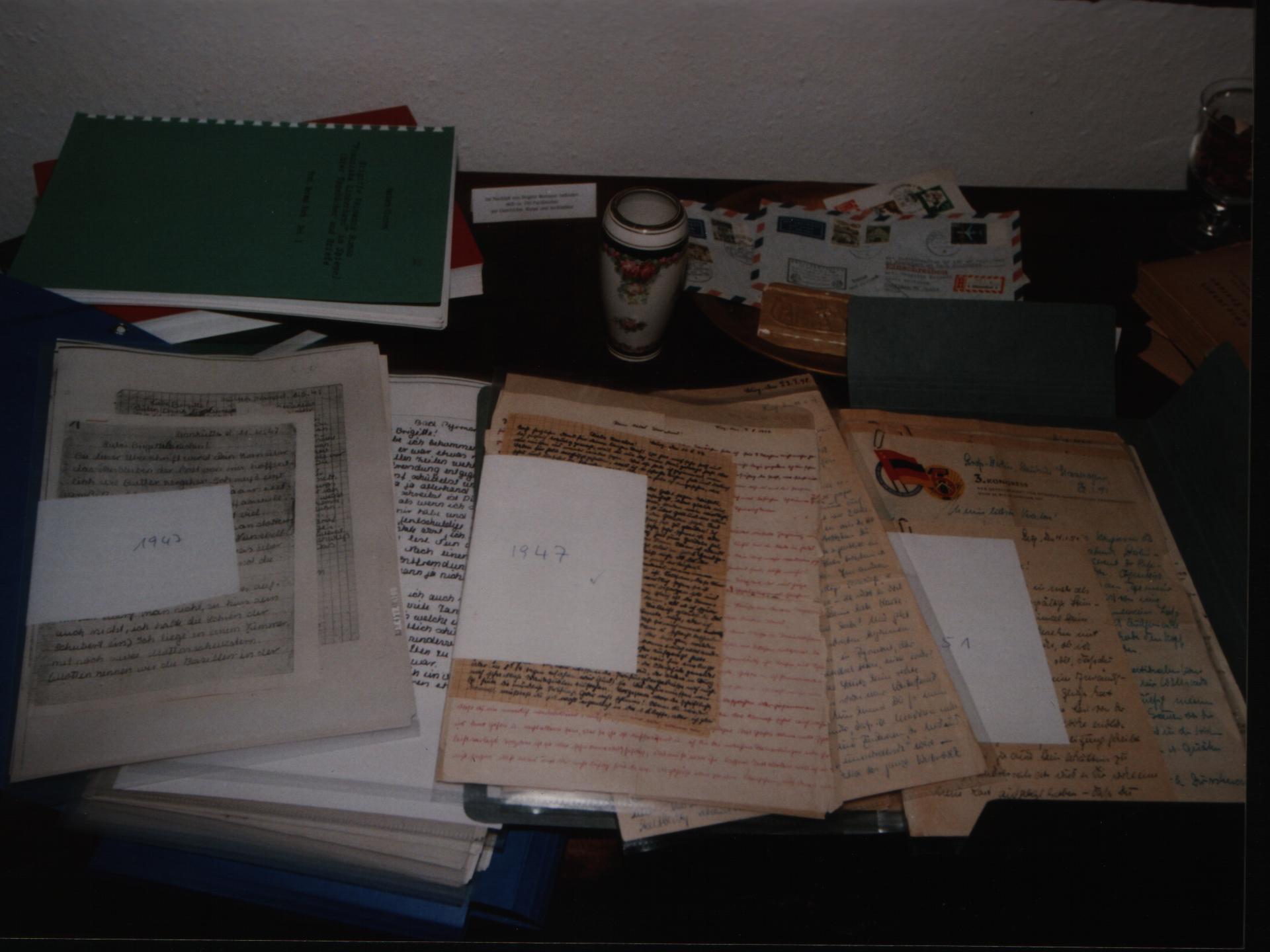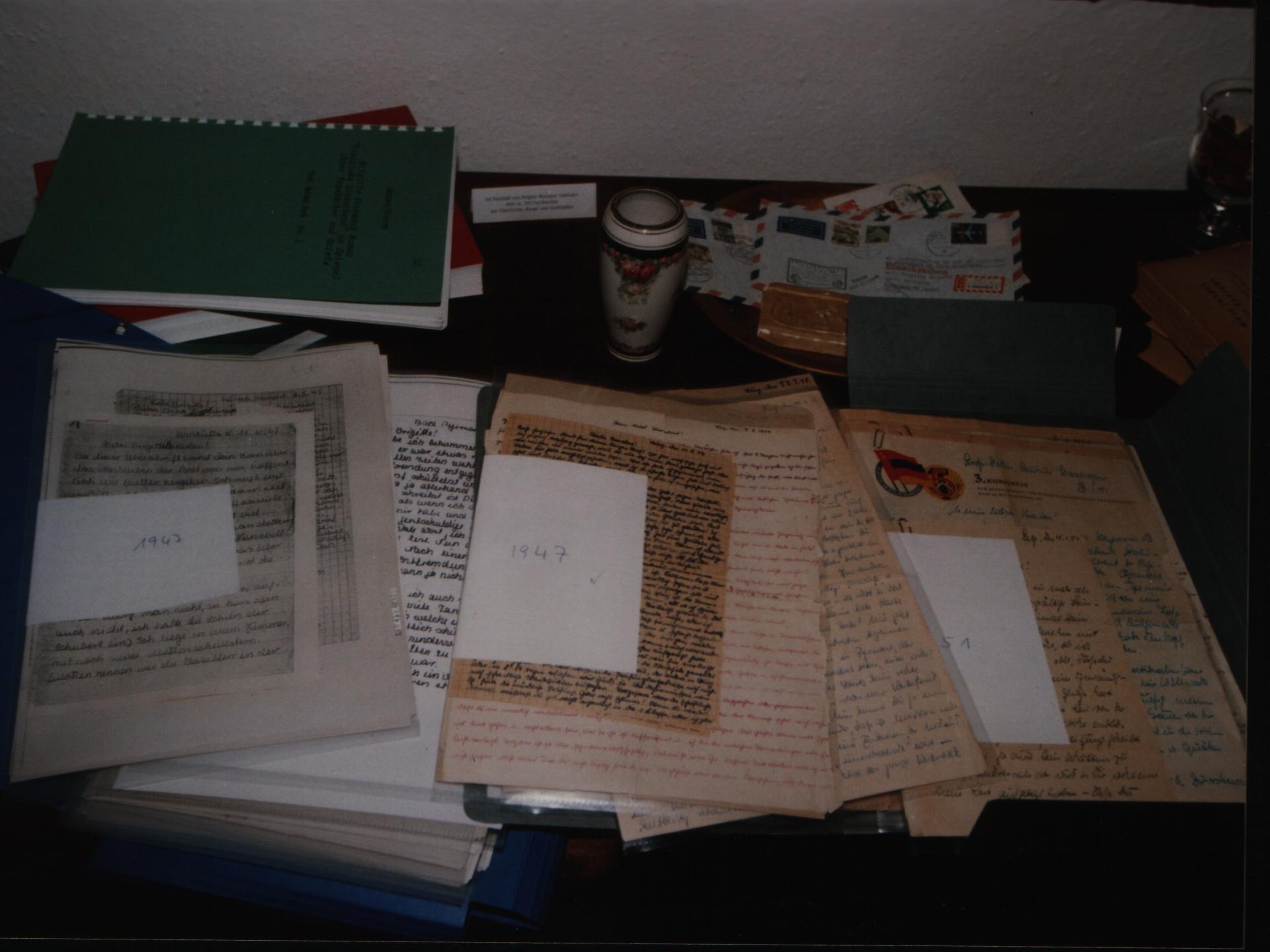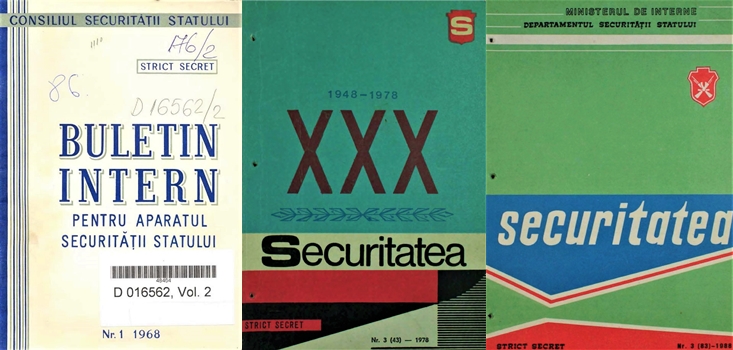

 About the relations of the Romanian citizens with some capitalist radio stations. In Securitatea, 41 (1978): 38-49, in Romanian. Article
About the relations of the Romanian citizens with some capitalist radio stations. In Securitatea, 41 (1978): 38-49, in Romanian. Article
Securitatea was a quarterly aimed at improving the training of Securitate operative personnel. Its articles were written by Securitate officers for Securitate officers and thus they touched upon practical problems faced during their specific mission of preventing and neutralising any actions that potentially threatened the communist regime. Among the many dangers that were outlined in the pages of the quarterly as undermining “state security” were foreign radio stations, and especially Radio Free Europe (RFE). The article chosen as a featured item of the collection presents under the title “Cu referire la relațiile cetățenilor români cu unele posturi de radio capitaliste” (About the relations of Romanian citizens with some capitalist radio stations) the perspective of the Securitate upon the activity of RFE and evaluates its contribution in providing an alternative source of information for Romanians. In the absence of underground publications, RFE represented the main source of alternative information in communist Romania. Thus, the Securitate regarded RFE and contacts between Romanian citizens and employees of the Romanian desk of this radio station as dangerous to the communist regime. Accordingly, the entire article focuses on revealing how RFE allegedly acts in order to undermine “state security.” Starting from the premise that RFE is the locus “of espionage, ideological diversion, and hostile propaganda,” the anonymous author traces the connection between this radio station and the American espionage machine, namely the CIA. The Central Intelligence Agency was credited with financing RFE and setting its agenda even after the American Congress officially took responsibility for financially supporting its functioning. The control of the CIA over RFE was underlined once again when discussing its organisation. The two management structures in the United States and Europe were allegedly infiltrated by CIA agents who engaged the radio station in their “ungentlemanly” war against communist countries and used it to collect information about them. As a result, the CIA used the microphone of RFE to proffer slanders and shamefully distort the realities of the communist countries, according to the Securitate’s interpretation of the broadcasting of news and other political programmes by this radio station. Even worse from the point of view of the Securitate was that people travelling abroad were an easy prey for “agents” working at the Romanian desk of RFE. After underlining the connection between its director, deputy director, and programme producers with the CIA, the article describes how they allegedly succeeded in manipulating Romanian tourists in order to collect valuable information about the country, its leadership, and the impact of its social and economic policies on the mood of the population. In other cases, they even managed to trick their “victims” and persuade them to emigrate. The narrative of blaming RFE for these “unpatriotic” deeds was an ideologically convenient explanation for the fact that the great majority of Romanians listened to and trusted RFE, in spite of the fact that this might have caused problems. At the same time, such a narrative was meant to highlight the vital role played by the Securitate as a guardian of the communist regime in Romania.
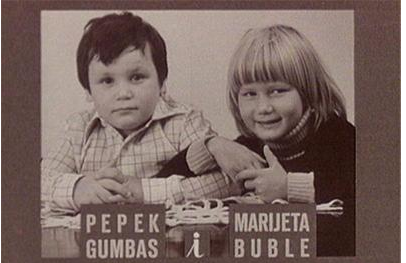

In the period from 1969 to the end of the 1970s, Nikša Fulgosi, as to do so in Yugoslavia, recorded a television series on sexuality for TV Zagreb (today HRT) under the title of Ljubavni jadi Pepeka Gumbasa i Marijete Buble [The Romantic Problems of Pepek Gumbas and Marijeta Buble]. The Monty Python-approach revealed "a master of common humour, avant-garde direction and promoter of liberal attitudes"; a filmmaker who – in times of "ideological eligibility" – mocked all manner of religious, political, and sexual hypocrisy. The provocative contents of the sketches showed women holding banners such as "We are being denied by kilometres of penises" and "Our right to be sexually exploited," along with a multitude of other "diversions," such as photographs of politicians who behave like sheep. According to sociologist Alexander Štulhofer, Fulgosi "used sex to criticize the bureaucratized political system" (Danko Volarić 2014).
Fulgosi shot and completed 13 episodes, of which only two were aired. Despite the end of the broadcast, Fulgosi continued to shoot new episodes (37 in total) which were also never aired. This unusual relationship between the creator and the "censor" illustrated the peculiarities of the Yugoslav socialist model, in which creative freedom was possible, but at the same time disproved as inadequate.
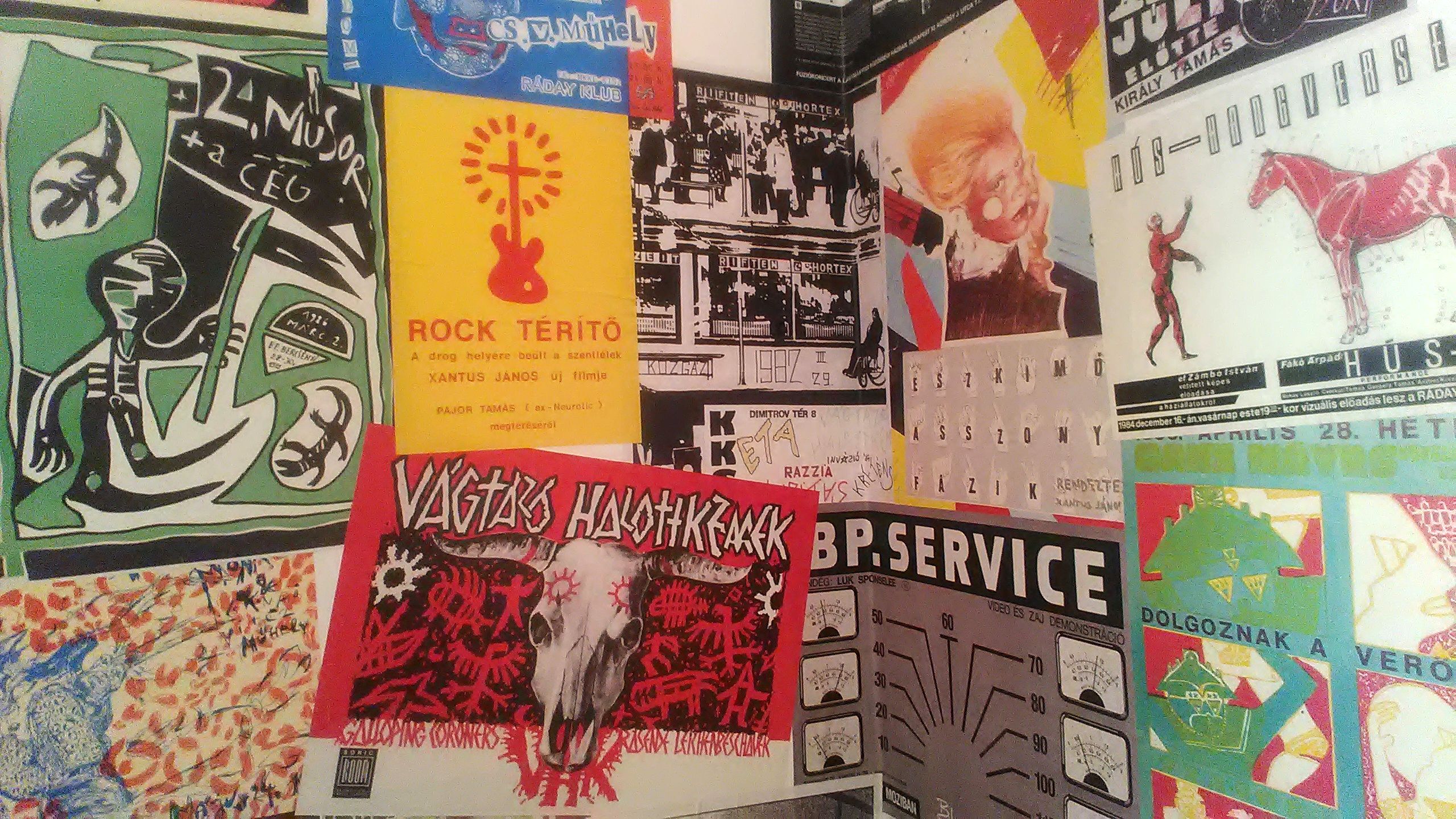

The video and audio library of the Literary Archive of the Museum of Czech Literature consists of audio and video recordings of Czech poets and writers from 1932 until 2013; the collection also covers the literary scene in Czechoslovakia before 1989, including the activities of unofficial or “banned” writers and artists and their work in exile. One important part of the collection are recordings made between 1990 and 2013 as part of the Authentic project, which focused on recording videos and audios from various spheres of the Czech literary scene.
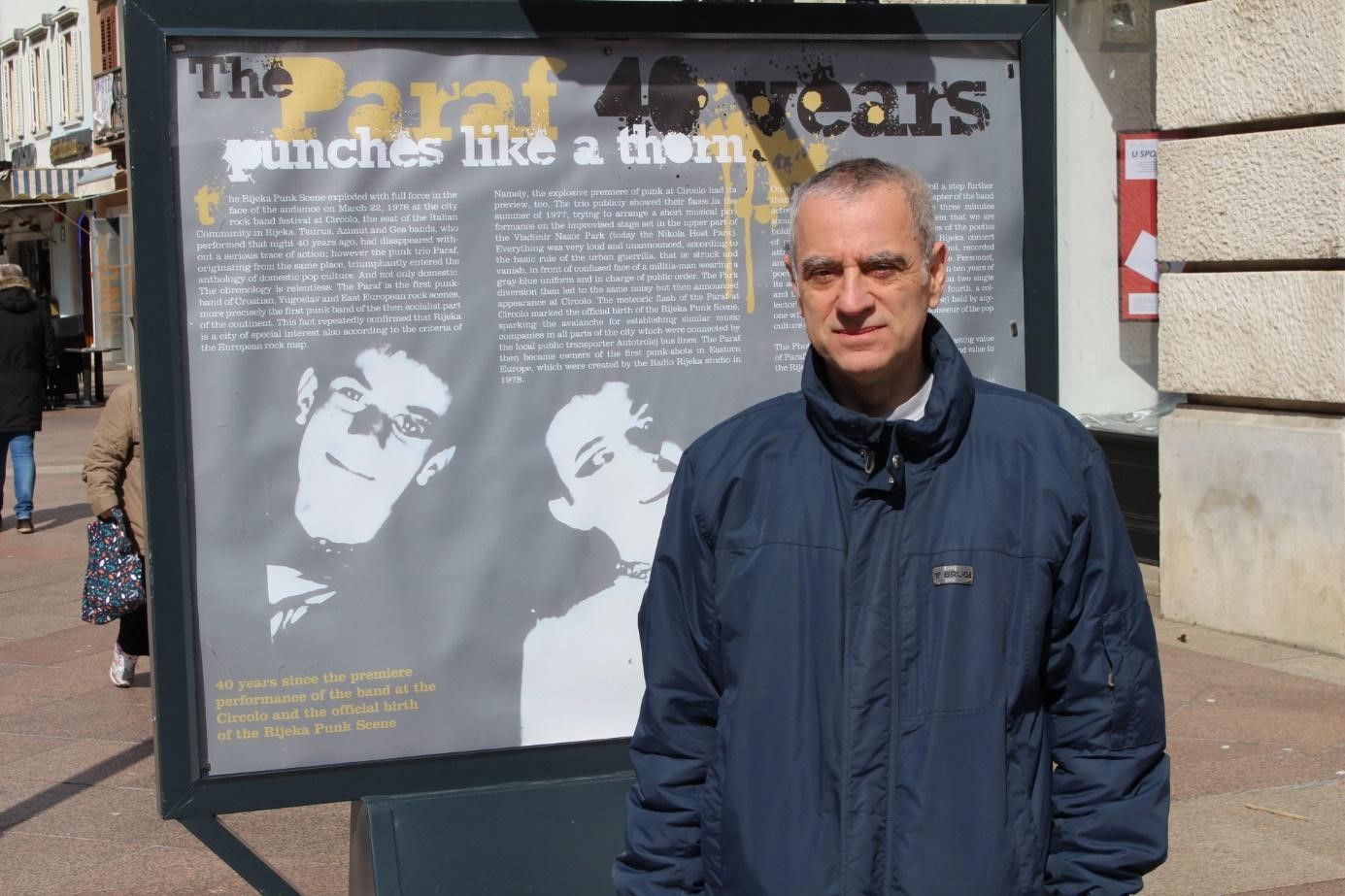

The Velid Đekić collection covers beginning of rock and disco culture not only in Rijeka but also in the former Yugoslavia. While working on the books 91 decibels (2009) and Red! River! Rock! (2013), Đekić collected materials on many of Rijeka's bands that have existed from the late 1950s until the early 1980s, and on the places where young people gathered. That is why this collection testifies to the unique history of rock 'n' roll behind the Iron Curtain.
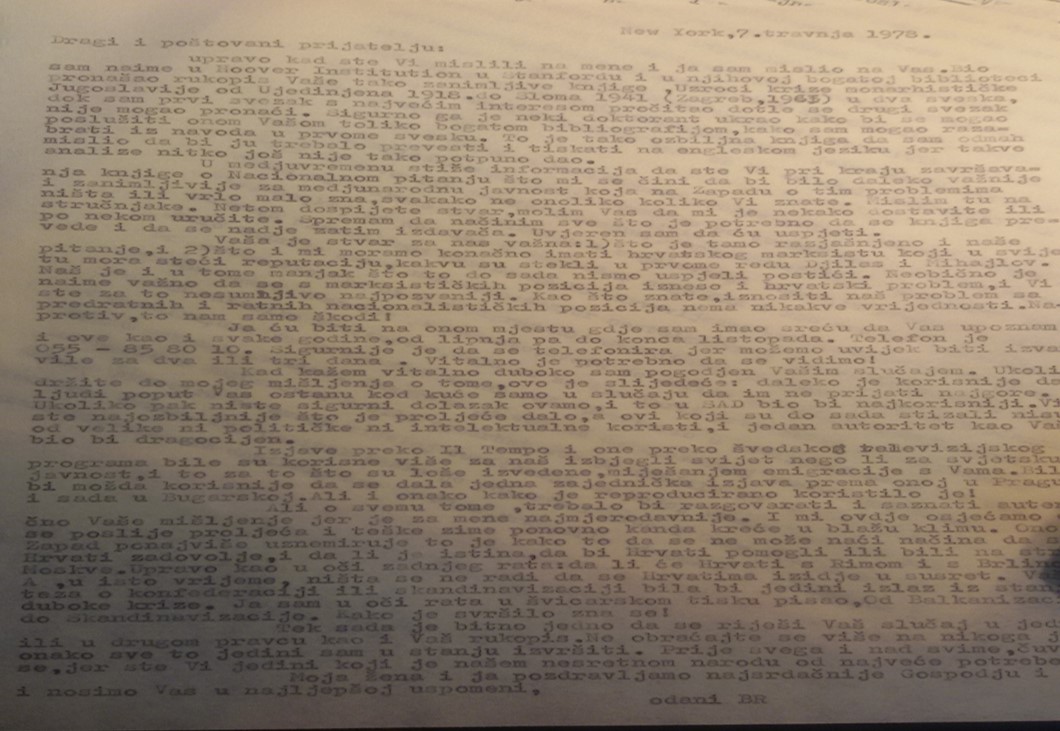


The Bogdan Radica’s letter to Franjo Tuđman is an example of his correspondence covering the period from the 1960s to the late 1980s. Their corresponding was very difficult, so Tuđman sent the letters to Radica in the USA through a confidant-intermediary. Radica first communicated Tuđman that he had to go to the Hoover Institute at Stanford University to read his book Uzroci krize monarhističke Jugoslavije od ujedinjenja do sloma (Causes of the Monarchist Yugoslavia Crisis - From Unification to Breakdown) (Zagreb: doctoral thesis, 1965) printed in two volumes in 1965. He wanted the book to be published in English. In his opinion, as a Croatian Marxist, Tuđman was to assume the role that Đilas and Mihajlov had prior to him. According to Radica, the importance of Tuđman's dissident work is that he pays attention to the question of Croatian statehood. Due to the need for secrecy, without mentioning the place of his summer residence (close to Ulivello, a village in Toscana, Italy where Radica spent his summer months), Radica informed Tuđman where they were to clandestinely meet. The letter is a testimony to the secrecy of their meetings. In the same letter, Radica was interested in Tuđman’s interviews by the European media such as the Italian newspaper Il tempo (The Time) and the Swedish National Television. They also discussed the possibility of translating Tuđman’s book National question in contemporary Europe and publish it in English so the world knows about the issue of endeavours in establishing Croatian statehood under the Yugoslav communist dictatorship. Radica asked a publishing house in New York to print Tuđman’s book. The publishing house was Harcourt, Brace, Jovanovich, whose owner was William Jovanovich, an American businessman with Serbian origins. All of Milovan Đilas’ books were published in English by the Harcourt, Brace, Jovanovich publishing house. However, in the end, Jovanovich rejected Radica's suggestion and his publishing house never printed the book.
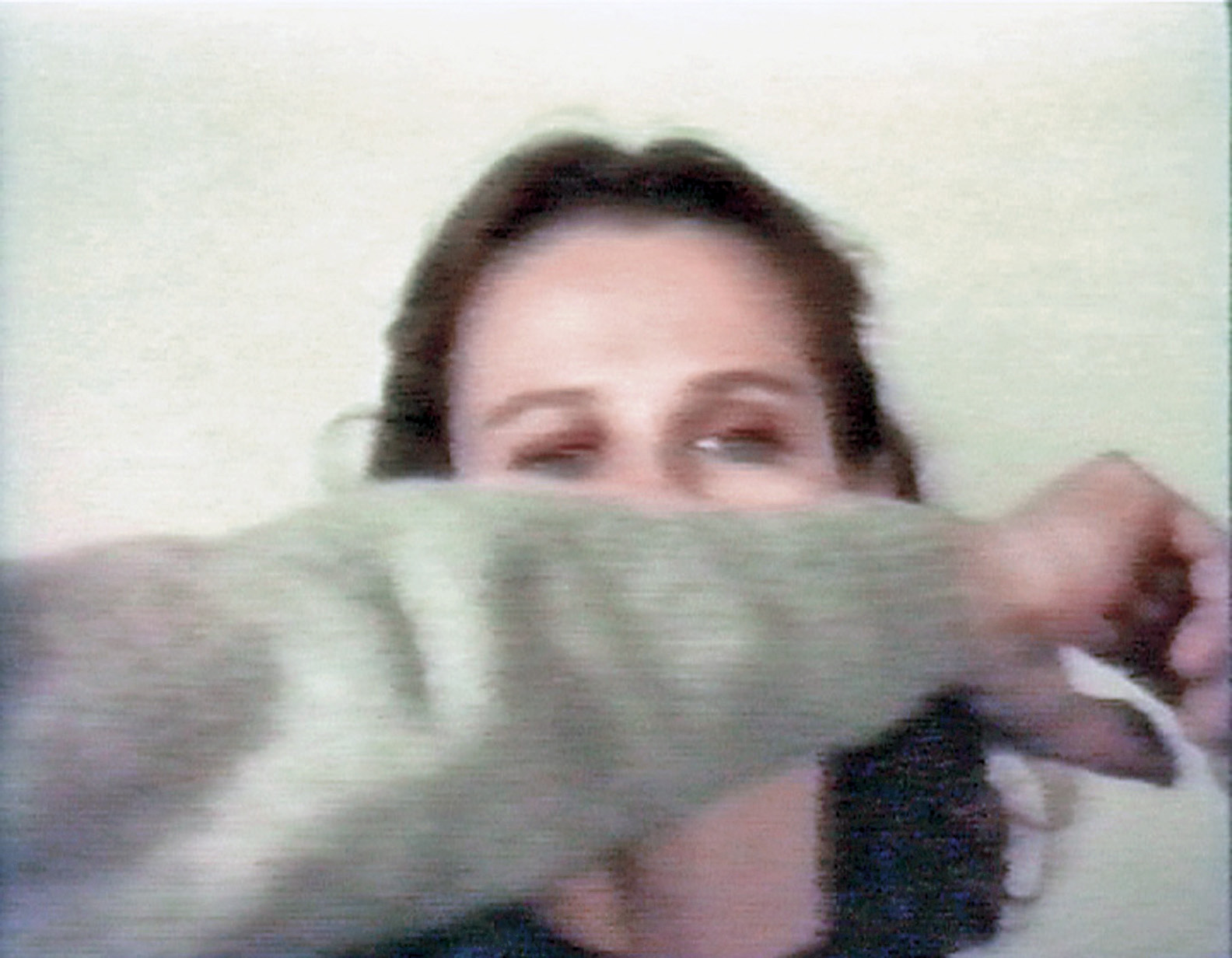

The work is a video recording of one of a series of performances entitled ‘Was ist Kunst?’ (What is Art?) conducted by Todosijević between 1976 and 1981 in various cities, situations and surroundings. In each performance, the artist addresses a female model, repeating the same question in German: ‘Was ist Kunst?’ The artist’s raised voice is commanding and recalls repressive techniques of police interrogation, evoking the traumatic experience of those members of the Yugoslav public who at that time still remembered scenes of Gestapo torture and the brutality of German occupation in the Second World War. The artist repeats the same question until he reaches a point of total exhaustion and loses his voice. The passive female model stoically enduring the torture triggers associations with the passive and masochistic attitude of citizens in a totalitarian order who lose their will, thus aiding the unimpeded operation of the repressive apparatus. This kind of aggressive behaviour and provocation of the public appears in other works by the artist. ‘Was ist Kunst?’ is an emblematic work by Raša Todosijević and at the same time represents one of the most significant works of Serbian art in the twentieth century.
“The performances entitled ‘Was ist Kunst?’ are political performances in the broadest sense of the word. Not art in the service of politics but rather art that sublimates the social performance into an artistic performance, emphasising in that sublimation some of the characteristics of social occurrences, the phenomenon of mass psychology, of the demagogy of language, of continual repetition – through cathartic emphasis.” (Published in 'New Art in Serbia 1970–1980’, Museum of Contemporary Art, 1983). The work ‘Was ist Kunst, Marinela Koželj?’ was purchased and integrated into the Museum’s Collection of New Art Media in 1988.
The private archives of Ferenc Kálmándy contain the documents of his photo oeuvre since 1978. His photographs document transformations in Hungarian youth culture, underground pop, and intellectual art scene and also the integration of the visual aesthetics of punk, new wave, and post-avantgarde into everyday life.
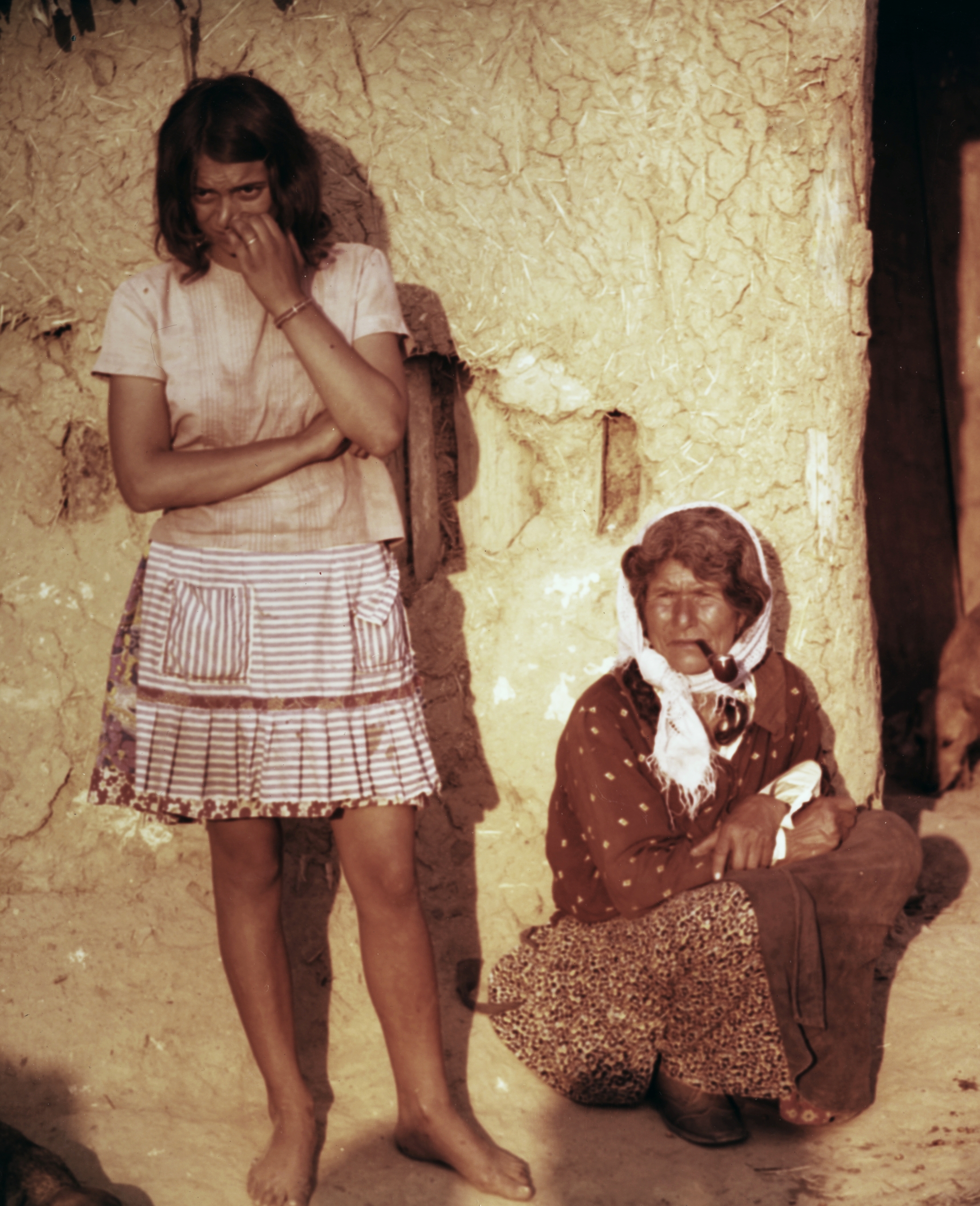
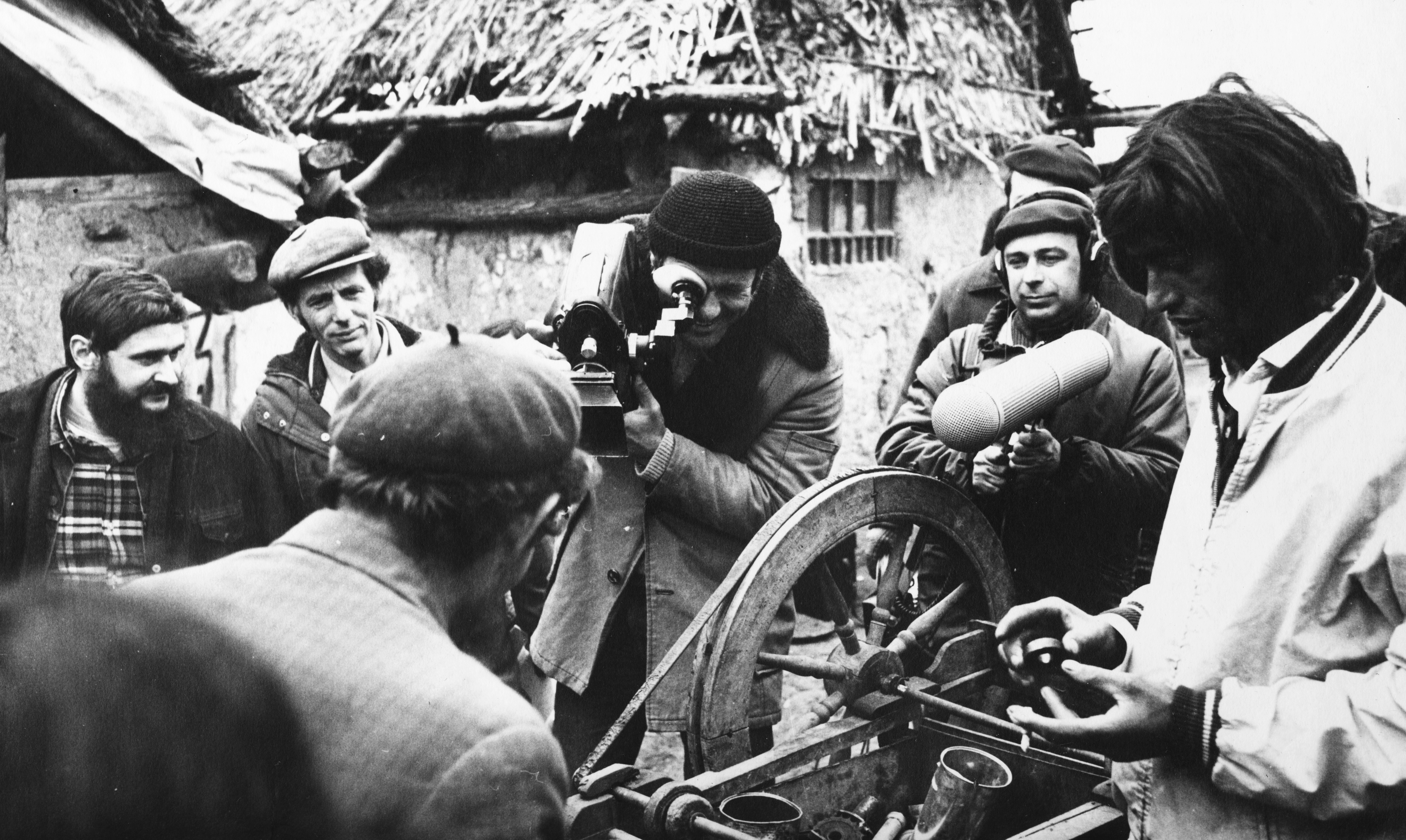

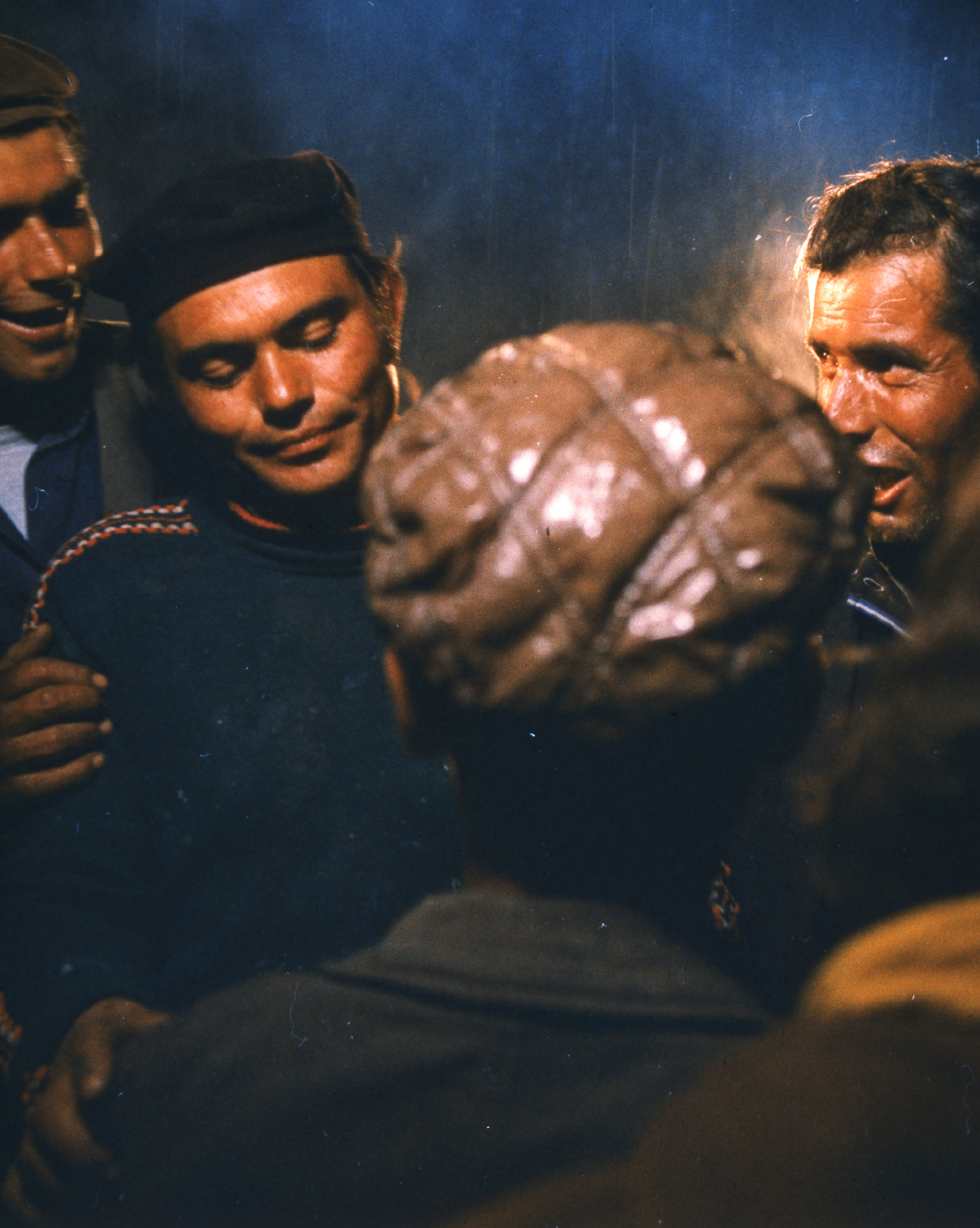

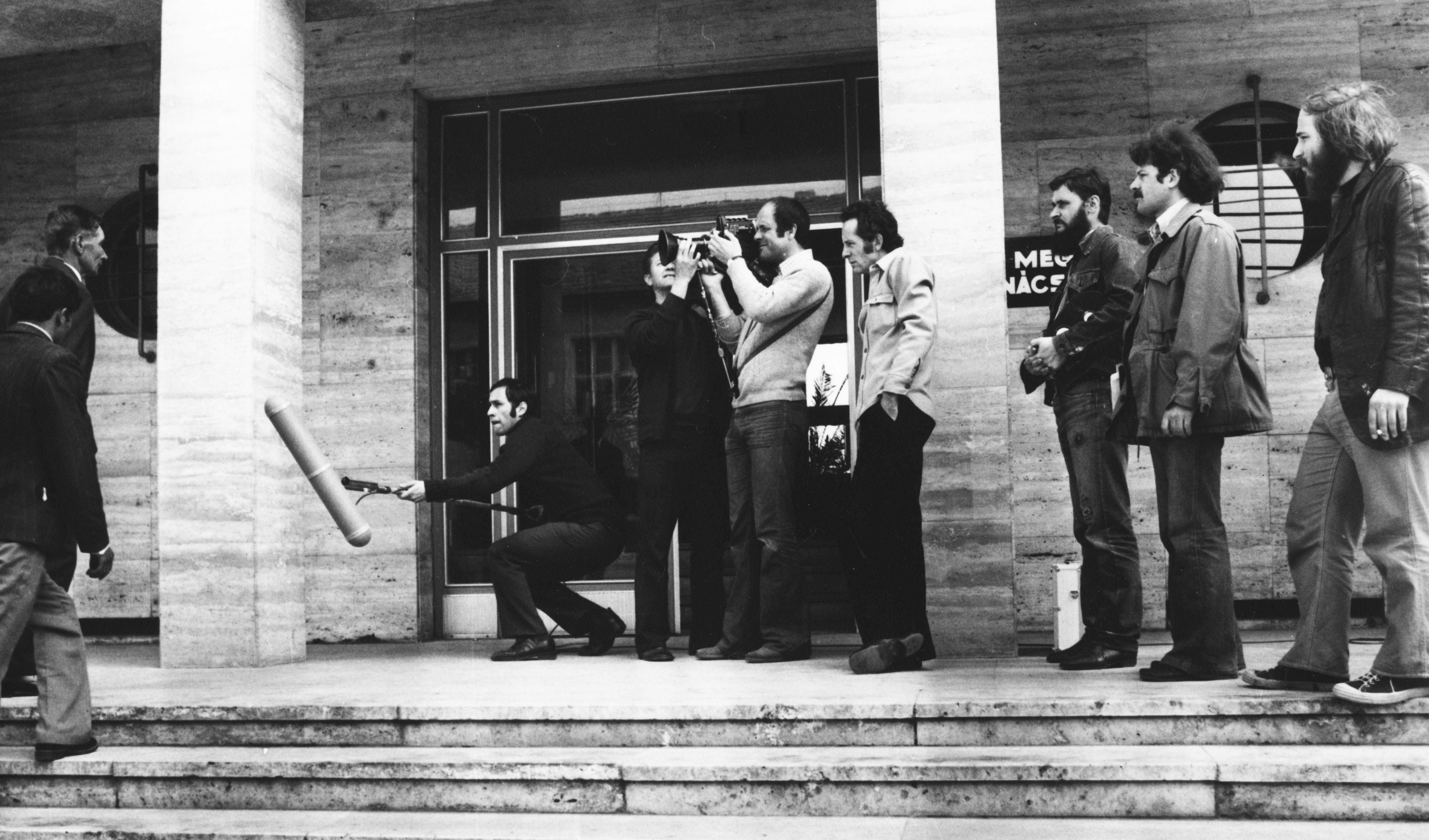

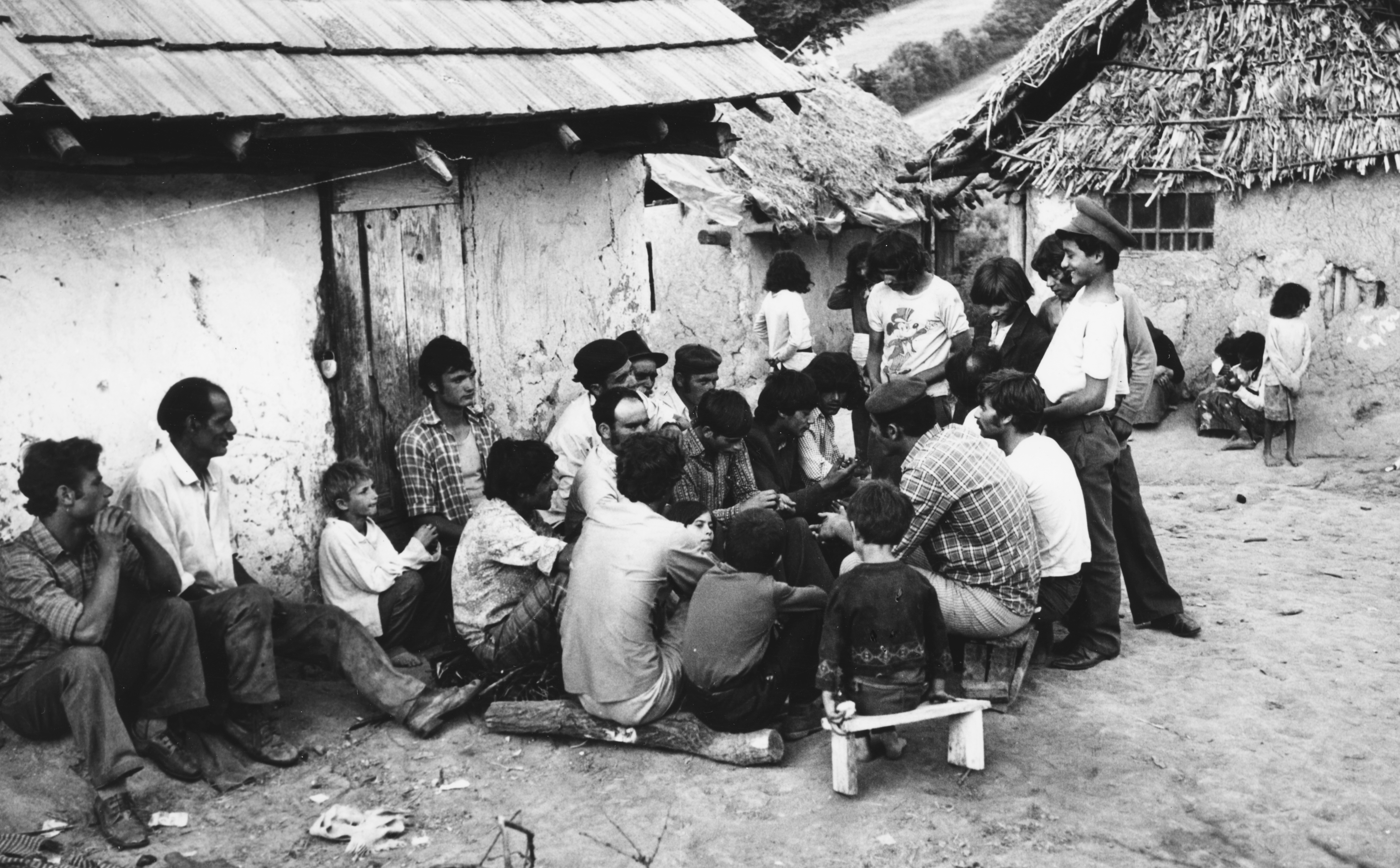

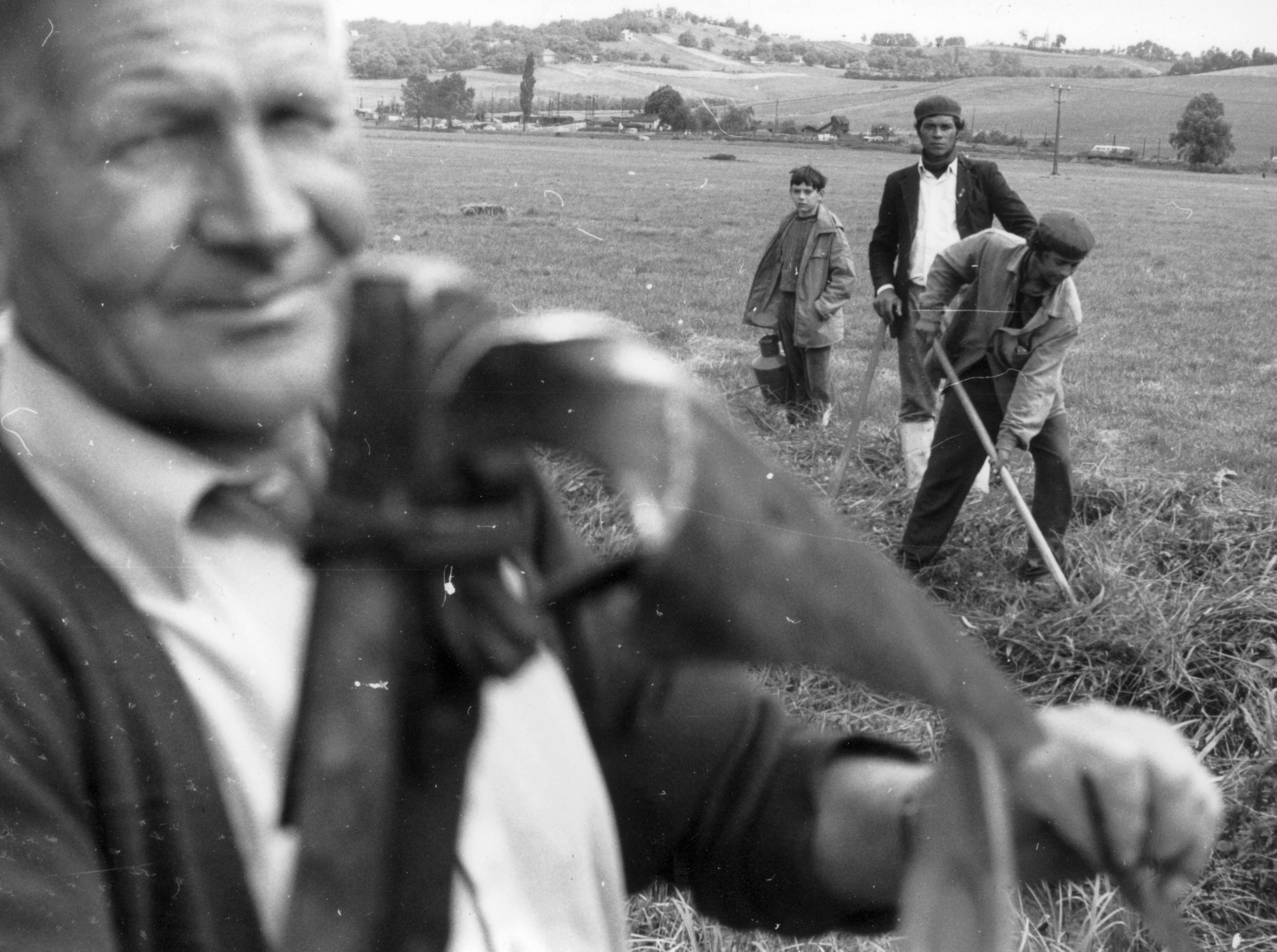

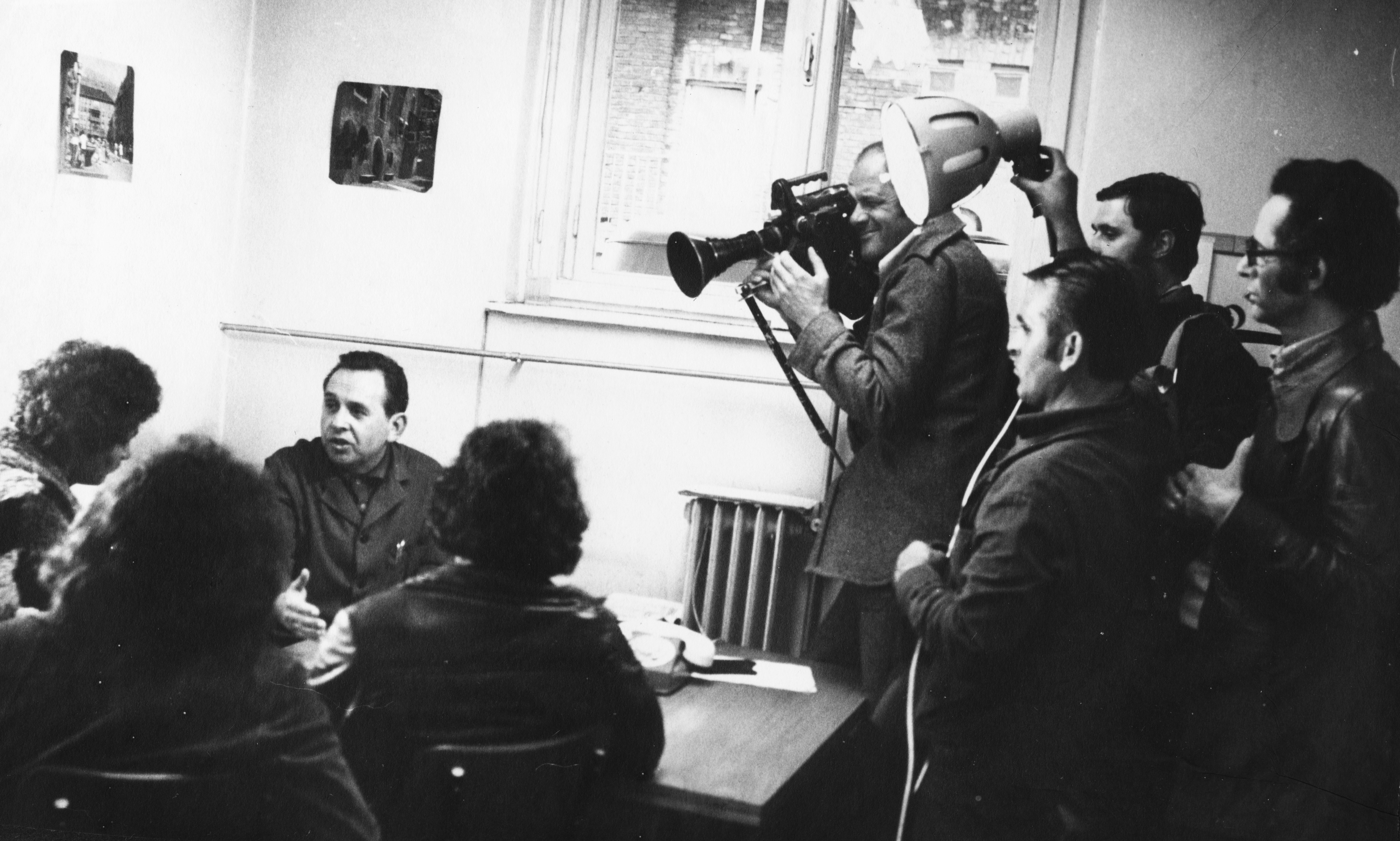

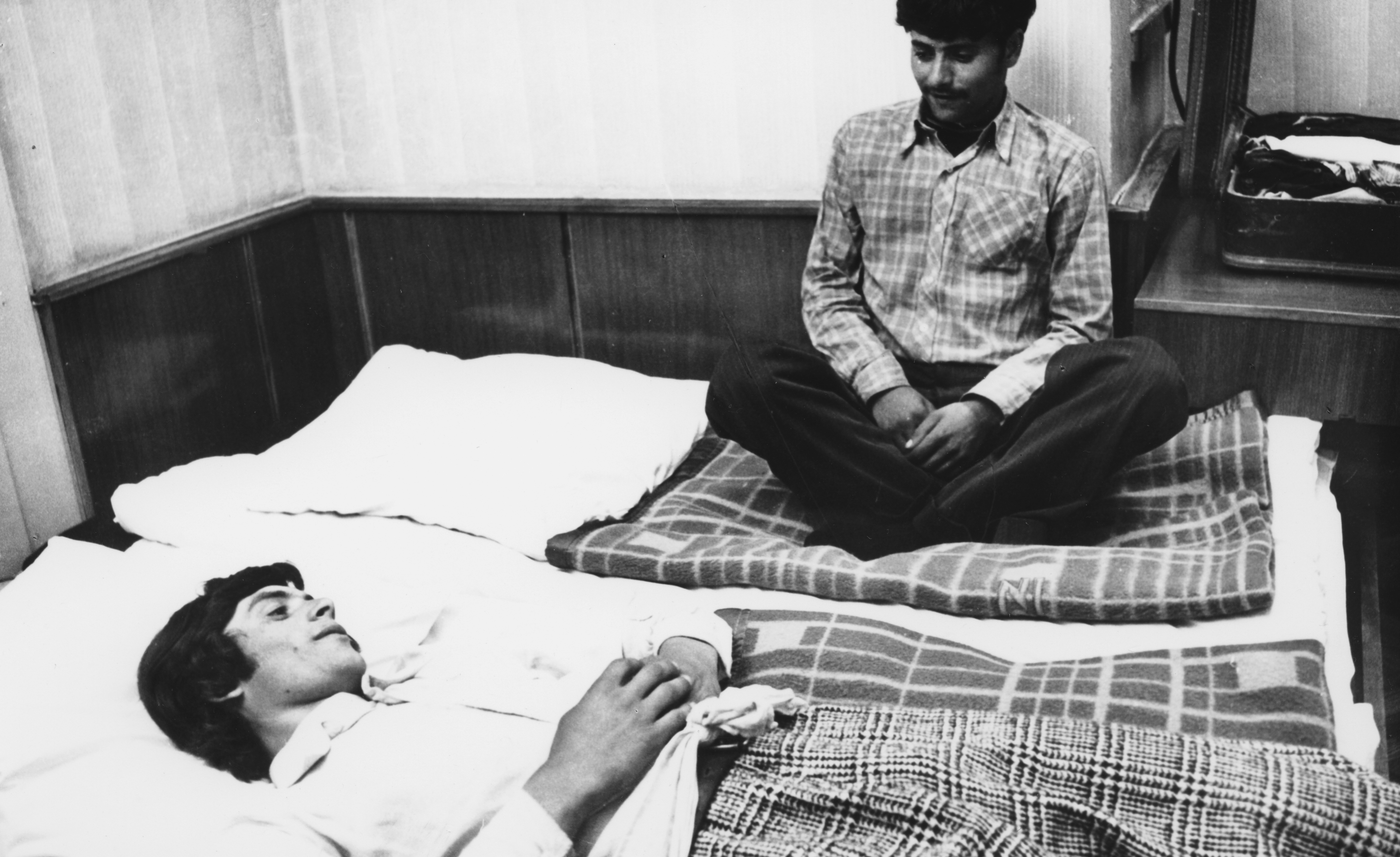

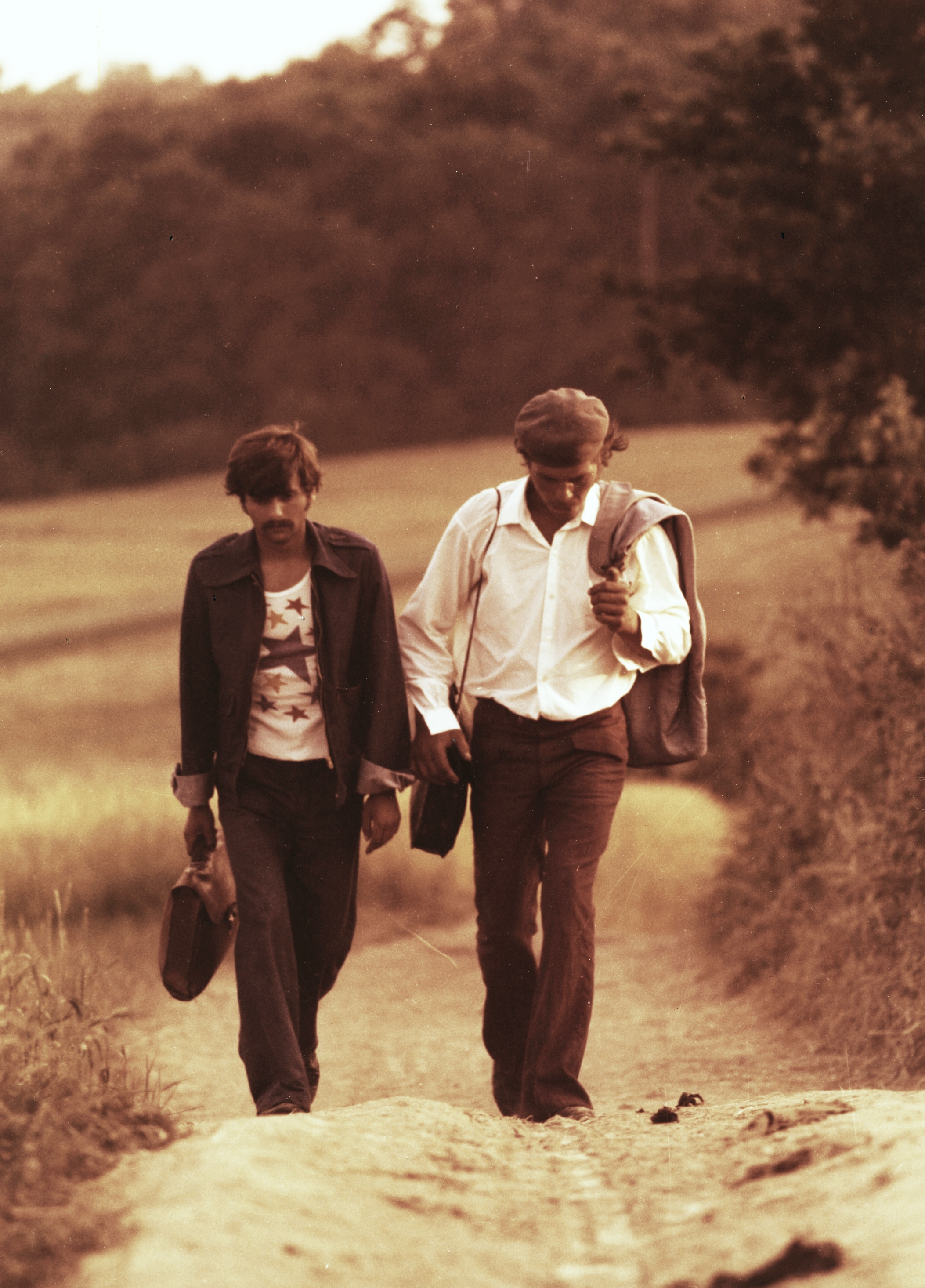

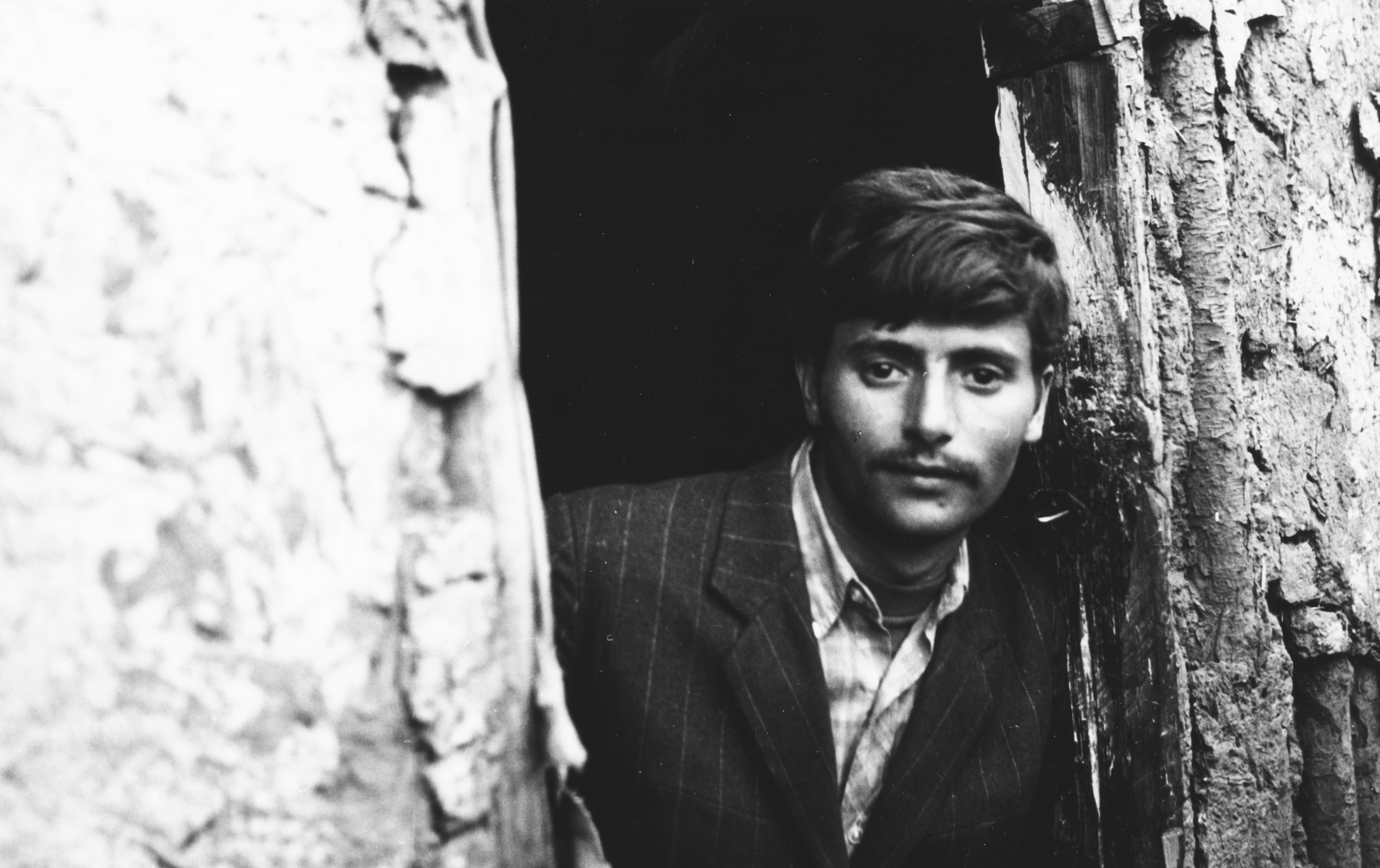

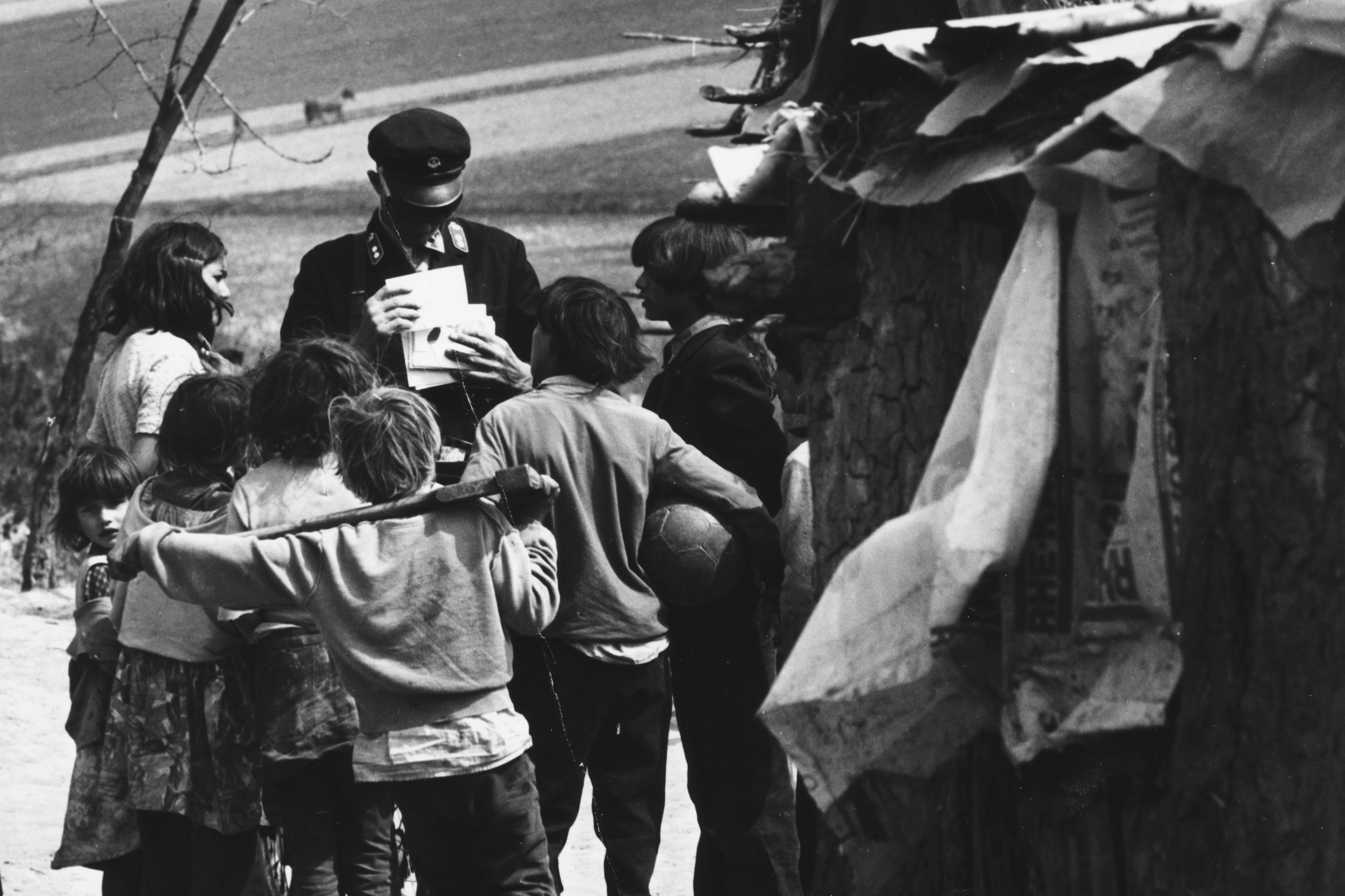

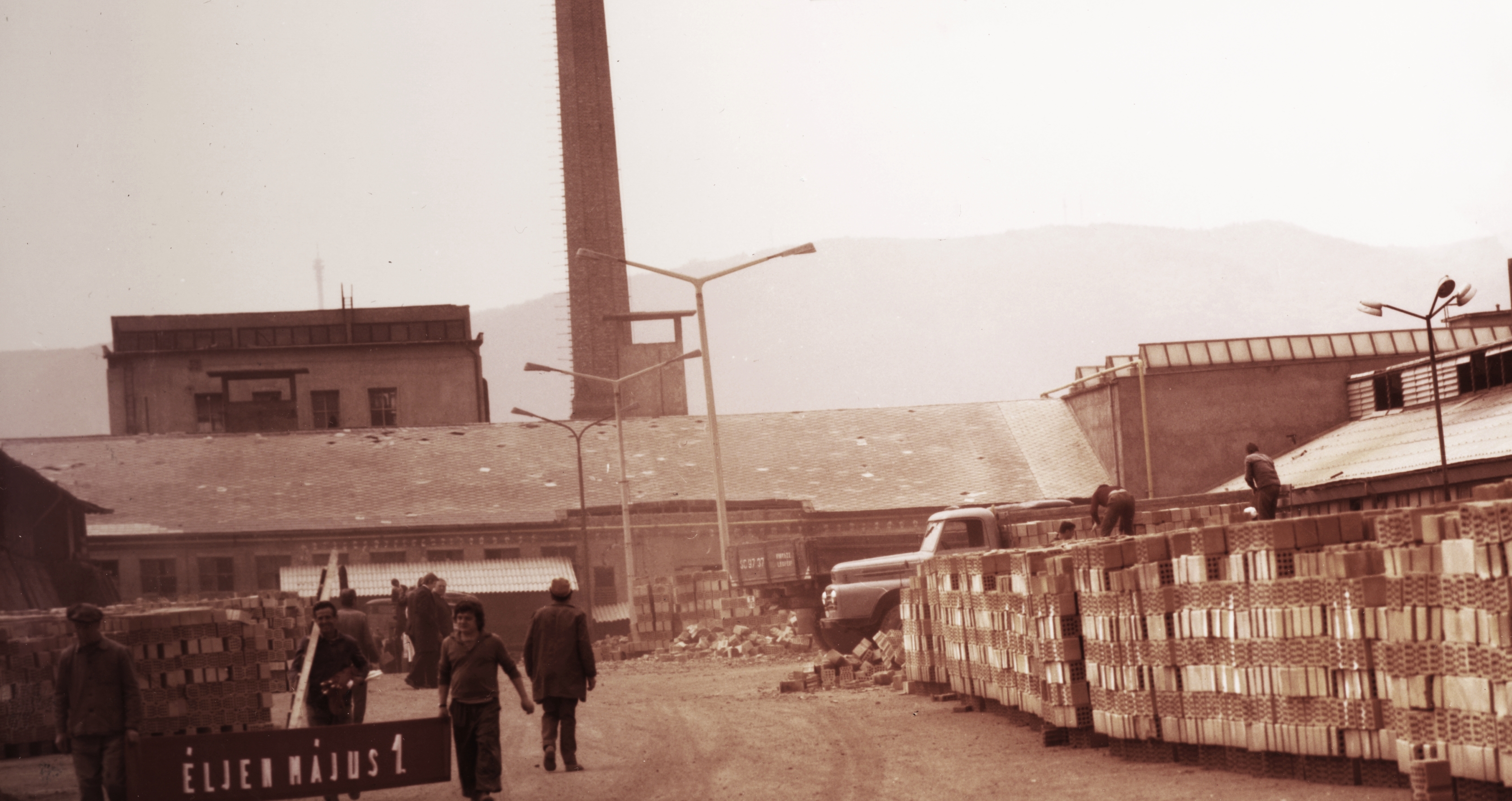

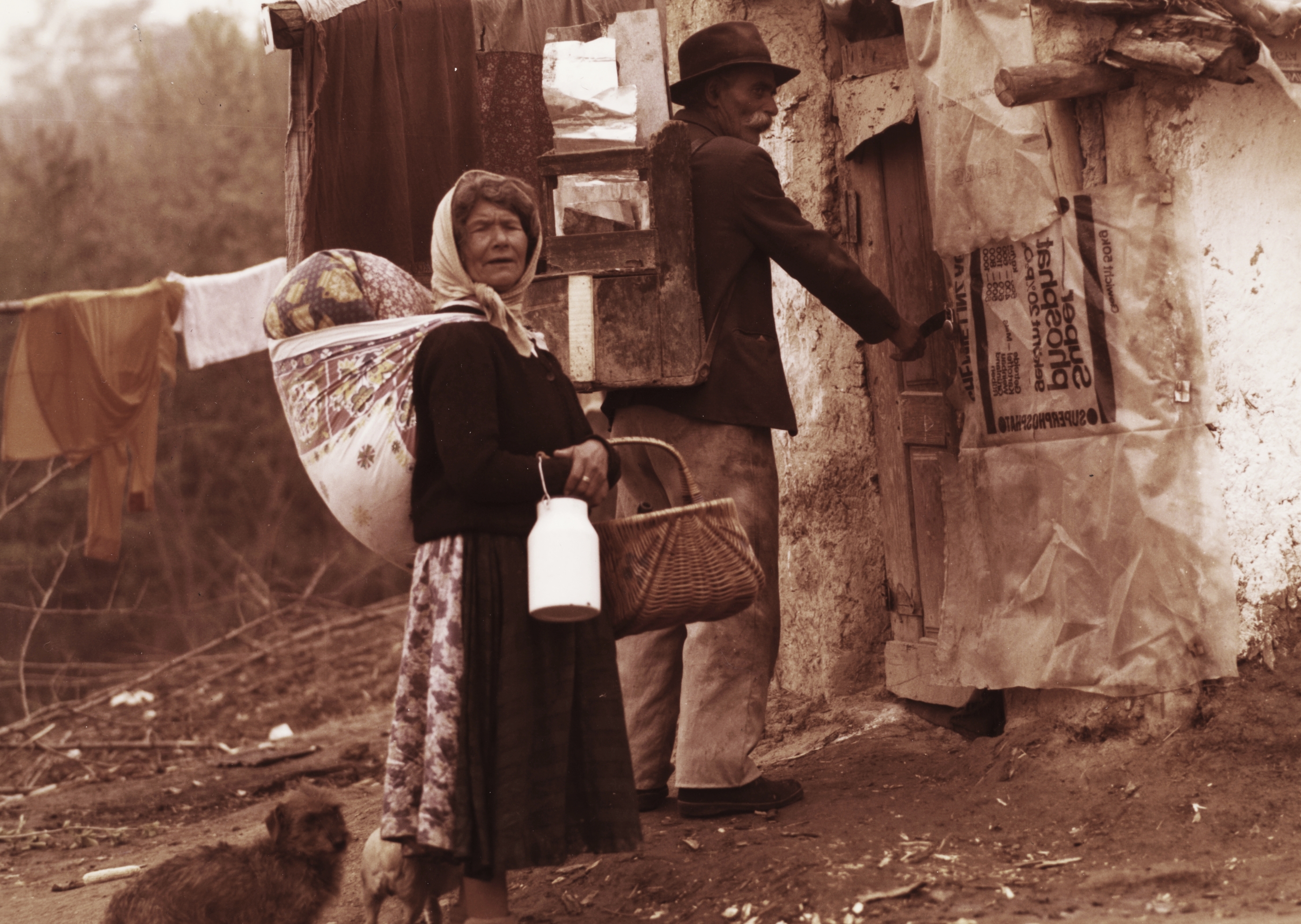



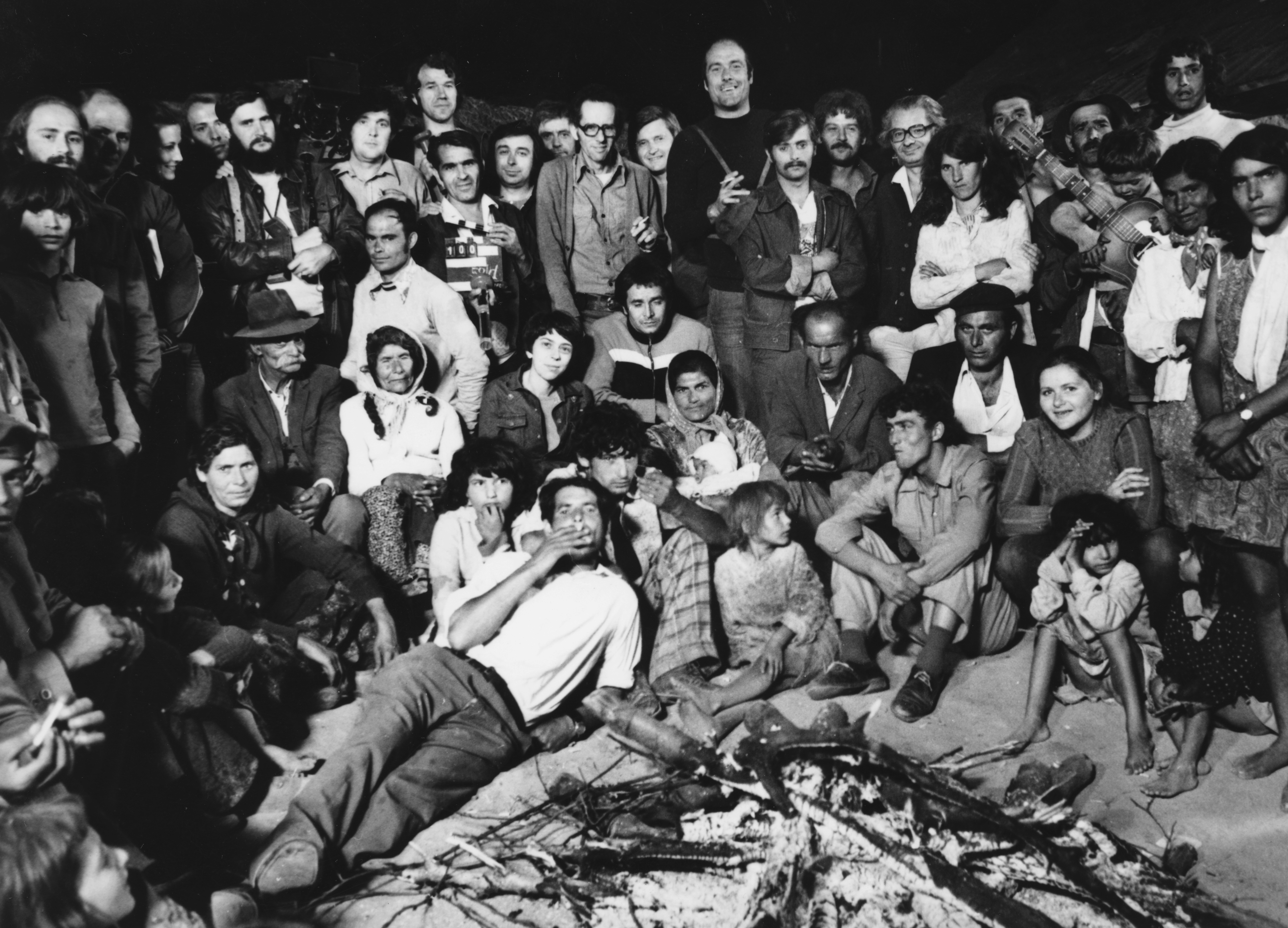

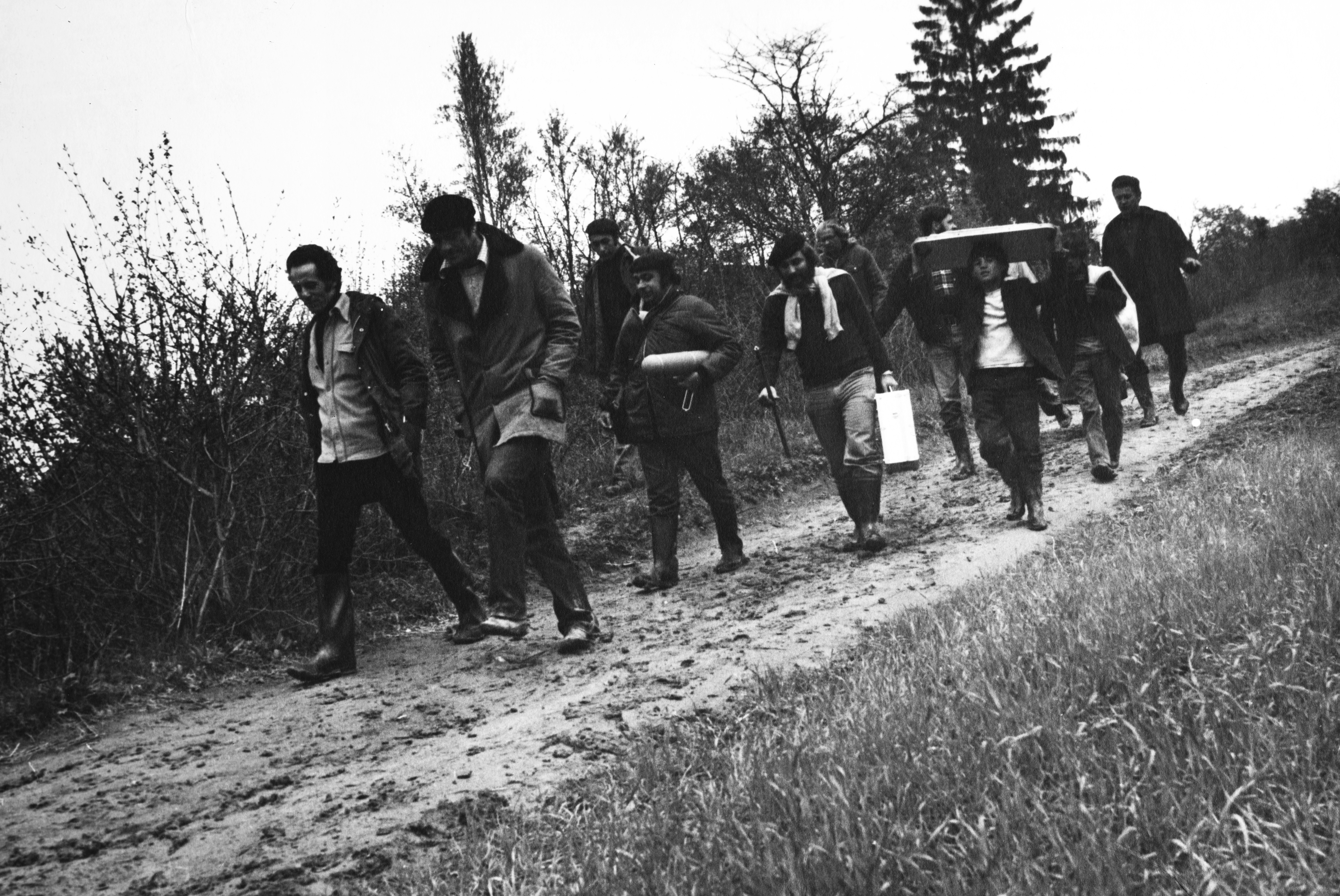

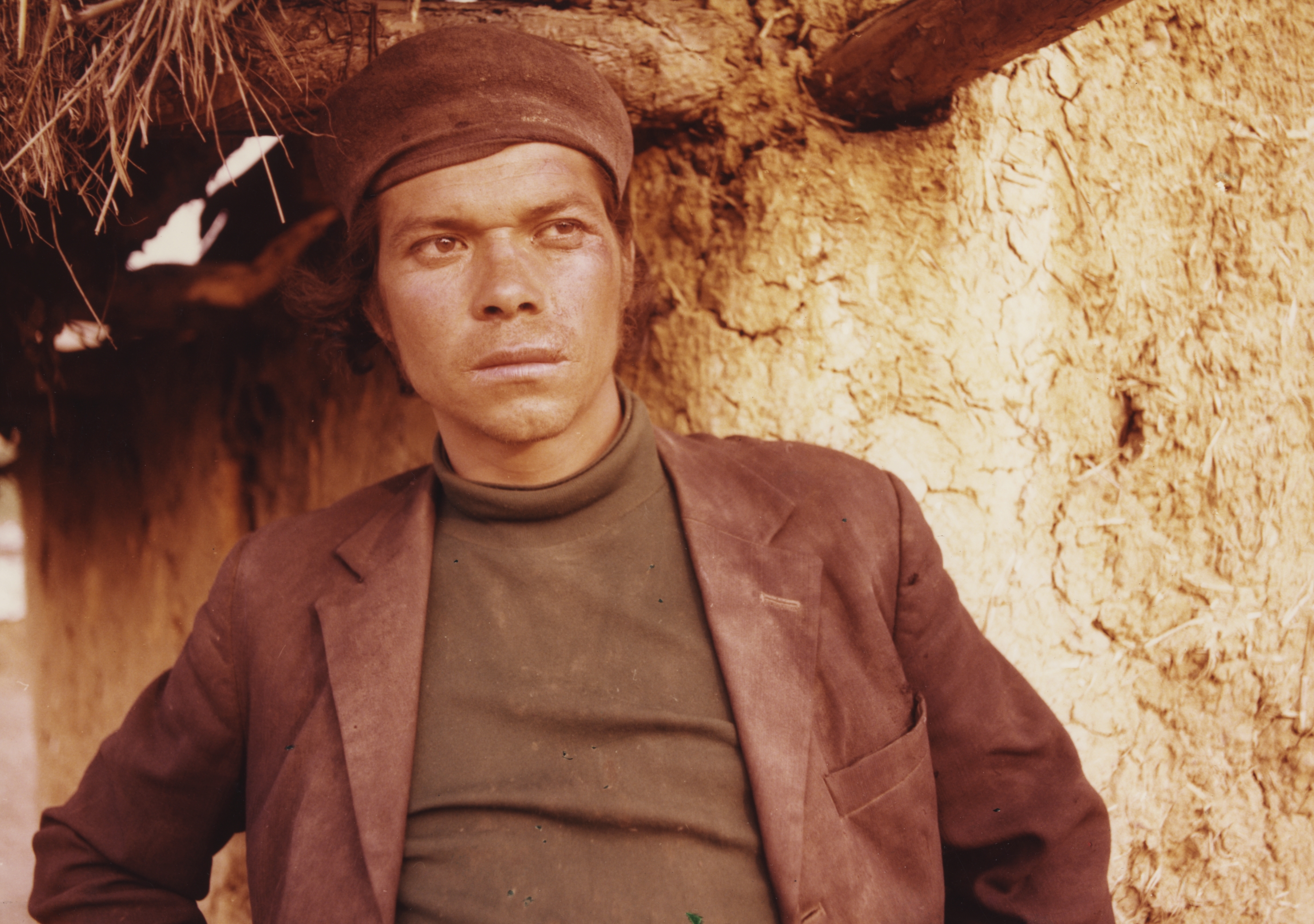

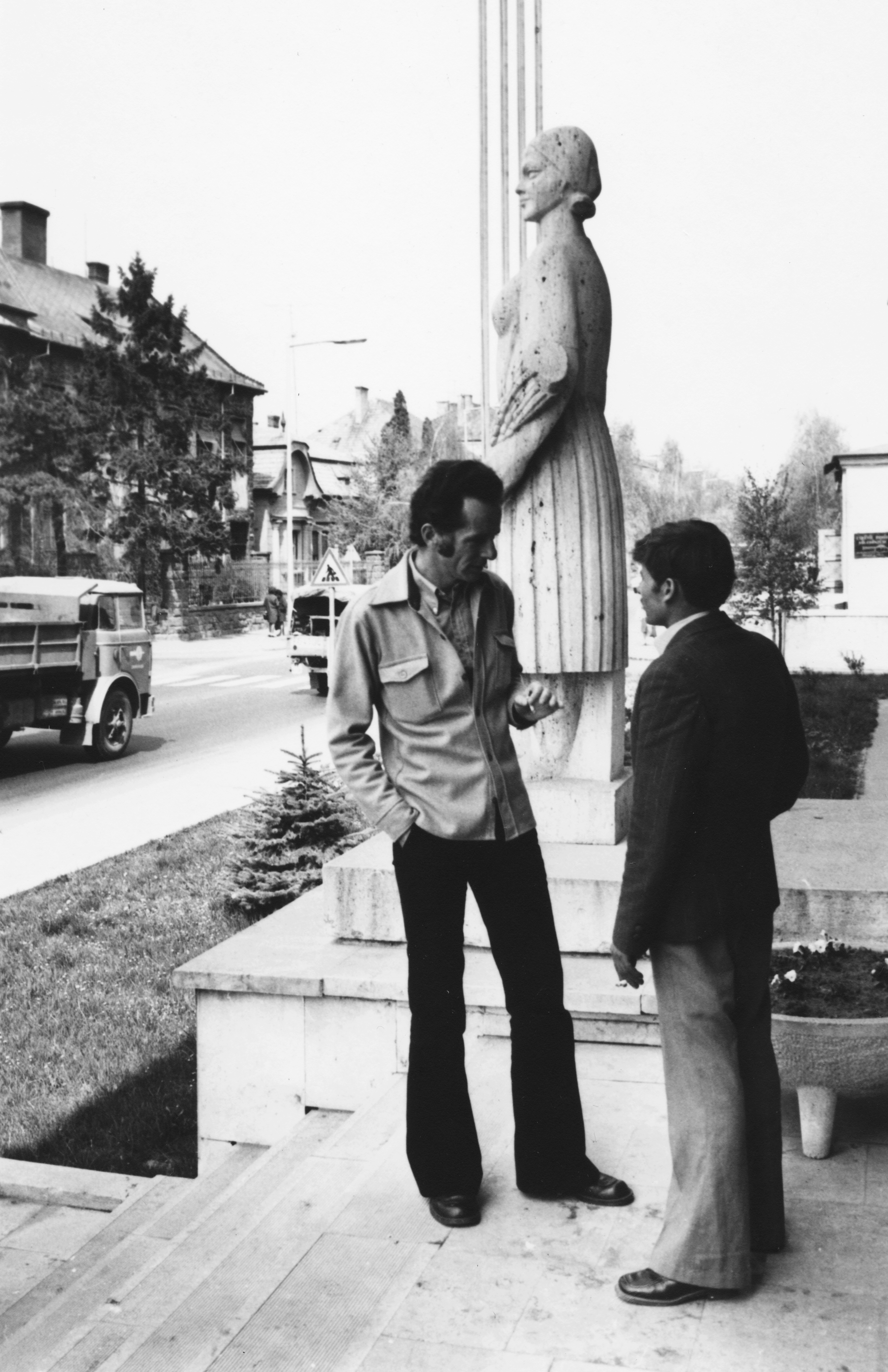

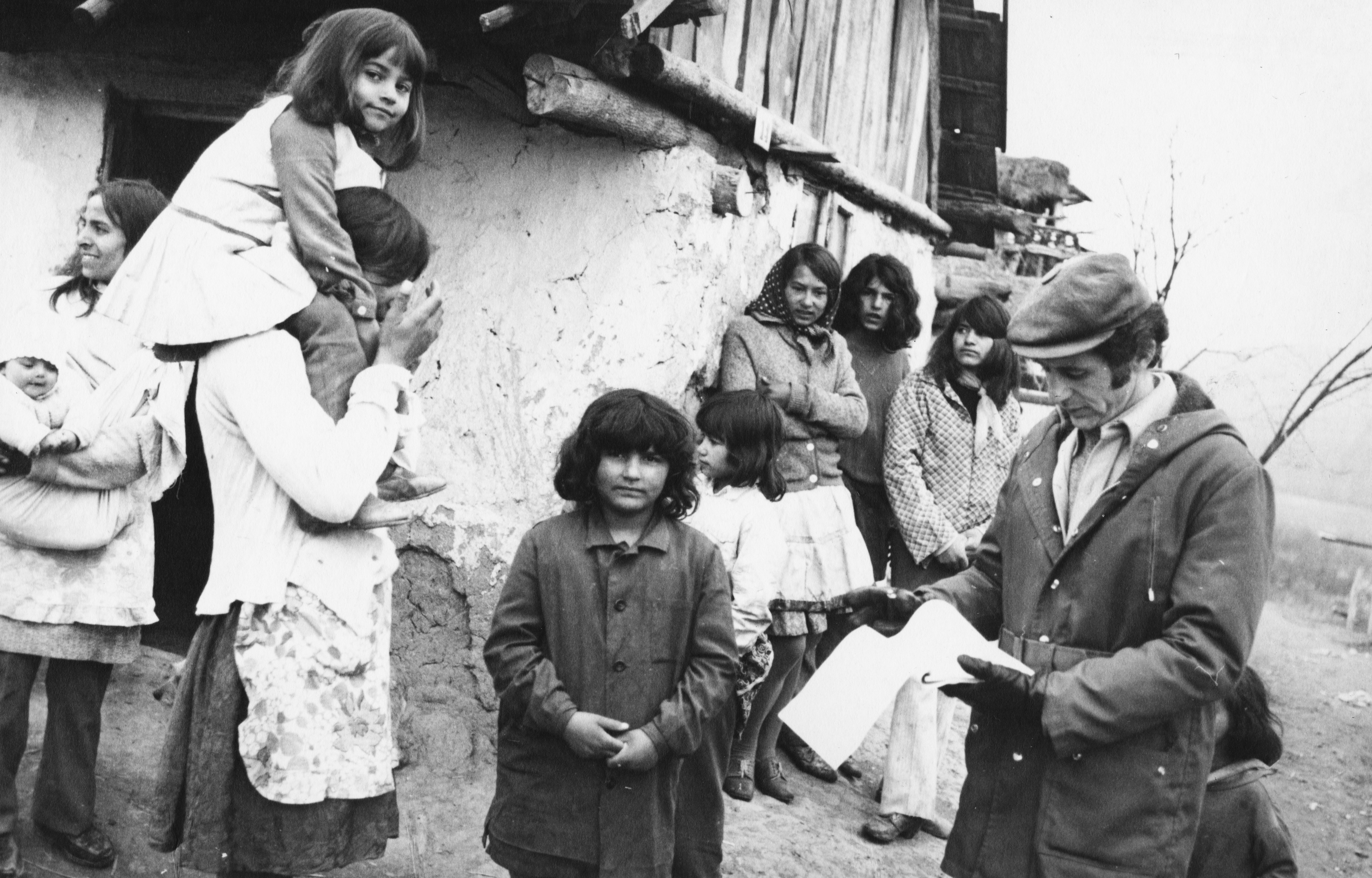


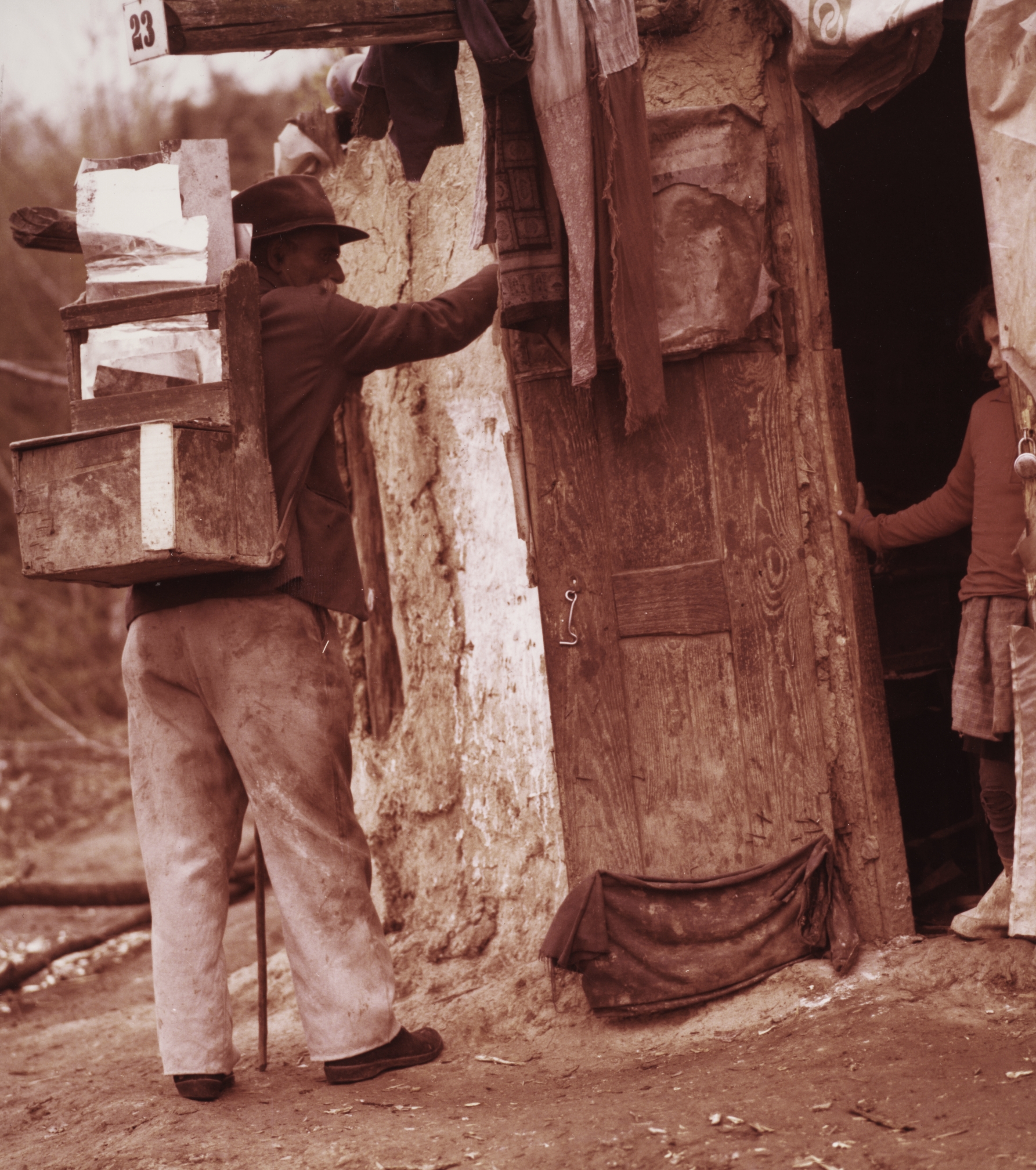
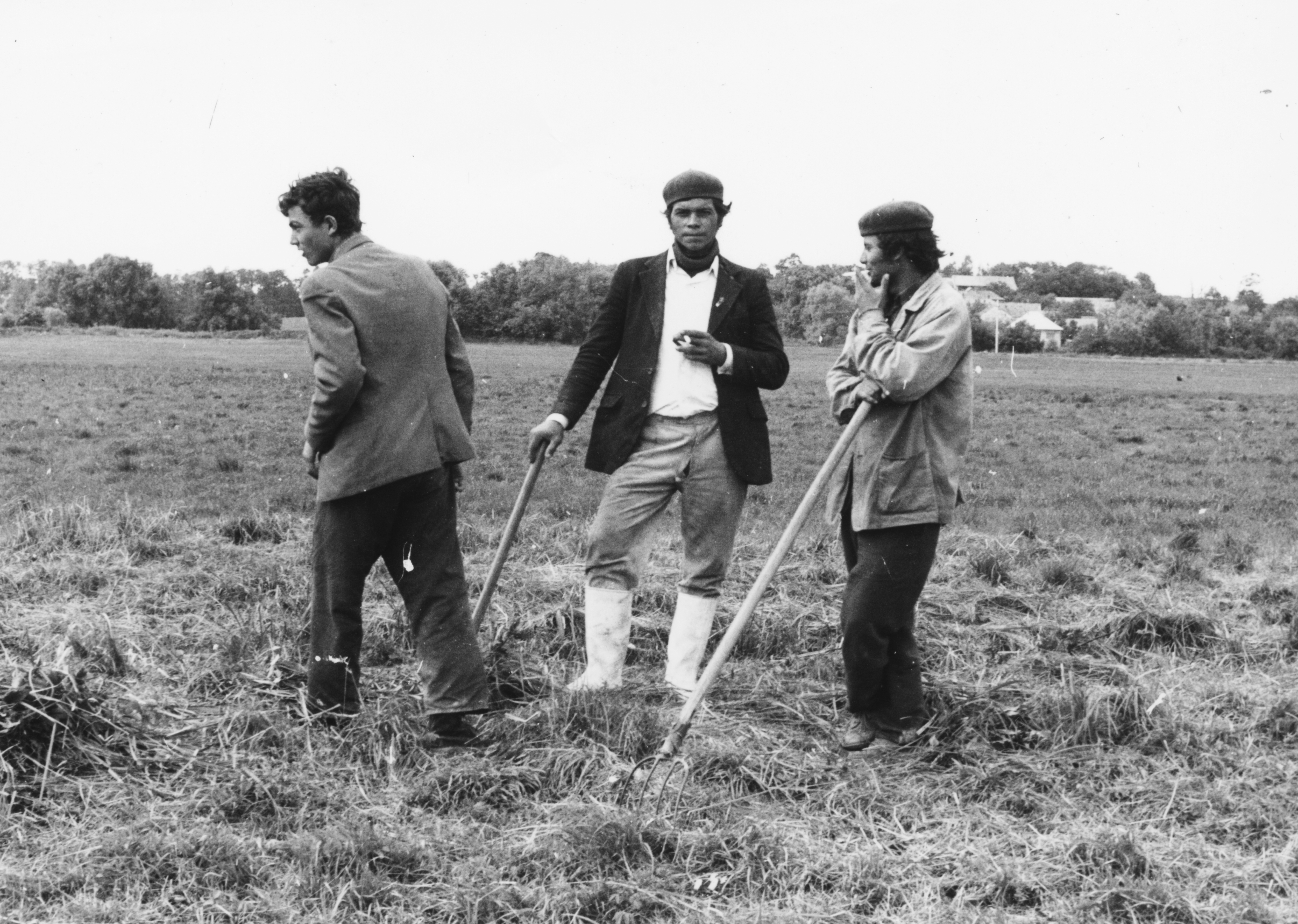

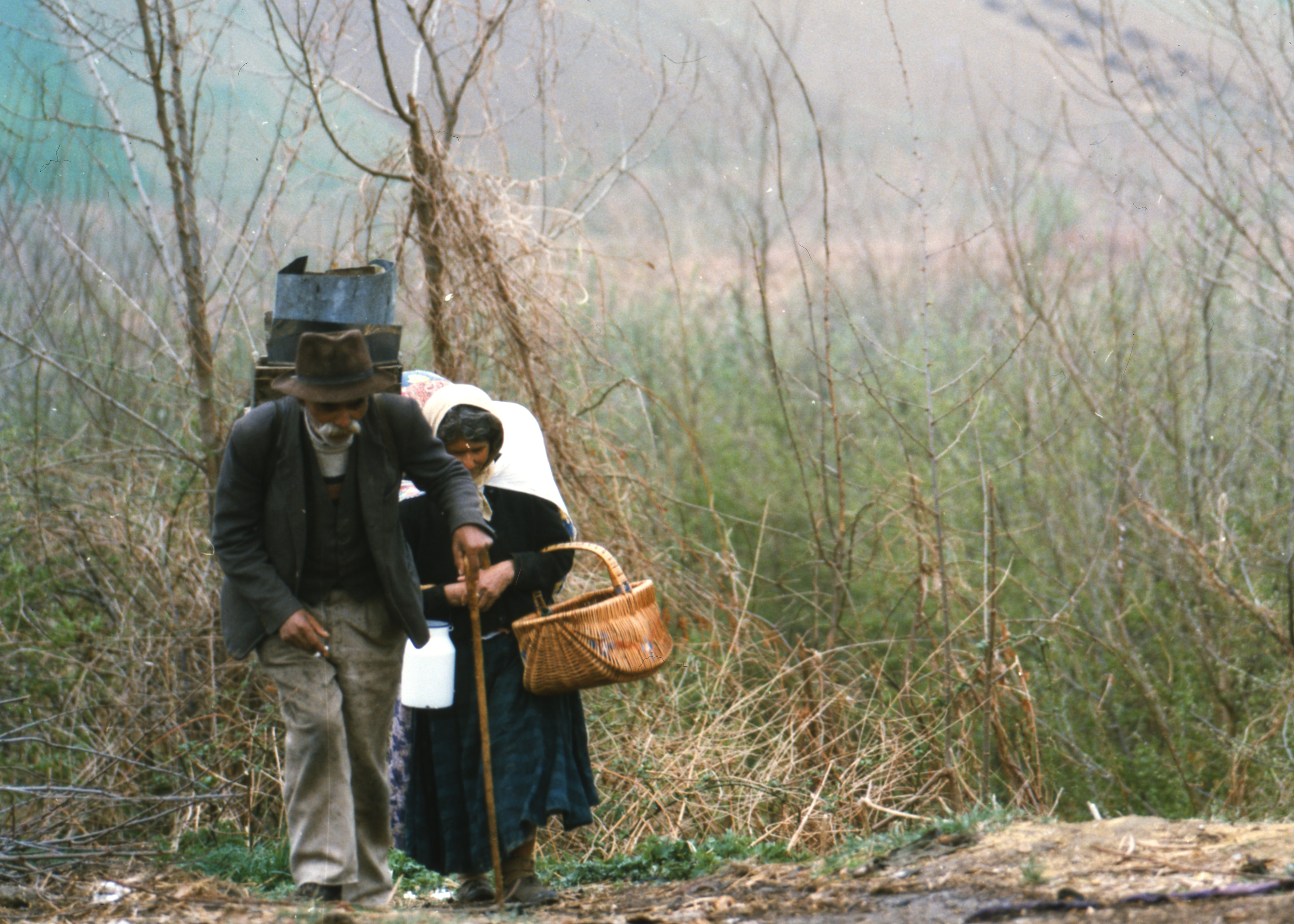
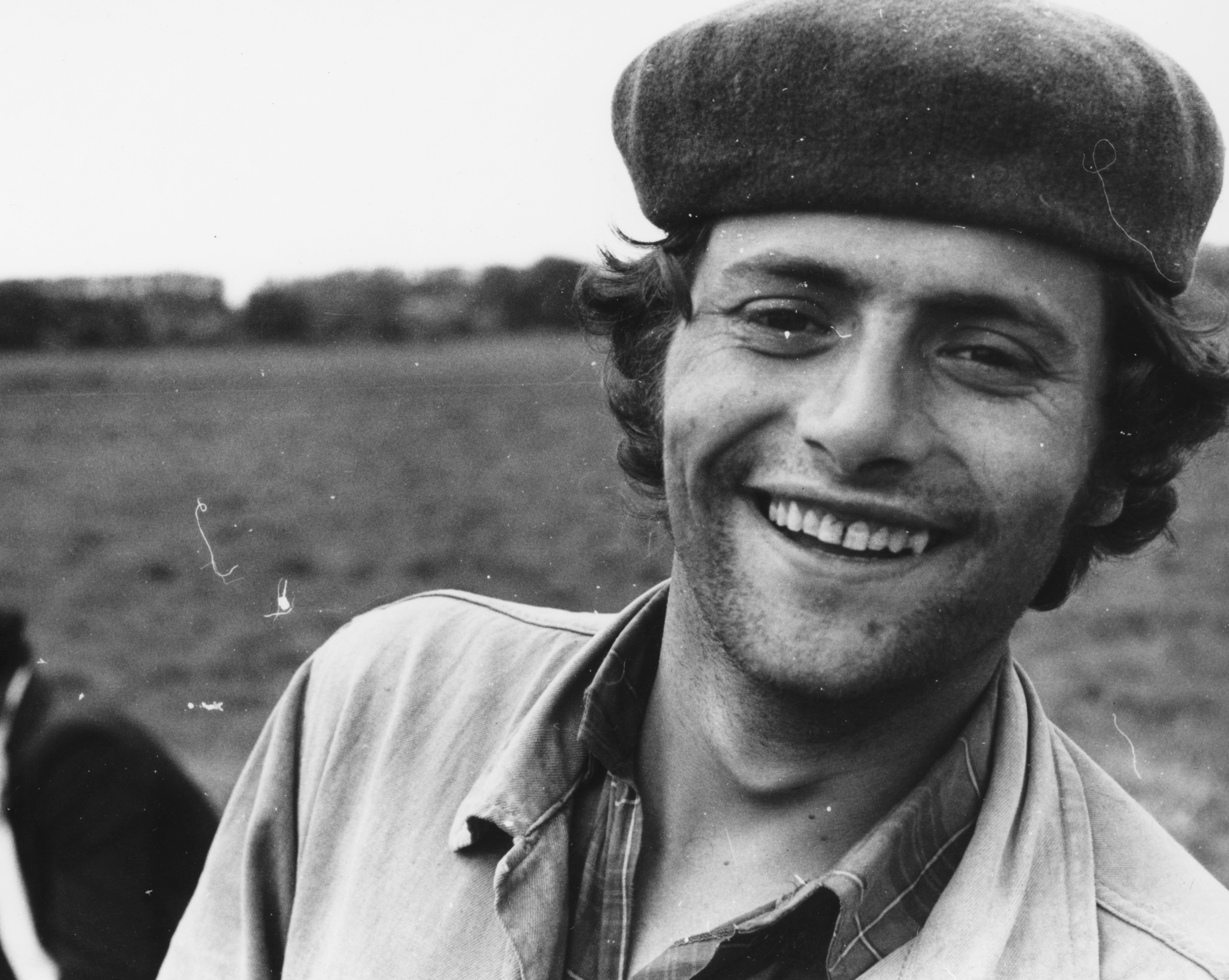
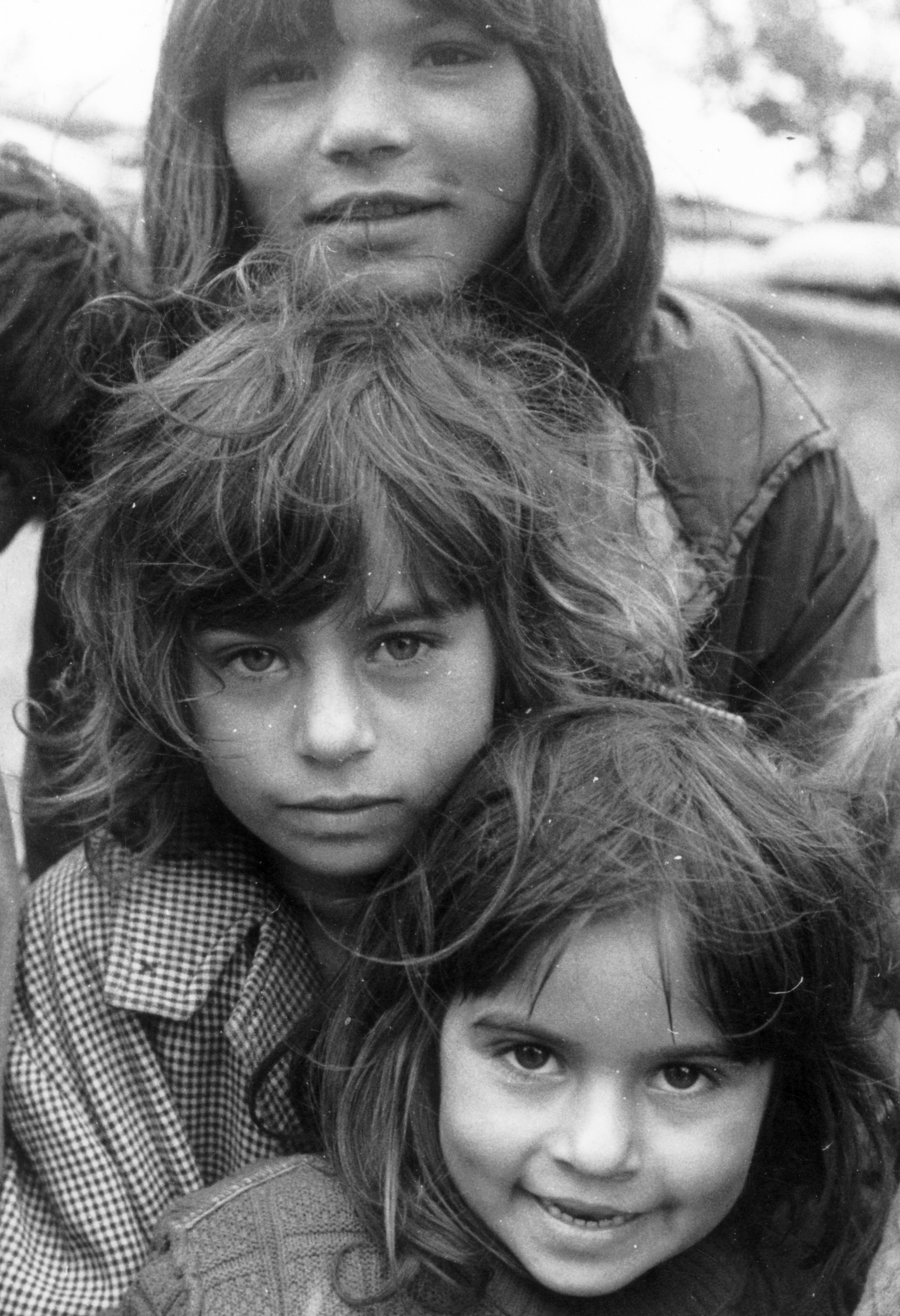
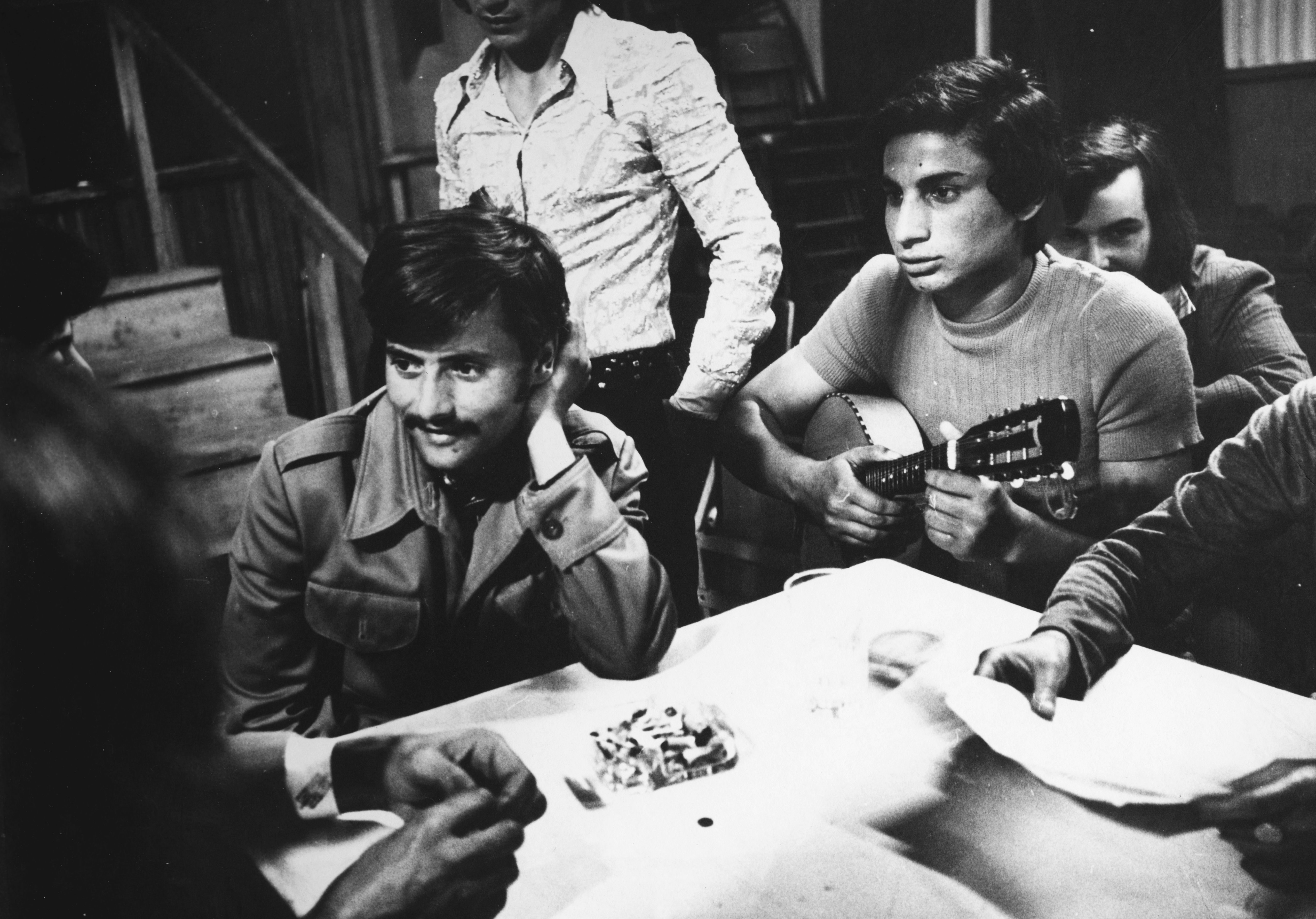
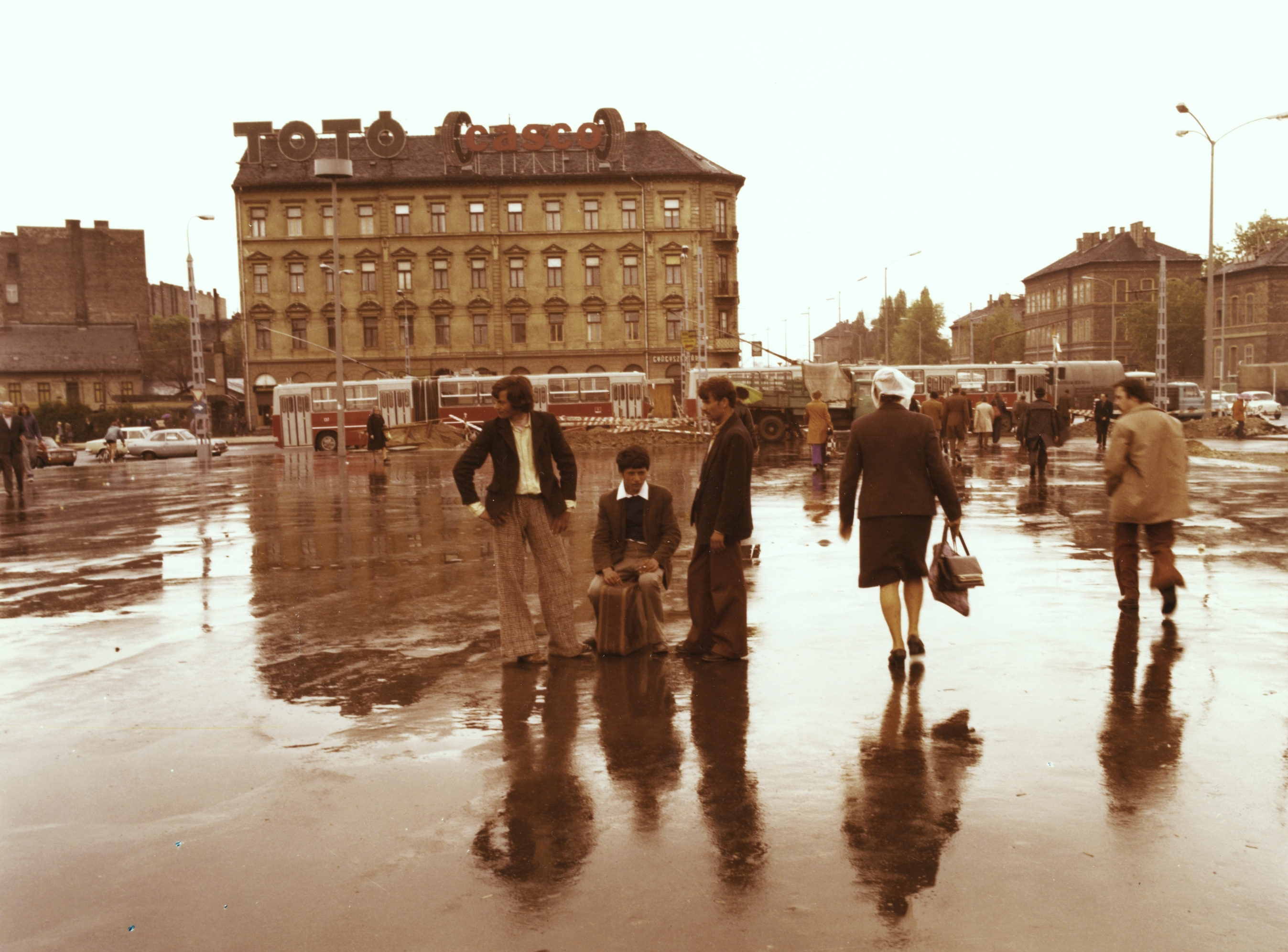
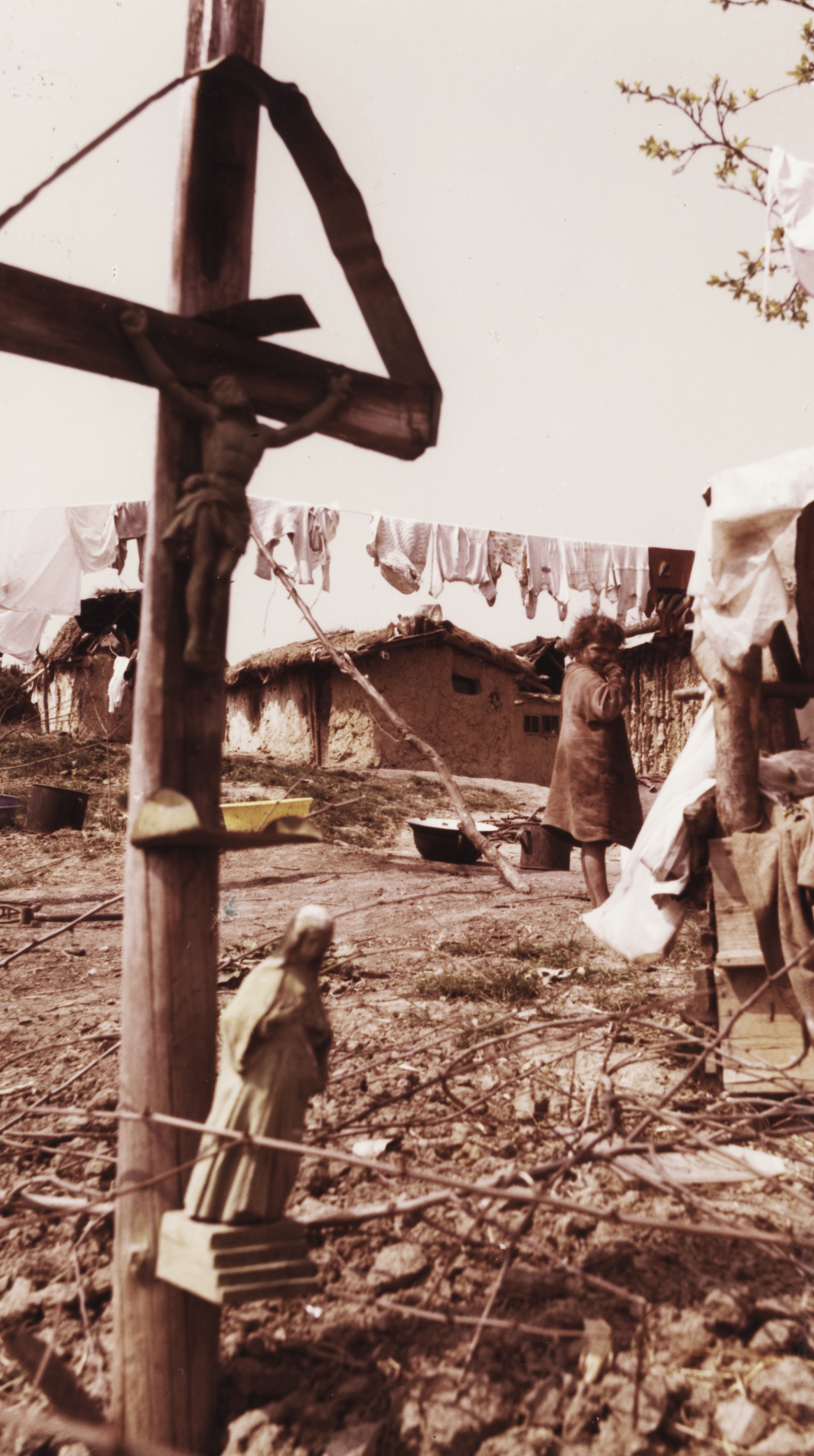
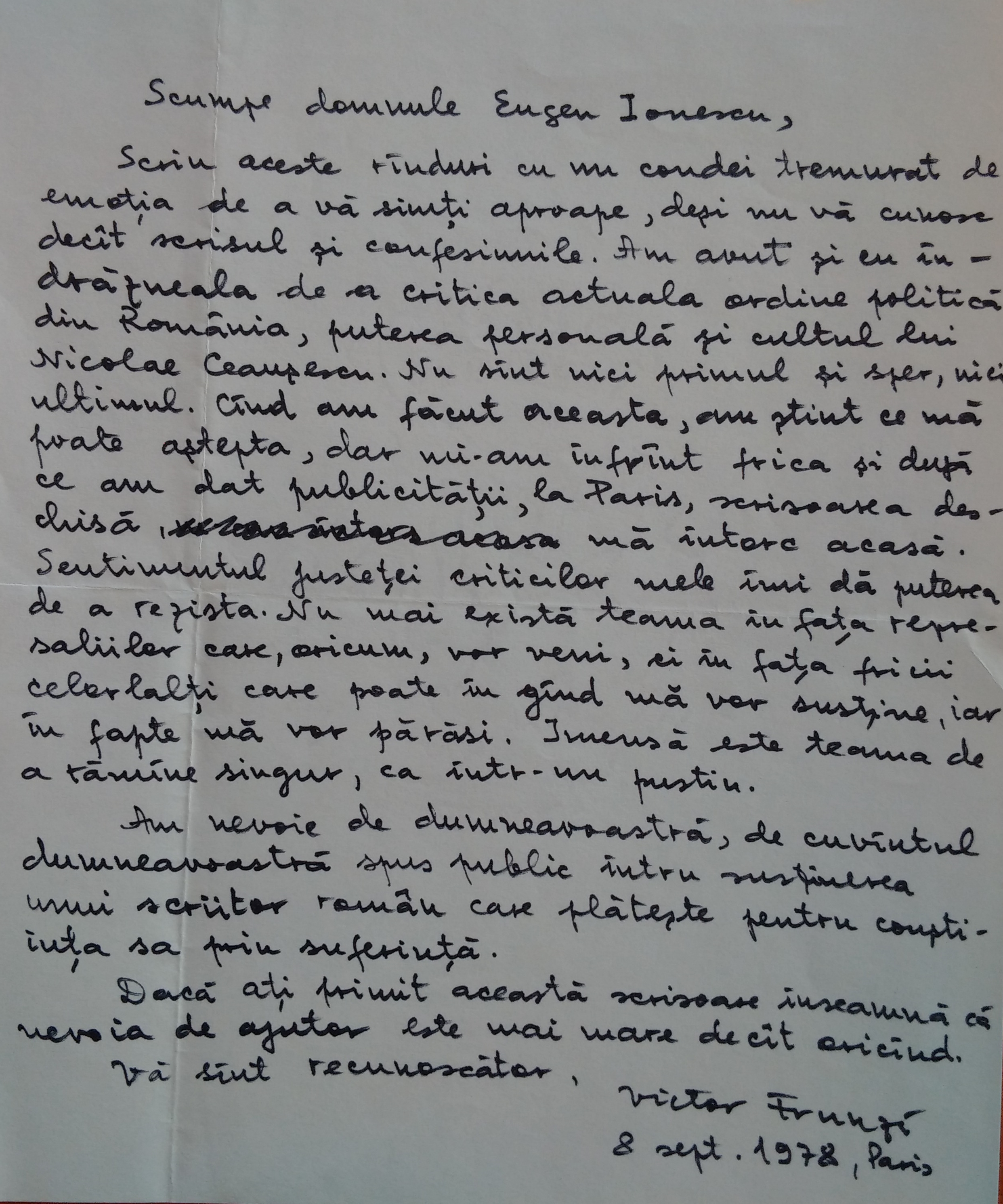

This letter is an important document for the history of the post-war Romanian exile community because it is a proof of the attempt of a Romanian dissident to establish a connection with the emigration. The purpose was to gain the support of Romanians abroad. If their situation was publicised in the West, then there were chances that once returned to their country they would not suffer the reprisals of the communist regime. Also, such actions were meant to trigger the support of international public opinion in criticising Nicolae Ceausescu's dictatorship. One such example was the action of the Romanian writer and journalist Victor Frunză during a tour in France in 1978. In Paris, he wrote a letter to Eugène Ionesco (Eugen Ionescu), a French-language writer originally from Romania, a representative of the theatre of the absurd and a member of the French Academy. In this document, sent on 8 September 1978, Victor Frunză informed Eugène Ionesco that, in France, he criticised openly the situation in communist Romania, especially the personal power and personality cult of Nicolae Ceaușescu. Starting from the idea that he was not the first Romanian and hopefully not the last to do so, Frunză told Ionesco that his approach was deliberately chosen, in full awareness of the possible consequences for him: "When I did this, I knew what I could expect, but I have defeated my fear (...). The sense of the justice of my criticisms gives me the strength to resist. There is no fear of the reprisals that will come anyway, but in the face of the fears of others who can in my mind support me, and in fact will leave me. Immense is the fear of staying alone, as in a desert." In conclusion, Victor Frunză asked Eugène Ionesco to publicly support his action of criticising the dictatorship and personality cult of Nicolae Ceaușescu.
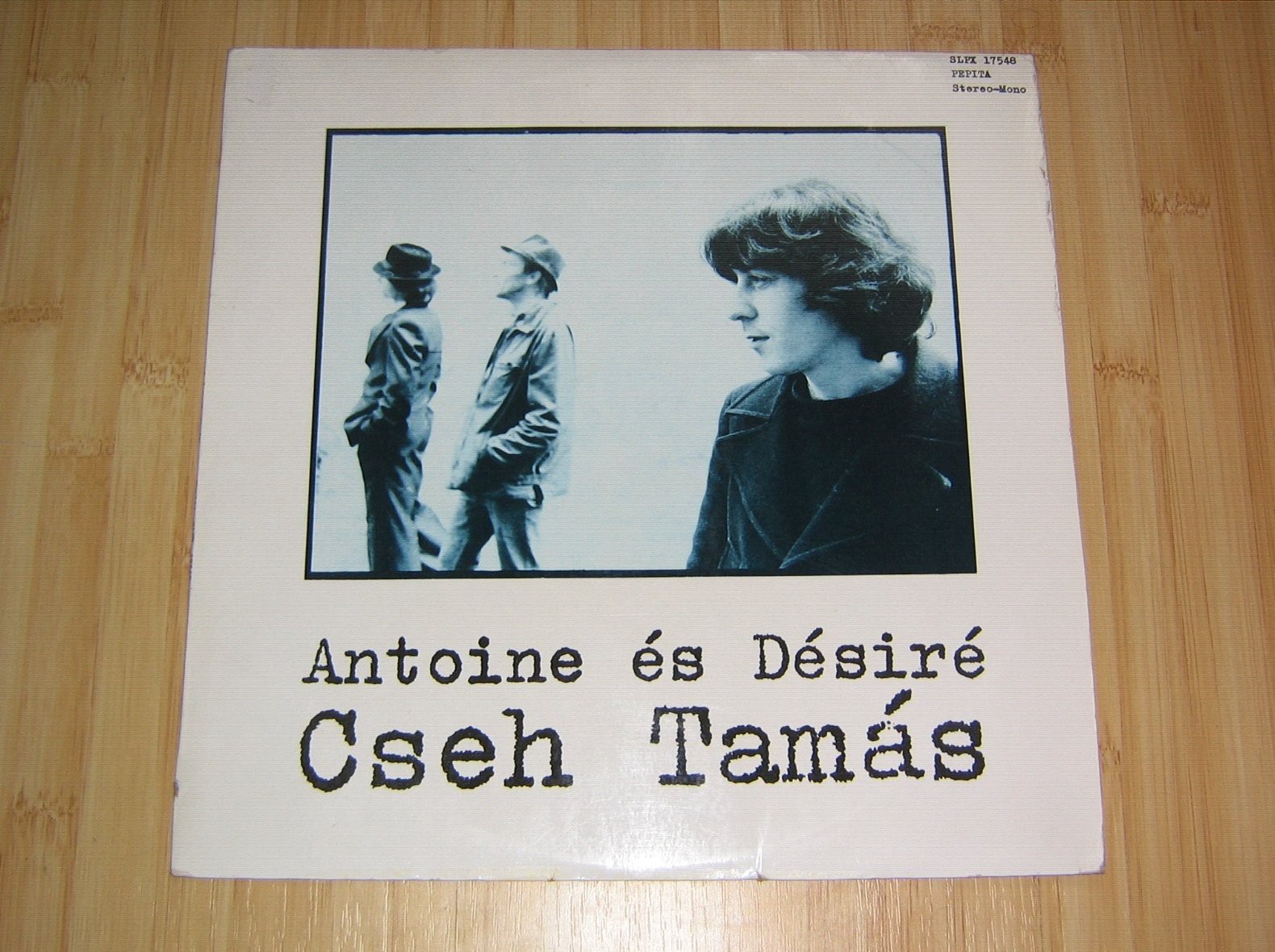

Antoine and Désiré can be considered a concept album. Released in 1978, it was Cseh’s second album. The protagonists mentioned in the title appear on the sleeve, thanks to the photo series by János Vető. They are impersonated by two people who were well known in underground circles of the time: Dixi, the poet and Zuzu, the painter. Two (fictional) biographies are also included.
As the author of the lyrics, Géza Bereményi, notes in his account, Dixi and Zuzu only lent their faces to the cover photos. The biographies reveal two typical life stories from the 1970s, one person who earns reasonably well and another who is less successful in career, nonetheless they remain friends, in spite of their different fates. According to the authorial account, they were inspired by archetype of the white and the red clown, so all the songs on the album can be considered parts of a series of clown pranks. The red clown is Désiré: the saunterer, an awkward kid; the white is Antoine: the successful adult.
In some songs, the voice of Desiré can be heard, in others a narrator tells the story, giving the singer a chance to identify with the character, but also to exit the role. The play with the alternation of identification and distancing is a returning element in their songs. The lyrics balance between the possibilities of speaking out and concealment, and partly expressed sentences and unnamed circumstances are frequent, and this accurately portrays the lives and prospectives of the protagonists. The songs are strongly atmospheric beyond the stories, and they give a precise account on the era through the sentiments they evoke.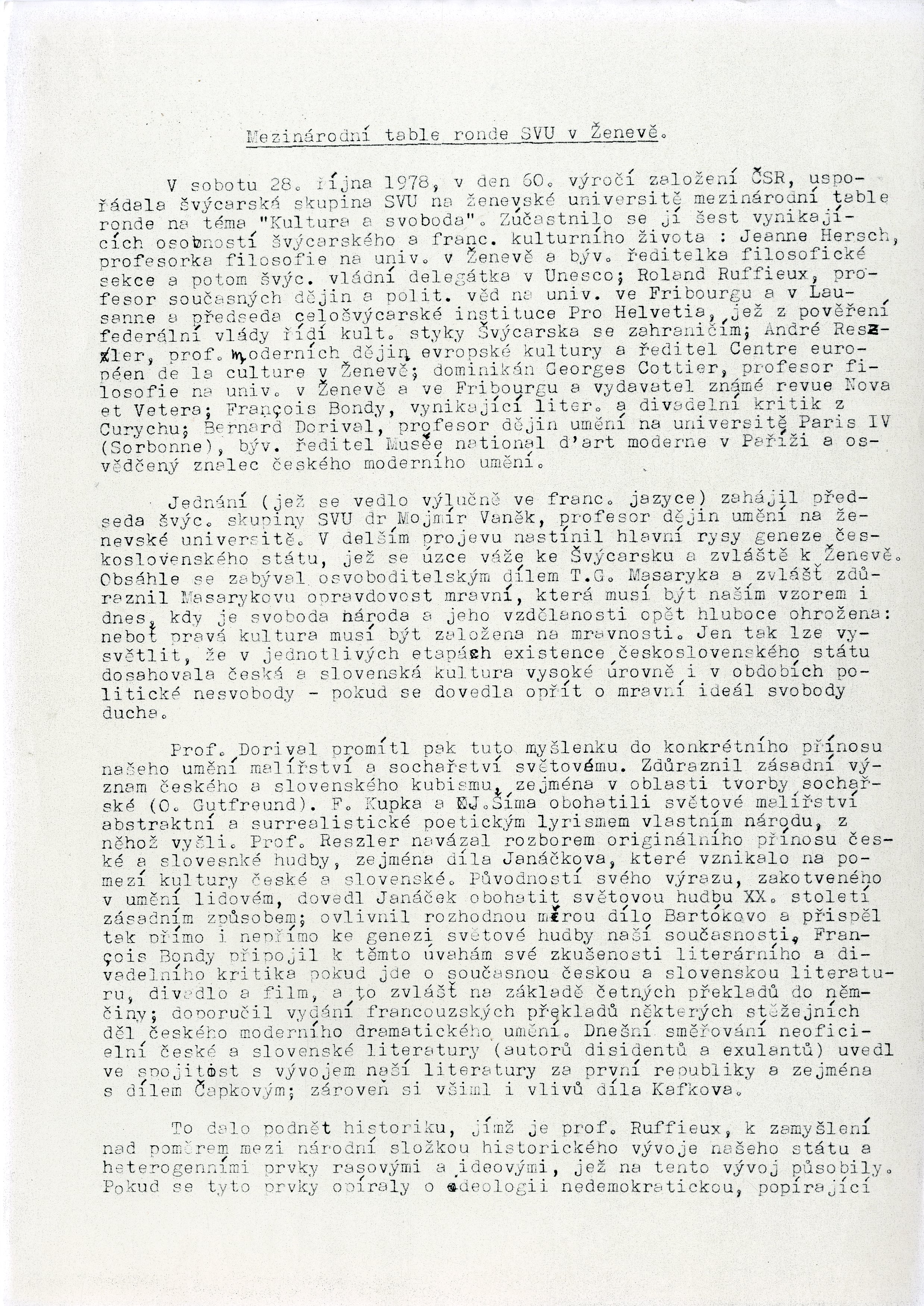
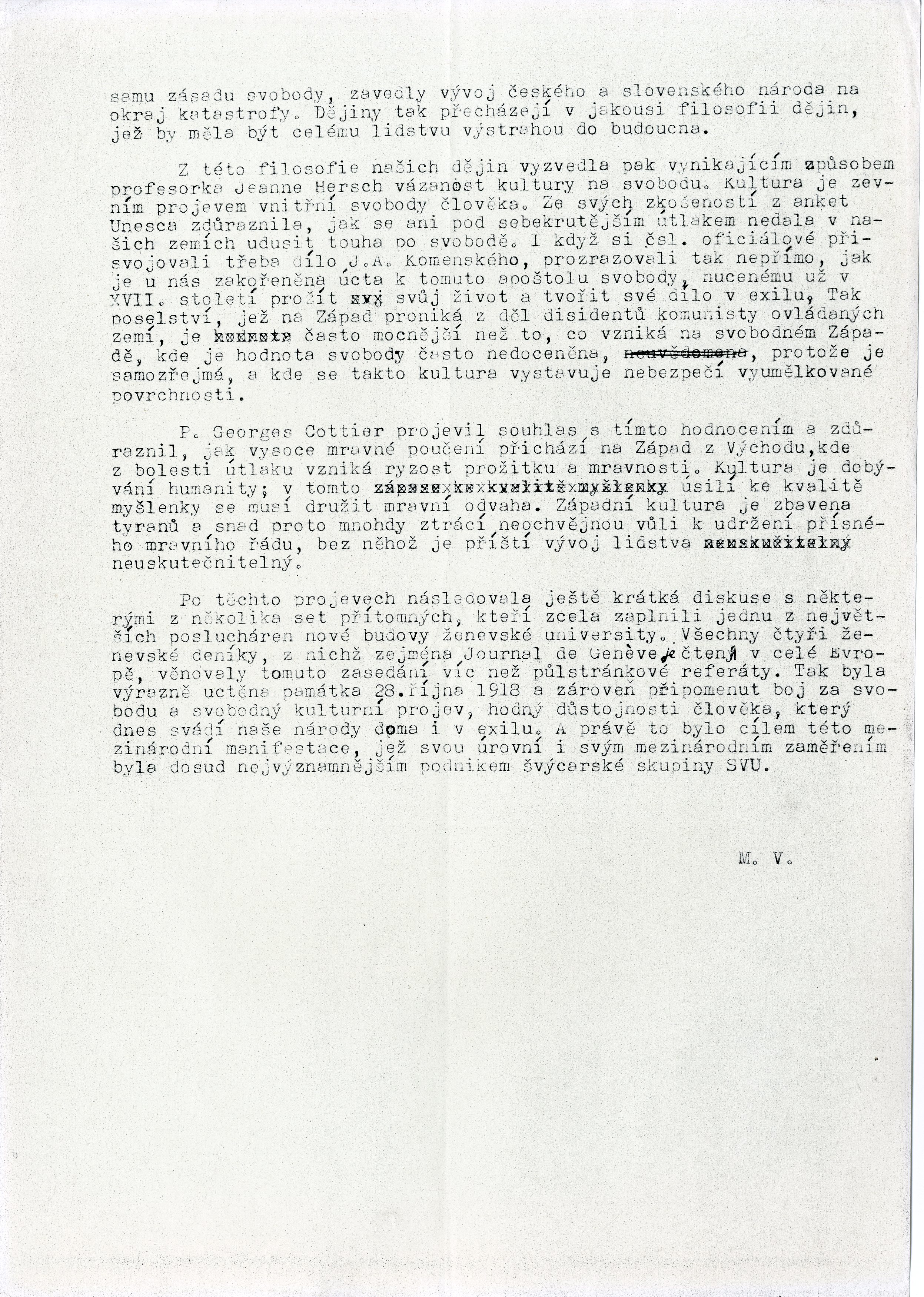


Minutes from the International Table Ronde SVU in Geneva were kept by Mojmir Vanek, the main organizer of the Symposium, as well as the Chairman of the Swiss Group of the Society for Science and Art (SVU) in the aftermath of the Symposium.
On two pages of machine-written text Vaněk describes the course of the symposium and who participated in it, as well as the course of discussion. The Symposium on “Culture and Freedom” was held on 28 October 1978 to mark the 60th anniversary of the founding of Czechoslovakia on behalf of the Society for Science and Arts. The so-called table ronde was held in French and was attended by six prominent people from Swiss and French cultural life: President Pro Helvetia, R. Ruffieux (Lausanne and Friborg), B. Dorival (Paris-Sorbonne), Jeanne Hersch (Geneva), G. Gottier (Geneva) and literary critic Francois Bondy (Zurich). This event was exceptionally well received in the Swiss press as well as in Czechoslovakia. Mojmir Vanek presided over this symposium.
This symposium, and especially Mojmir Vaněk´s speech at the beginning of the negotiations, was likely the reason why his Czechoslovak citizenship was revoked only a month after the symposium was held. This entry is the unique testimony of Mojmir Vanek about this symposium and was likely used as a record for the Society for Science and Art. Vanek himself regarded this event as an international manifestation, which at its level and its international focus was still the most significant enterprise of the Swiss group of the SVU.
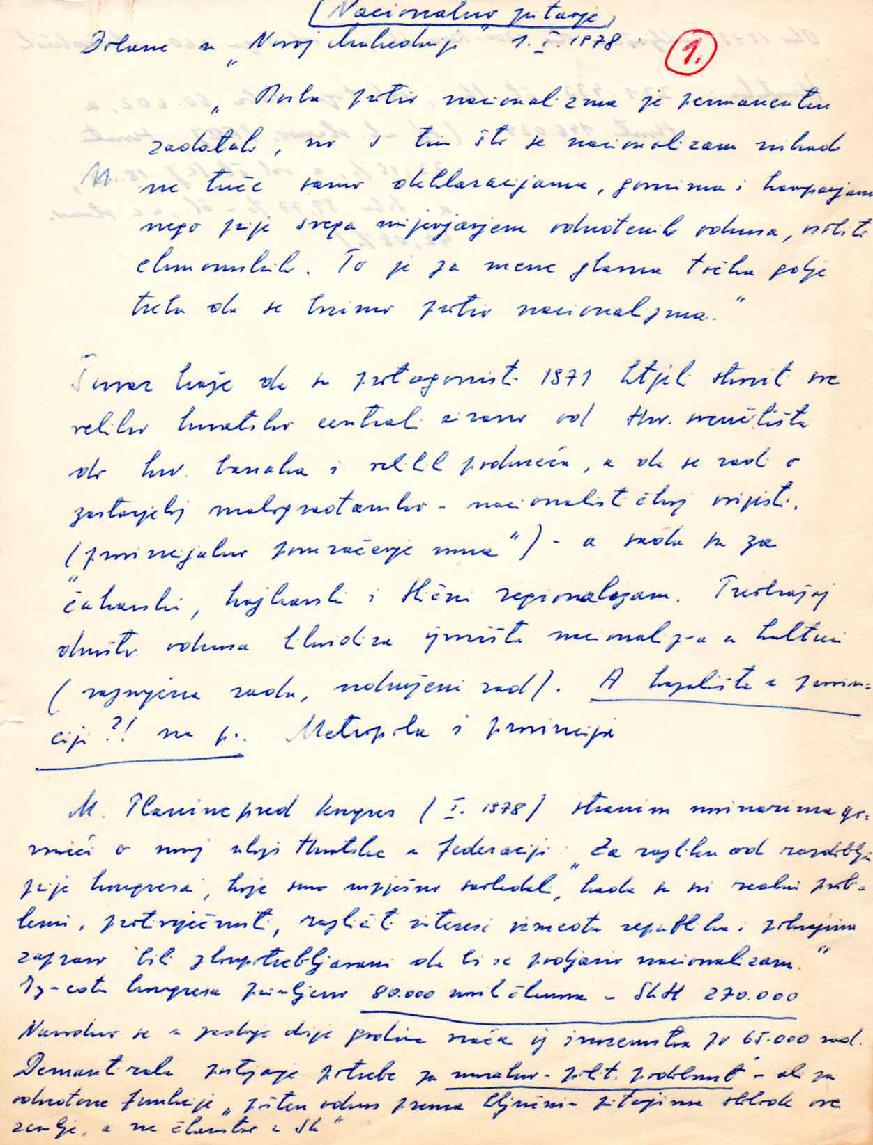

As one of the key participants in the Croatian national movement called the Croatian Spring, Miko Tripalo in his dissident phase wrote reviews in which he analysed the issue of inter-ethnic relations in Yugoslavia. Tripalo's critical observations were directed at the actions of Croatian politicians who had gained affirmation after the fall of the Croatian Spring – people like Stipe Šuvar and Milka Planinc. Those notes are valuable contributions to a critical reflection on the open issues of Croatian national emancipation.
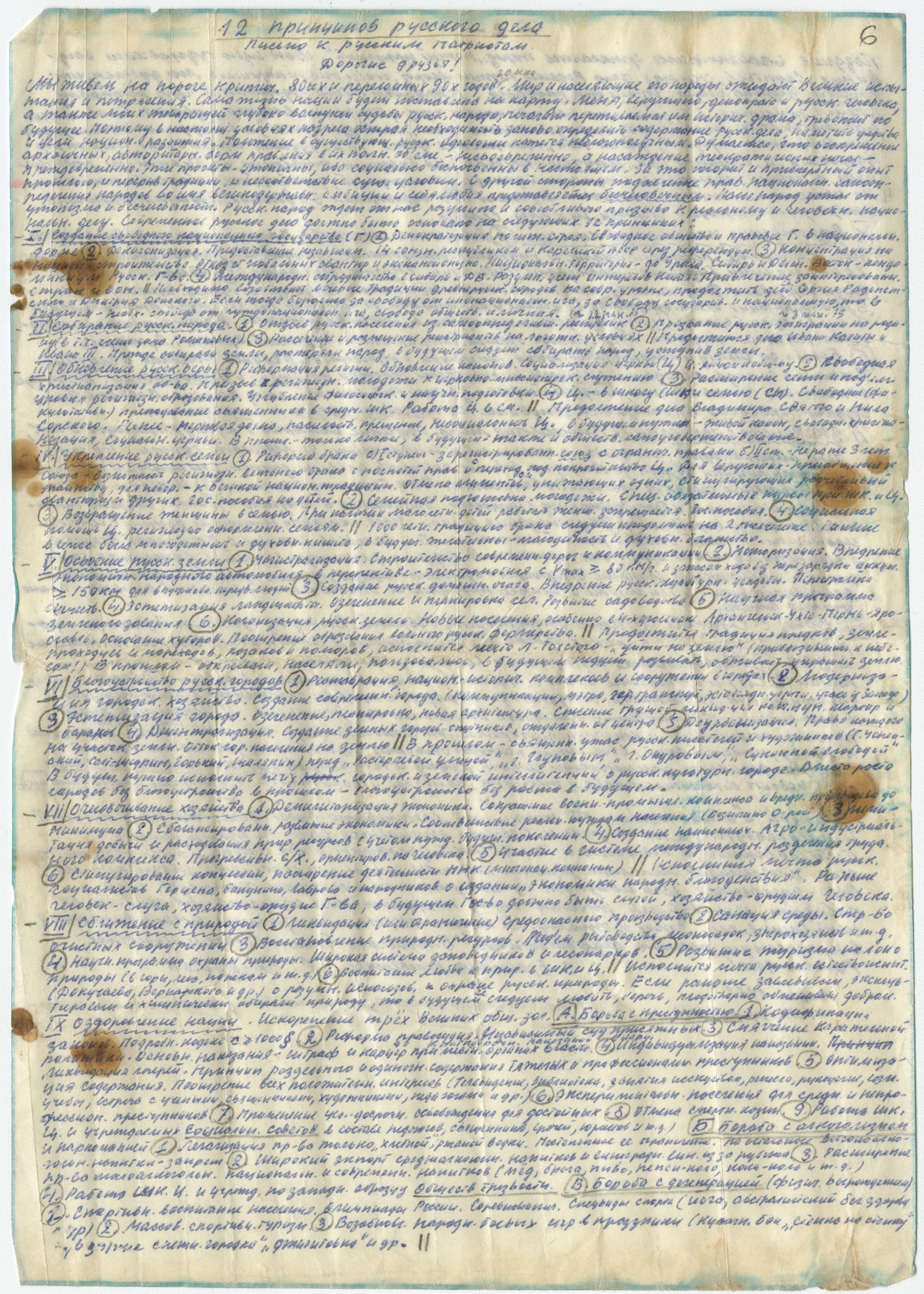

A folder contains Soldatov’s original letters and notes written on rolls of paper. His letters and notes were smuggled one by one out of the prison camp by his wife Ludmilla when she visited him. These writings included several philosophical and religious contemplations, which were later published in Soldatov’s collected works.
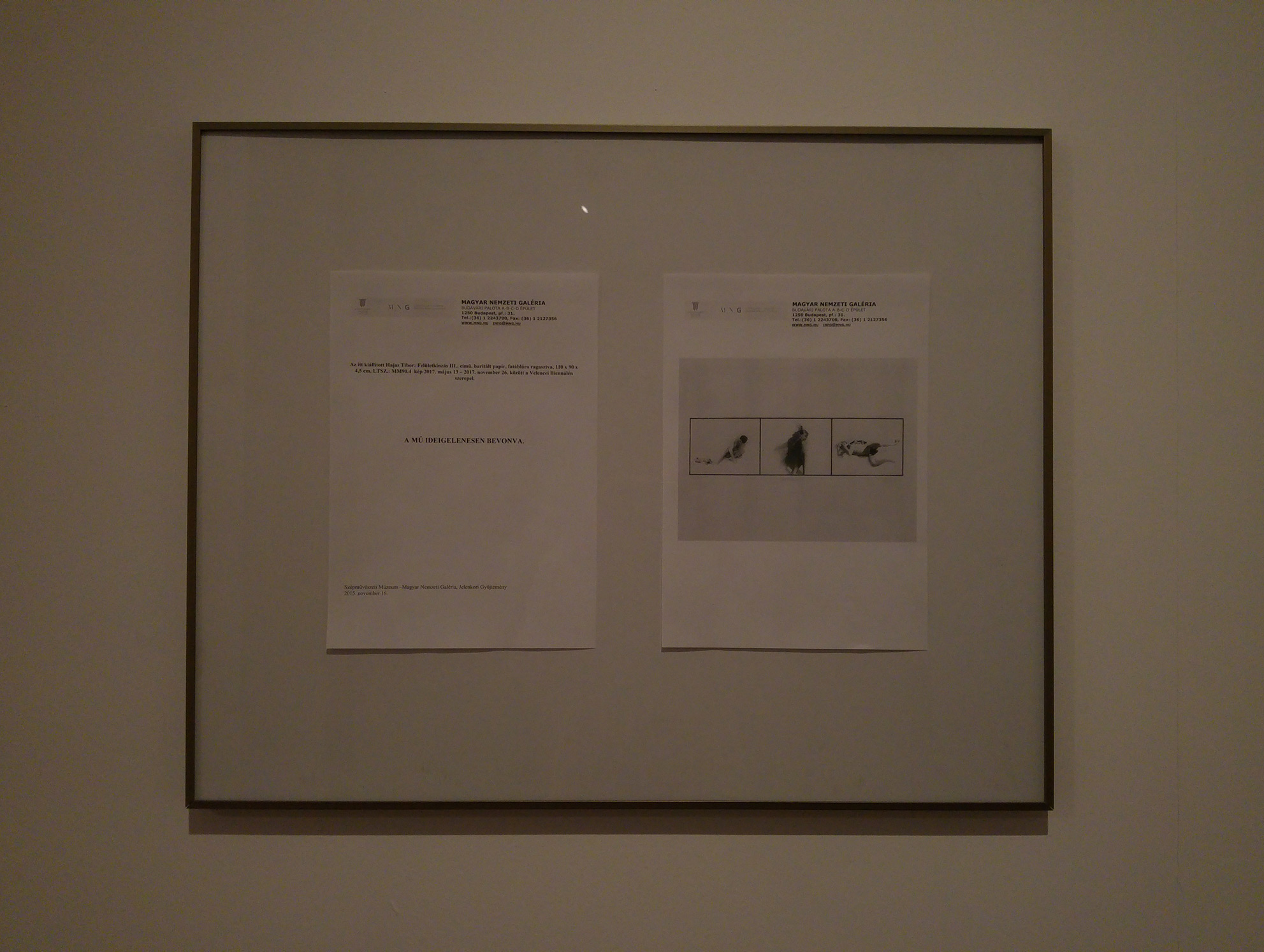

Photographs on fiber-based paper attached on wood panel, 90 × 110 cm
The final years of the early departed Tibor Hajas, his performances activated his body as a medium. Parallel to the live performances designed to the last detail, he made photo tableaus of performances in the studio or another closed space, without audience, in front of the camera of János Vető.
In these photographs, the artist appears in a homogenous white space, naked, in poses suggesting exposure. However, this is only the foundation of the composition: the artist charred and burned the emulsion of the developed negative, complementing the postures.
We see a double artistic expression here: on the one hand an intervention referring to the body, on the other hand a manipulation referring to the media. At the same time, they trigger the viewer both viscerally and allegorically (the latter effect is strengthened by the subtitle).
The complete “Surface Torture” series, part of the Contemporary Collection of the Hungarian National Gallery, was presented at the central exhibition of the 57th Venice Biennale, in the section “Pavilion of Joys and Fears.” For this reason, the original work of art is currently on loan from the permanent exhibition of the Contemporary Collection of MNG, where it usually has its home.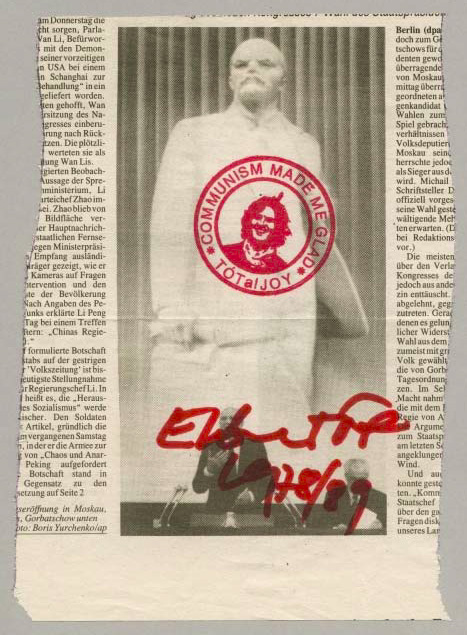



Mojmír Vaněk organized a symposium on the topic "Culture and Freedom" on the occasion of the 60th anniversary of the founding of Czechoslovakia and on behalf of the Society for Science and the Art (SVU) on 28 October 1978. The so-called table ronde was held in French and was attended by six prominent people from Swiss and French cultural life: President Pro Helvetia, R. Ruffieux (Lausanne and Friborg), B. Dorival (Paris-Sorbonne), Jeanne Hersch (Geneva), G. Gottier (Geneva) and literary critic Francois Bondy (Zurich). This event was exceptionally well received in the Swiss press as well as in Czechoslovakia. Mojmír Vaněk presided over this symposium.
The event started by dr. Mojmír Vaněk as chairman of the SWU Swiss Group, where he outlined the main features of the genesis of the Czechoslovak state, which is closely linked to Switzerland. He talked extensively about Tomáš Garrigue Masaryk's liberation work and stressed Masaryk's morality, which he felt was a model at a time when the freedom of the nation and its education were once again profoundly threatened, and when true culture must be based on morality. The audience of this symposium filled one of the biggest lecturers of the new university building in Geneva.
Likely in connection with this event, in November of that year, the Ministry of Interior of the Czechoslovak Republic had revoked Vaněk’s citizenship. His wife, Olga Vaňková, who was also a member of the Society for Science and the Arts, had her citizenship revoked as well.
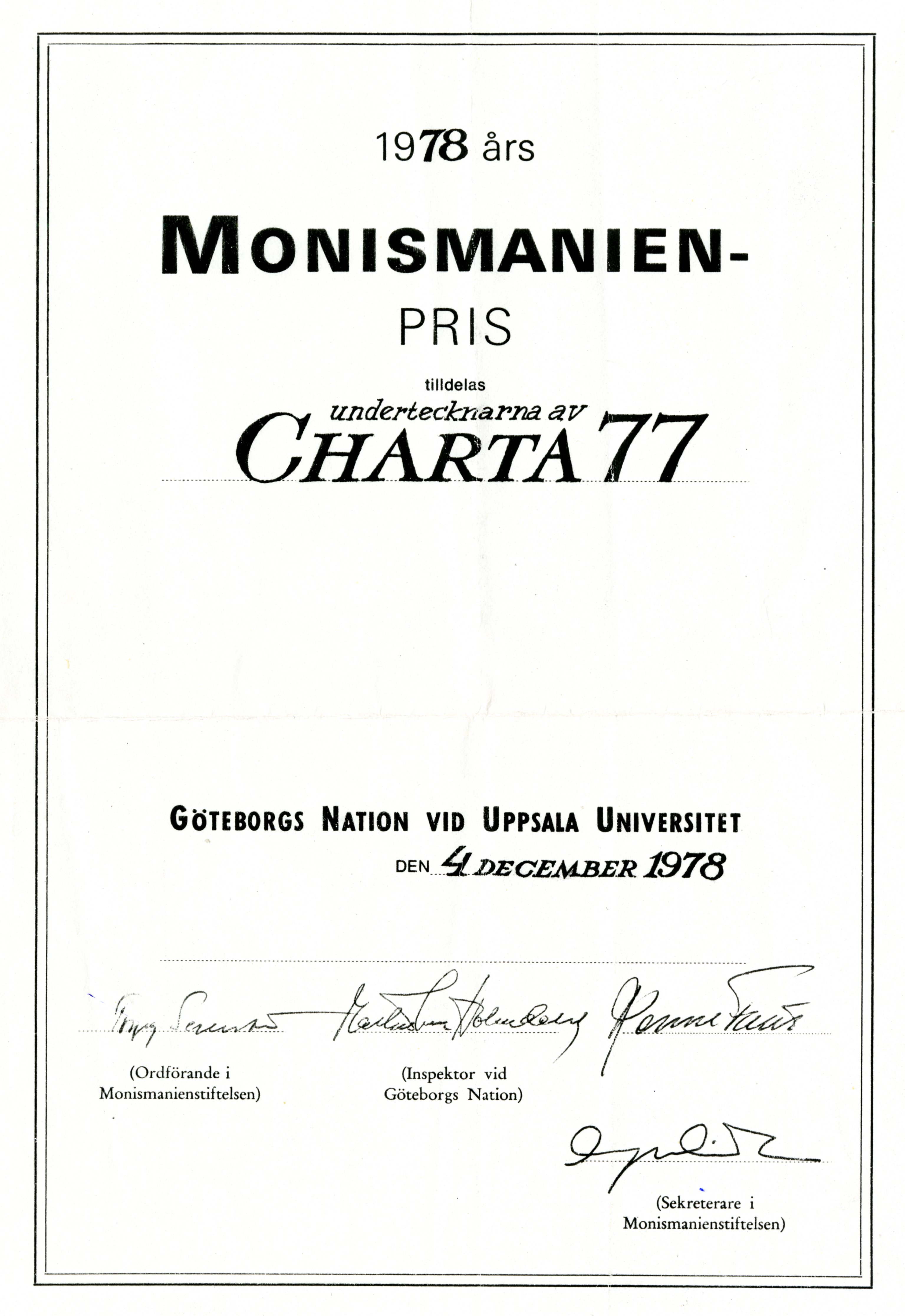

The Diploma of the Monismanien Cultural Prize, inspired the foundation of the Charter 77 in Stockholm. The foundation was founded on the initiative of writer Vaclav Havel after the Charta 77 civic movement was awarded the Monismanien Prize for "its struggle to promote the fundamental human right to freedom of expression." On behalf of Charter 77, he took the prize at the University of Uppsala on December 4, 1978 from the hands of its rector, Professor Frantisek Janouch, who read the letter of the spokesmen of Charter 77 Václav Havel and Ladislav Hejdanek. The prize, which was subsidised with a sum of 15,000 Swedish crowns, was used to set up a fund to support the Czechoslovak citizens, persecuted for their participation in Charter 77, and families of Czechoslovakia. On the occasion of the Monismanien Prize, a call was made to the Scandinavian and international public asking for support for the persecuted opponents of the communist regime in Czechoslovakia. After a successful response, it managed to get more money from private donors and organisations. Thus, this supportive activity was formalised and the Charter 77 Foundation was founded, which until 1989 supported the Czechoslovak opposition. The foundation was led by Professor Frantisek Janouch throughout his life. The diploma of the Monismanien cultural monument in Sweden is only a copy in the collection, the original was probably sent by the Charter 77 spokesperson to Prague.
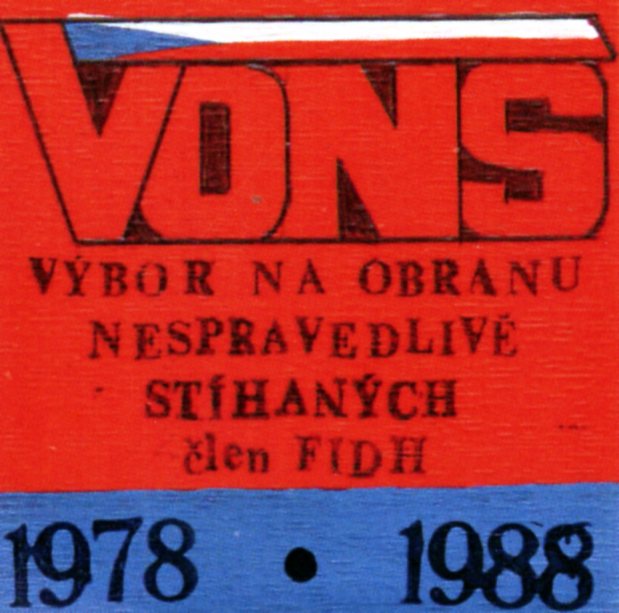

The Collection of The Committee for the Defence of the Unjustly Prosecuted (VONS) contains mainly numbered published materials called ‘Communications’ (Sdělení), which were prepared by the members of VONS in which they described cases of individuals or groups, who had been prosecuted or imprisoned because of their opinions.
The personal collection of Czech poet, journalist, writer and the Nobel Prize laureate Jaroslav Seifert (1901–1986) contains a unique correspondence, manuscripts, prints and clippings documenting the life of the important author, who was a critic of the communist regime from 1950 and a silenced poet and a representative of Czechoslovak independent literature after August 1968.
Triptych by Horia Bernea in Sorin Costina’s art collection is in fact made up of three thematically distinct paintings brought together within the same frame. The artist was one of the most illustrious Romanian painters of the second half of the twentieth century, the promoter of the so-called Neo-Orthodox tendency in Romanian Art. From left to right, the three works that make up Triptych are entitled: Self-portrait, Processional Banner, and Food with Candles. All three are in oil on canvas and are of identical dimensions: 35 cm x 35 cm.
Self-portrait is signed in the lower left-hand corner and dated 15 June 1979. The painting was bought by Sorin Costina direct from Horia Bernea’s studio on 10 December 1979 at a price of 3,000 lei. This is the most well-known of Horia Bernea’s series of self-portraits. It is often included in exhibitions of contemporary art. Placed in the middle, Processional Banner is an earlier work, from 1978. Like Self-portrait, it was bought direct from the artist’s studio, for the same price of 3,000 lei. According to Horia Bernea, the painting of a religious object like the processional banner (Romanian prapor) was his silent protest at the demolition of churches by the Ceauşescu regime from 1977 onwards. The painting was bought on 21 December 1978 and has also featured in numerous exhibitions. The third piece in this thematic series, Food with Candles, was painted in July 1979 and was bought together with Self-portrait from Horia Bernea’s studio on 10 December 1979, also for 3,000 lei. Food with Candles was painted on the very day on which one of the most promising contemporary Romanian poets, Daniel Turcea, died at the age of just thirty-three. Together with the other two paintings or separately, it has also been shown in numerous exhibitions. The three paintings have a common triple frame of oak, the dimensions and material of which were indicated to the collector by the painter himself. Triptych is a defining piece for the personality and art of Horia Bernea, who began his career as an avantgardist who rejected traditionalism only to gradually redefine the avantgarde through his rediscovery and re-reading of traditional Orthodox spiritual values.
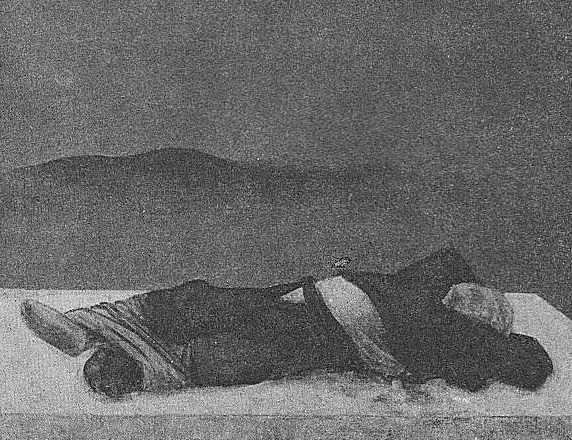

He estimates that, he was called before the Cultural Committee of the League of Communist Youth of Vojvodina at least twice per year, which he considered to be tyrannical. “These people lack a fundamental understanding of what I’m doing. There are exceptional analytical texts that address certain phenomena: death, literature, irony, postmodernism…those various qualities within modern society and culture that expose a new reality and that introduce new questions to our culture. So what do they do? They file a forty page report. Should I kill myself over it? I sit there instead, forced to listen to this nonsense, and worry that I’ll be replaced. And they all continue on, with business-minded faces, going through papers and discussing them as if it were the last judgement of the Provincial Youth Alliance. (…) The people of the party who oversee everything came from the PC (Provincial Commune of the League of Communists of Vojvodina, cf. Aut). I was a young man then. And the Youth Union was assigned to eradicate not just me, but the entire editorial board.”Among the various forms of persecution, Zivlak also noted that every day for two months, a police officer required him to identify himself before entering the editorial office. Jovan Zivlak is forthright about psycho-somatic problems that he developed because of these pressures. He speculates that the only reason he remained editor-in-chief of Polja for eight years was because Novi Sad lacked the media to carry out a personal attack on him.
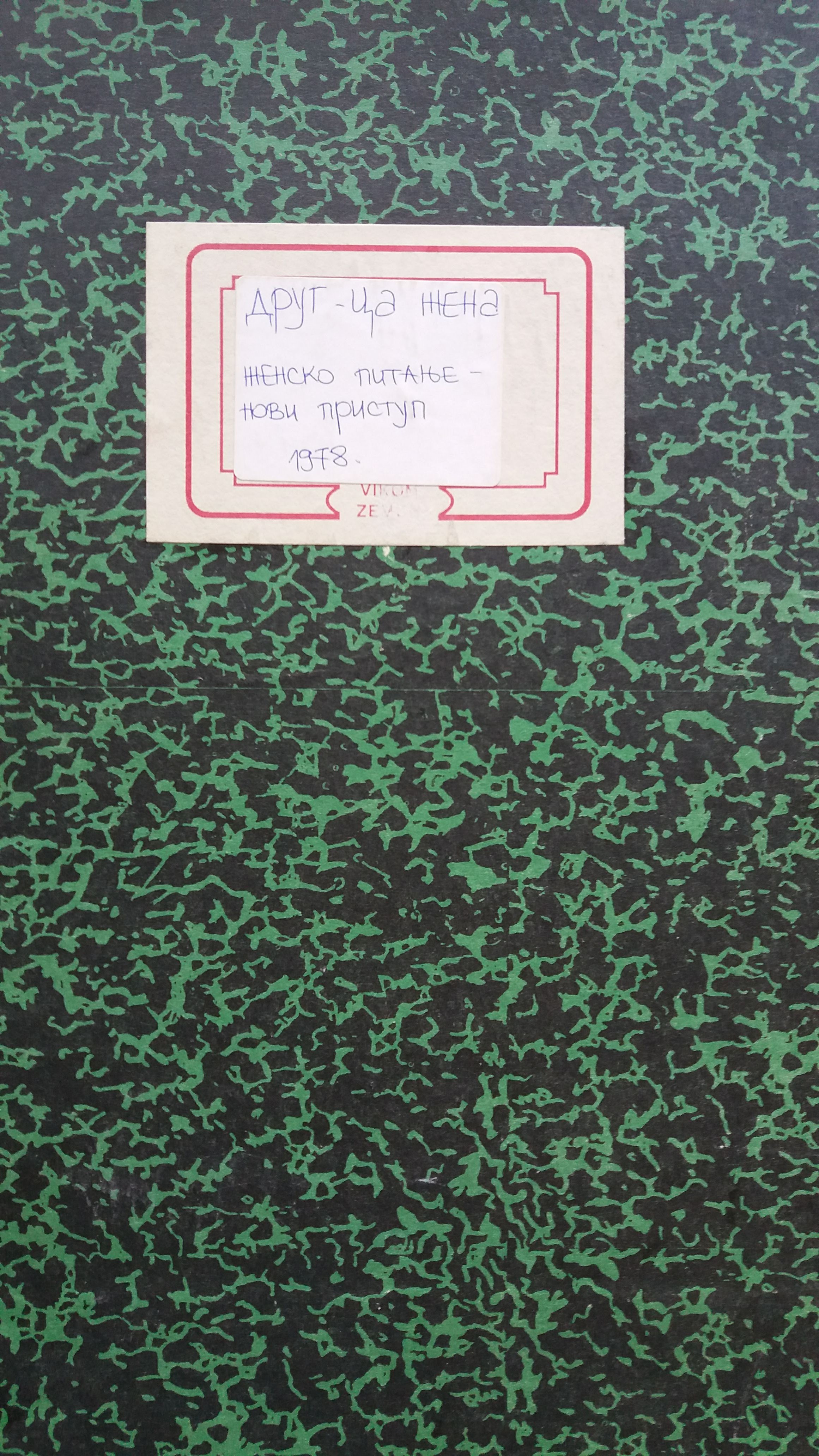

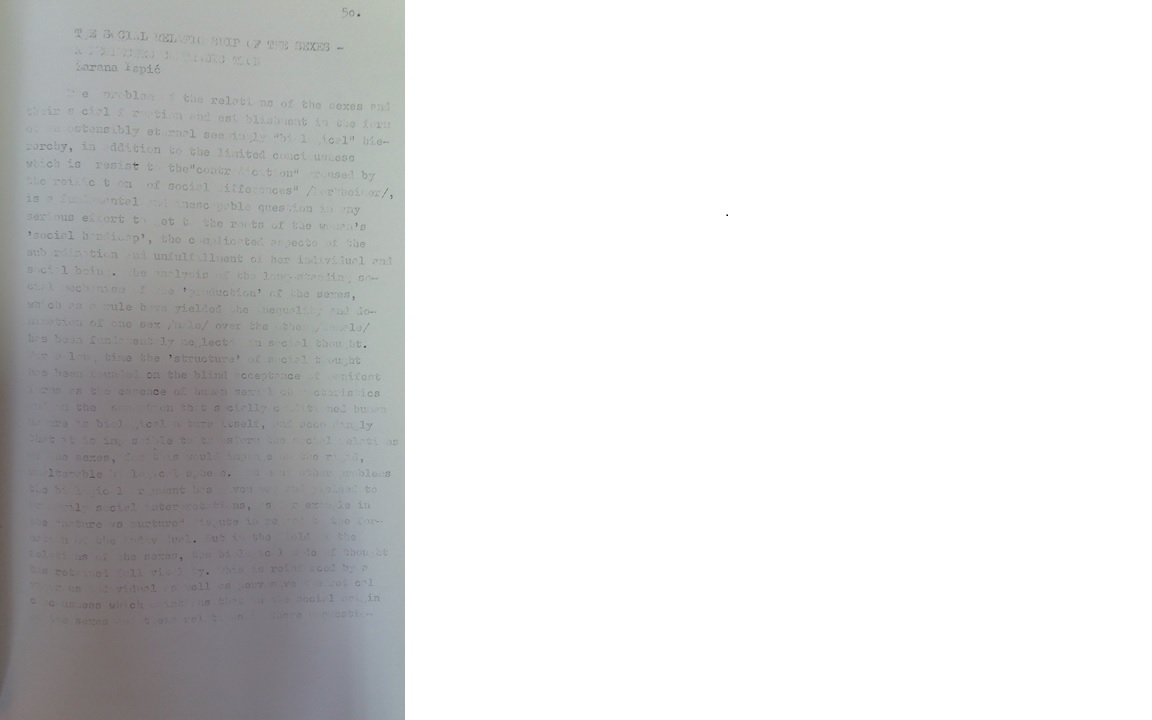
Žarana Papić’s correspondence in this folder documents how she was trying to bring some of the most important names of European feminism to Belgrade - among them Simone de Beauvoir, Sheila Rowbotham, Luce Irigaray and Juliet Mitchell. For this occasion, Papić compiled an impressive list of accompanying texts, which were supposed to familiarize the domestic audience with the key works of Western feminism, but also to provide foreigners with an insight into the specific position of women in Yugoslavia’s self-managing socialism. The featured item presents a translation of a text by Žarana Papić from Serbian into English. It was provided as background reading for the participants of the Drug-ca žena International Symposium. As the typescript is hardly legible, COURAGE transcribed the text in the enclosed word document.
Participant Rada Iveković pointed out the importance of the conference: “Before the conference, we did not exist, we came into being during that conference, we did not know each other. Žarana brought us together in one place, and we were not a group yet, we did not know that we could represent something. We realized that we are many, and that each of us is doing something for feminism.”
That is how the conference came to be remembered as an event which stimulated the development of feminist consciousness among young women in Yugoslavia at that time. Drug-ca opened two key issues, for which Žarana Papić’s activism and position were of crucial importance. The first question was on the reception of feminism in the socialist state. In the approach drawn up for the conference, Papić writes “What are the elements of a practical, social and individual new feminist consciousness, what is new in public behavior and what are its characteristics? […] It is also necessary to ask the question of what happened to women, and what changes in the gender balance disappeared after the shaky socialist revolutions. What is the real position in socialism that has been achieved by striving for emancipation and what problems remain unresolved?”
The second question was related to the situation of Yugoslav feminists between the West and East. This question was linked to the non-aligned position of Yugoslavia since the Tito-Stalin split in 1948. The general topics of the conference were the experiences and specificities of the Yugoslav situation with regard to the results and achievements in problematizing the “female“ issue.
The Drug-ca Symposium made it possible to speak about the imbalance between the positions of female and male compatriots, and through it the word feminism gained significance in the former Yugoslavia.
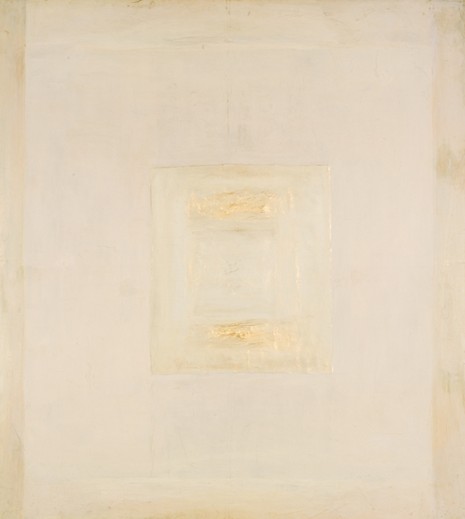

Kazimiera Zimblytė was one of the first creators of abstract paintings in Lithuania. She broke with the tradition of painting based on the figure and narrative. In her work, Zimblytė looked at the understanding, perception and feeling of what is outside material and actual things, beyond material existence. In this specific painting (1978), the artist created the feeling that the object has stopped and is hanging on.
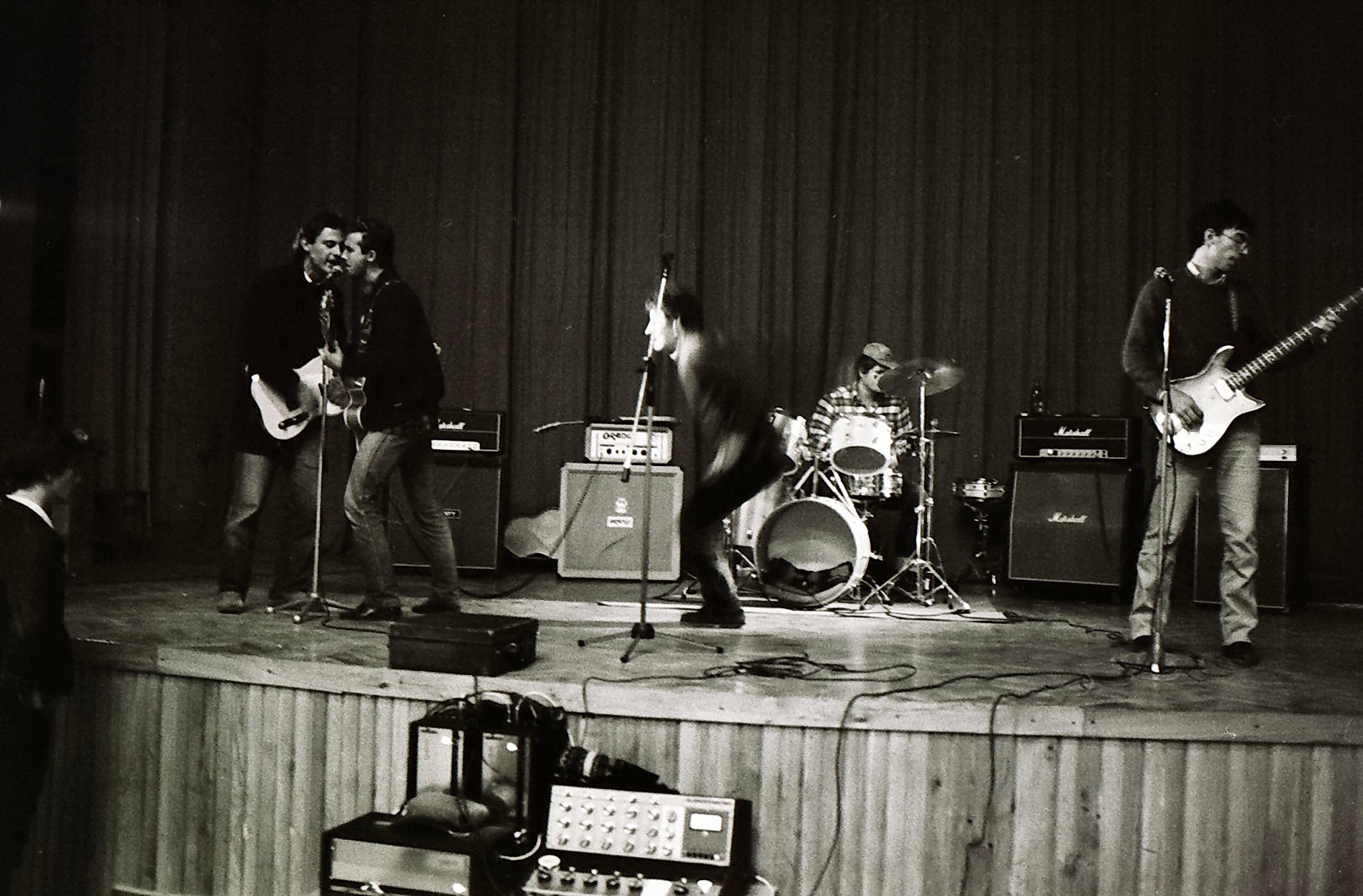

The photo shows the first line-up of the band Azra in Gospić in October 1978. The concert was part of the first tour of Azra organized by Polet. The first line-up consisted of Branimir Johnny Štulić, Jura Stublić, Marino Pelajić, Branko Hromatko and Mladen Max Juričić. In 1979, Jura Stublić, Marino Pelajić and Mladen Max Juričić left Azra and founded the group Film. With Azra soon reformed by Johnny Štulić, the group Film became one of the leaders of the new wave scene not only in Zagreb but also throughout Yugoslavia.
After the strike in Gdansk in August and September 1980 and the establishment of the Solidarity trade union, which meant the beginning of the fall of communism in Poland, Štulić wrote the song "Poland in my heart." It expresses explicit support to events in Poland, and mentions Wojtyla, i.e. Pope John Paul II. Among the young people in Yugoslavia, this song was perceived as a call to freedom from communism and cultural disagreement with the older generation who were in the Party.
After one concert and eight studio albums, Azra broke up in 1990. After several changes in the original line-up, group Film continued to perform and still plays today under the name Jura Stublić & Film.
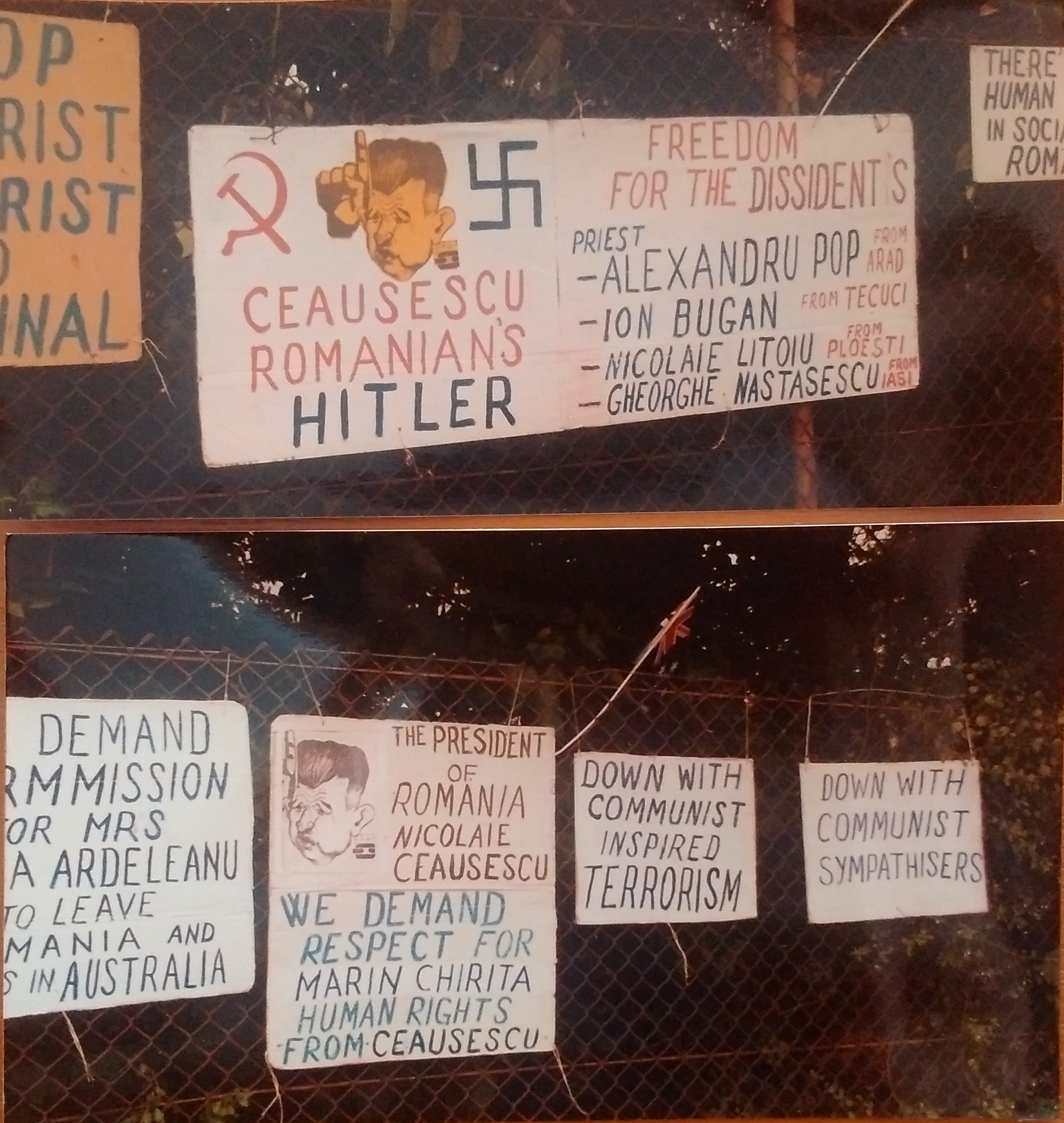

The Victor Frunză Collection is an important historical source for understanding and writing the history of that part of the Romanian exile community which was actively involved in supporting dissidents in the country and in publicising in the West the repressive or aberrant policies of the Ceaușescu regime. In particular, the collection illustrates the activity of the collector and other personalities of the exile community for respecting human rights in Romania. Also, the documents of this collection reflect the involvement of Romanians from abroad in the reconstruction of democracy in their country of origin.
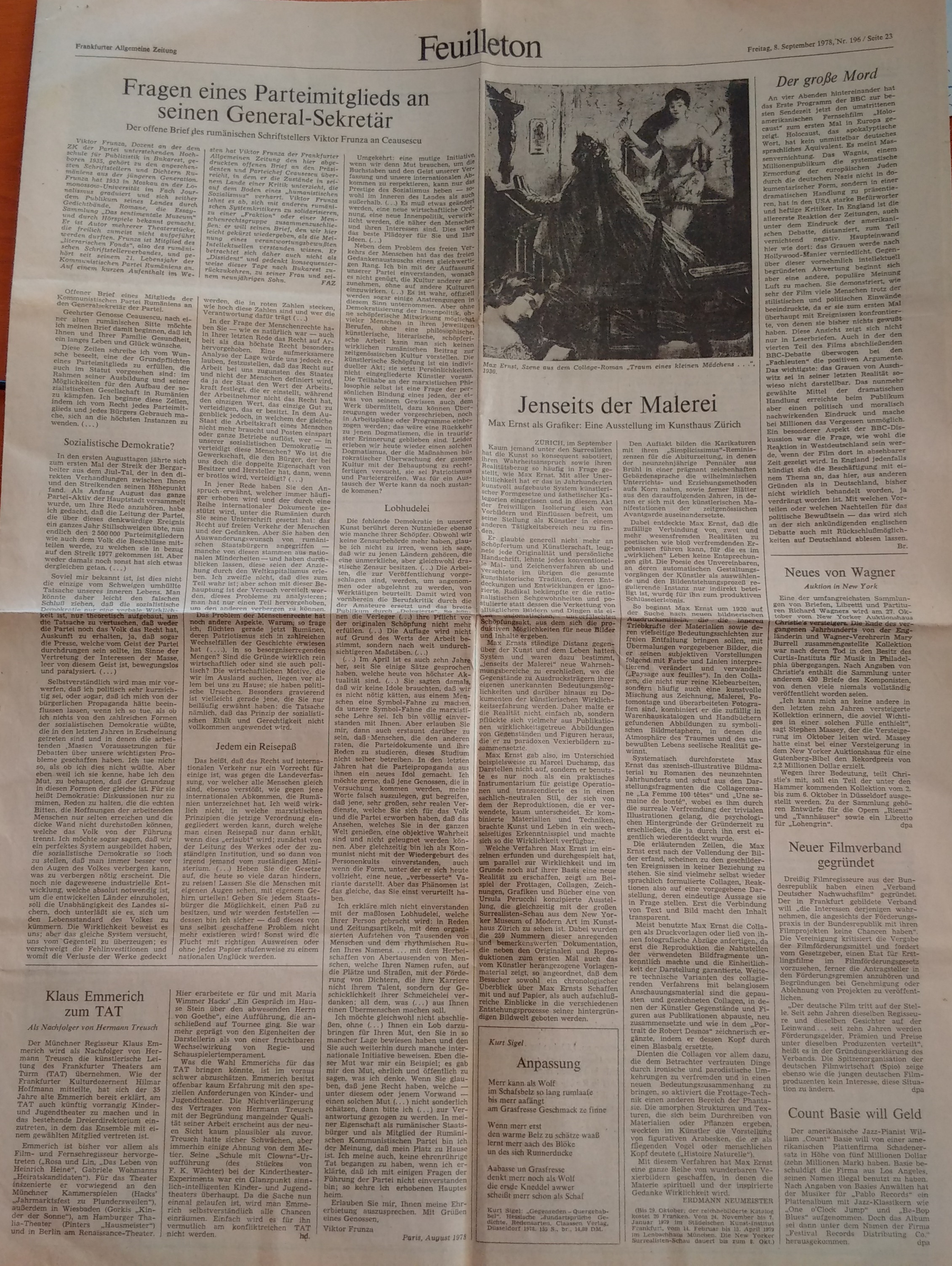

This letter is an important document for the history of dissidence in Romania, being a proof of the open opposition of a Romanian living in the country to the dictatorship of Nicolae Ceaușescu. In this case the writer was Victor Frunză, a Romanian writer and journalist, who in 1978 went as tourist to Paris. On this occasion, he contacted a representative of the Reuters Agency, to whom he handed a letter addressed to Nicolae Ceaușescu. He wrote the text of the letter in Romania and memorised its content in order not to carry it and be discovered at customs control. So he rewrote it from memory after he arrived in France. The material in question was published by Frankfurter Algemeine Zeitung and broadcast by Radio Free Europe. Also, a copy of the letter was sent by Victor Frunză, by post, to Nicolae Ceaușescu. Essentially, his letter was a criticism of Ceausescu's dictatorship: "I want to manifest deep disagreement with the revival of the cult of personality, today is an improved version, decorated with the national flag." Frunză's conclusion was that "the type of socialist democracy in Romania is nothing more than a parody of discussions through speeches, even if these are not written by those who speak them." The document is in the IICCMER archive and is an original copy of the German letter published in 1978 in Frankfurter Algemeine Zeitung. The letter was subsequently published by Victor Frunză in Romanian, at the publishing house he founded after the emigration, in the pages of the book For Human Rights in Romania (1982). The second edition of this volume appeared in 1990, in Bucharest, under the aegis of Victor Frunză Publishing House.
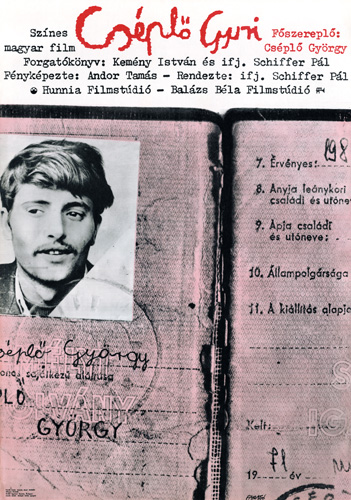

The documentary endeavours of the Budapest School (a tendency in Hungarian filmmaking speared in the seventies which was dominated by a sociological point of view) prevail in this documentary-feature film, which is a “development novel” about György Cséplő, an intelligent and ambitious Roma boy, whose attempt to break out of his miserable existence offers a sketch of the situation of the Roma population in Hungary in the 1970s.
The director shot his situational documentary by setting the scene but then not interfering in the sequence of events (as long as one does not consider the presence of a camera a manner of interference). Schiffer wanted to make the documentary lively and current in order to enable the viewer to participate emotionally.
One of the most interesting diagnoses of the film (which harmonizes with the research of the legendary sociologist István Kemény) is that the poorest, most vulnerable groups of society live and think in the same way, Roma and non-Roma alike, so the so-called Roma question can be approached from the perspective of social stratification, not as an issue of race.
Produced by BBS and Hunnia Studio in 1978.
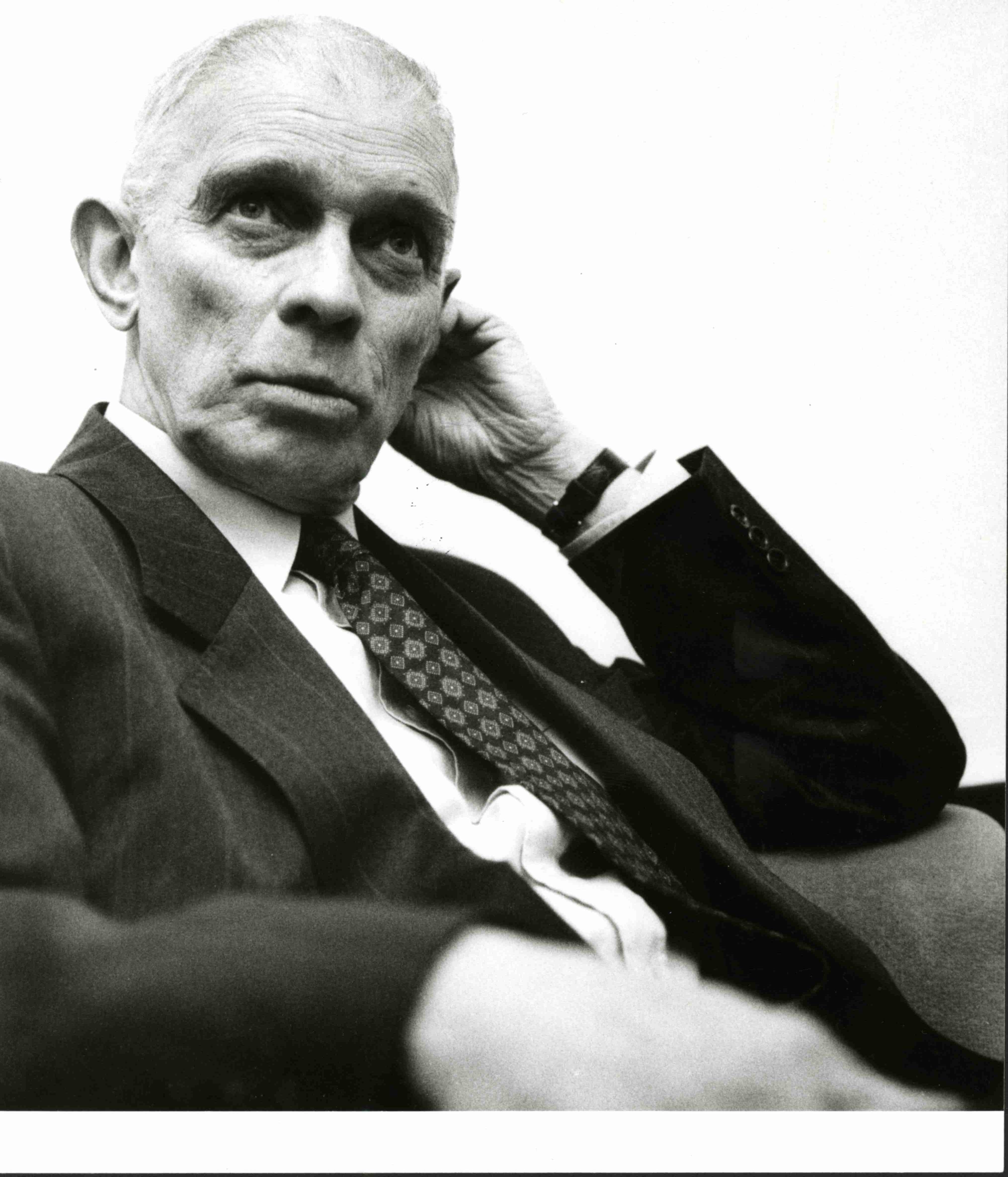

Ivan Medek (1925-2010) was a prominent Czech music publicist, a signatory of Charter 77 and a founding member of VONS. In 1978 he went into exile, where he founded the Press Service and worked with Voice of America and Radio Free Europe. This collection contains unique documents from his exile activity.
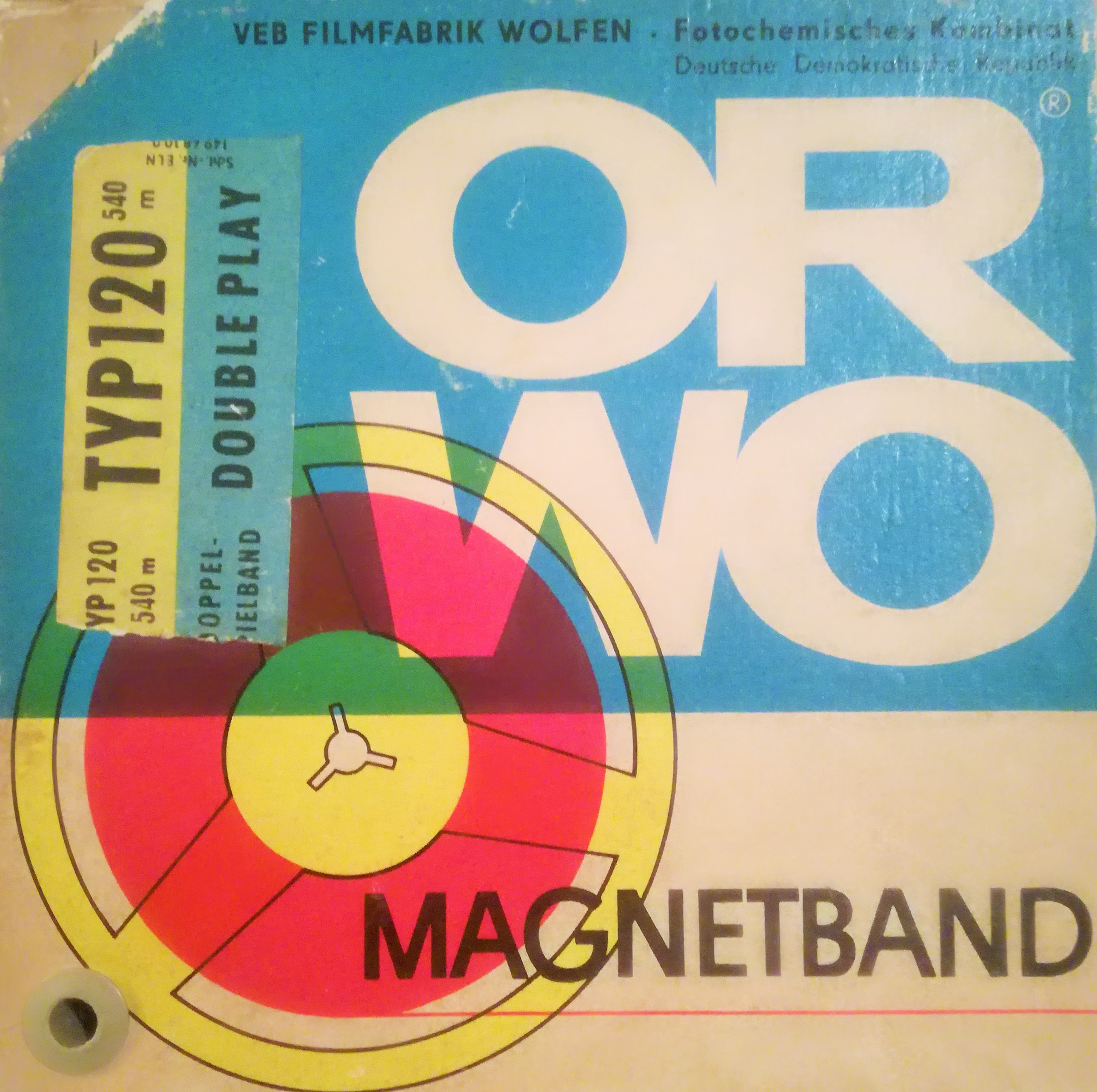

According to very early notes and recordings, István Darkó began work on Macskarádió (Cat radio) while at high school, in the early 1970s, using stories from his home-made paper Bendzin and his comic-experiment Utazás a világ körül (Journey around the world) together with other writings, and it continued to grow until the end of his university years, in 1978. Darkó's first tape recorder was the famous Hungarian Mambó, acquired from his parents; later he used a SANYO. He was very inventive, because he knew the technical possibilities of the poor-quality tape recorders. He worked not with the switch cabinet but with his hand, manually touching the tape to the recording head during recording. He did everything with one tape recorder and one microphone.
The audio recordings of Cat Radio are preserved on East-German-made tape with the series mark ORWO TYP 120/360 m Double Play, 5/482. The box is labelled “A MACSKARÁDIÓ különműsora” (Special programme of CAT RADIO). Macskarádió I. (Cat radio I.), the full story itself, is on the first track, and Macskarádió II. (Cat radio II.), which is looser in its structure, composed as an evening music programme, is on the second. On a second tape Darkó stored the various sounds needed for the radio play, for example the clacks of train wheels and animal noises.
Cat Radio is not only a studio, but a spiritual place, where things come together, meet, or break up, an occult place, where the arrangement and matching of the stories takes place. All the characters speak through the voice of Darkó, with the bon ton (mannered, polite) Hungarian movie voice of the 1940s. But these are experienced voices; the performer only ever spoke in the sanctuary of Cat Radio when sufficiently aroused. He made the audio recording in stages. The elaboration of each detail, each sequence is mental. According to Péter Egyed, the fact that Darkó created it over such a long period made it an endlessly complicated story. There are at least three levels, though this is hard to realise after hearing it once or even two or three times. Because of its metaphysics and because of its complicatedness it is obvious that the radio play was not made for a broad public audience. The constant element in the events is persecution. The characters are divided mainly in three groups. As a matter of fact there is a battle of intentions going on, in which the secret service type of deception is crucial. It is a matter of make-believe, gullibility; who is capable of reconstructing the true reality in virtual sound fields?
In Cluj and in Târgu Mureș the world, or rather worlds, constructed by István Darkó became known. When wanted to be in his element among his acquaintances and friends, he got out Cat Radio and let them listen to it. They listened to it, word leaked out, and the notoriety of Cat Radio exceeded theoretically and also practically the narrower circle of his friends. There was a mystical quality about it. It did not spread samizdat-like, because there was only one original tape, of which a copy was never made. But the fact that this tape was listened to by 10–20–50–100 people and so on made it a semi-public production. What runs on the tape is a continuous analysis of being. In Darkó's world there is a bit of the Orwellian, the hereafter, the world of passing, of things that have not come yet, that cannot be experienced by living people. In his view of life there is also an extraordinary closeness of death. Let's be careful, because we live in a world in which the other one is contained too, even if we don't want to acknowledge it!
When interpreting Cat Radio, Péter Egyed could not ignore the space and time parameters of its appearance. He believed that the material of Cat Radio could not exist independent of what István Darkó had experienced. Why did he not write something else? According to Egyed the Securitate, the state Party and other official agencies were not well-intentioned administrators of humanity, but people following orders and those orders were not about serving the good of civil society. They – contemporaries – were actually playing something according to the script of the multilaterally developed socialist society. It had to be played that things were all right, but everyone knew that it was actually about something else than what they were playing. In the script there is not real life, but Nothing – but where was real life then? Egyed thought that real life was located in what they experienced in intimacy, and what came up in intimacy, real friendships, love relations etc. Society had a life that supported this, as opposed to that which wanted to destroy it. In the army their officers told them that they, the intellectuals, were not needed for the country, either as intellectuals nor as soldiers. They were the "negligible quantity" and they were made to understand that they did not count from the point of view of the socialist future.
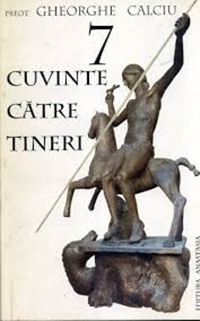

This eighty-eight-page manuscript contains the texts of eight sermons and seems to have been prepared to be sent abroad for publication. The author was a priest and professor at the Theological Institute in Bucharest, and was imprisoned between 1948 and 1964. While in the notorious prison of Pitești, he was forced to take part in the infamous re-education experiment in that prison, which turned a part of the prisoners into the torturers of the others. Tormented by such a terrible sin, Calciu-Dumitreasa tried, according to his own confession, to write about this prison experience in order to come to terms with it. However, he changed his priorities when, in the aftermath of the earthquake of 1977, the demolition of churches in Bucharest began while the hierarchy of the Romanian Orthodox Church kept quiet. It was then that Calciu-Dumitreasa conceived this series of non-conformist sermons, in which he argued against atheist education and reminded his students of fundamental Christian values, of their mission as priests who must build, and not destroy, churches in order to take care of their parish communities. Seven of the sermons were delivered by the author in the Radu Vodă Church in Bucharest between 8 March and 19 April 1978. Particularly important is the sermon of 15 March 1978, in which Calciu-Dumitreasa explicitly condemned the demolition of the Enei Church, the first church demolished in Bucharest. The sixth sermon, of 12 April 1978, was no longer delivered in the church but in front of it, for the authorities had closed the church and locked the students in their dormitories in order to impede them from attending what had turned in the meantime into an increasingly popular event. The eighth sermon was supposed to open a new cycle entitled “Christianity and Culture” on 17 May 1978, but it was never delivered due to the author’s removal from his teaching position. Continuously harassed by the secret police, in 1979 Calciu-Dumitreasa endorsed the establishment of the Free Trade Union of the Working People of Romania, which caused his arrest and imprisonment for another five years. He was released only in 1985, after intense international lobbying, especially by the United States administration, which threatened the Romanian communist regime with the withdrawal of Most Favoured Nation status. A year later, he went into exile in the United States, where he remained until his death. This manuscript was probably confiscated on the occasion of his arrest in 1979. This version of the sermons differs slightly from the post-communist published volume because it mentions the persons who were responsible for the interruption of his cycle of sermons in 1978.
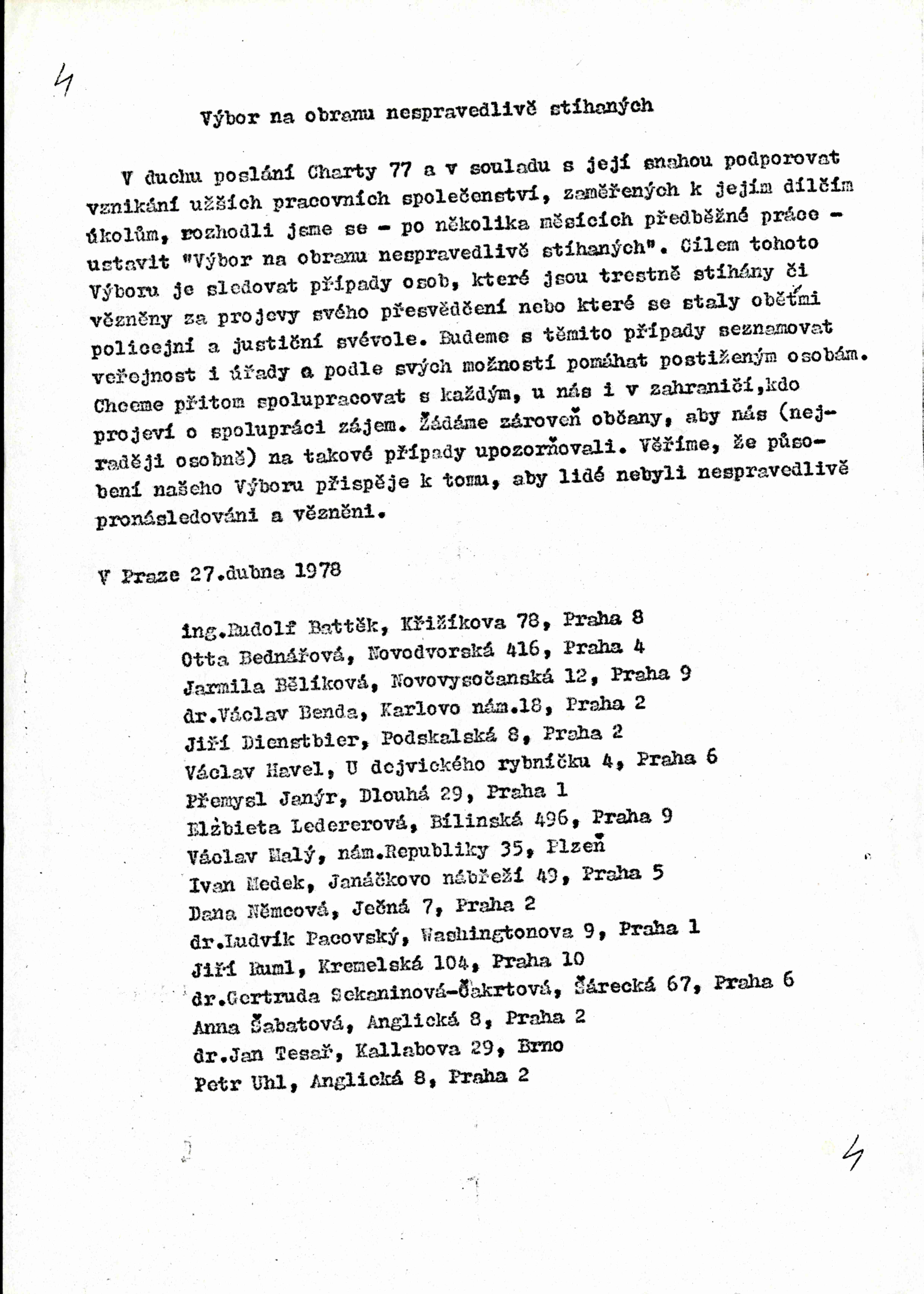

The founding statement of the Committee for the Defence of the Unjustly Prosecuted (VONS) of April 27th, 1978, signed by seventeen signatories on the Charter 77, who posted their addresses so that people could find them. VONS's goal was to track the cases of people who had been prosecuted or imprisoned for their opinions and beliefs or who had become victims of police and judicial arbitrariness. VONS, by means of numbered communications, familiarised the domestic and international public with these cases and asked the Czechoslovak authorities for remedy. They helped to provide legal representation and mediate financial assistance to the unjustly persecuted and imprisoned.
The impulse for the creation of VONS was, among other things, the events associated with the Railroad Ball in January 1978, in which the signatories of the Charter 77 wanted to attend to. However, three of them were detained by the state security. In support of them, the Defence Committee was formed by Václav Havel, Pavel Landovský and Jaroslav Kukal, who gathered documents for their defence and informed the Czech and foreign public about the whole case. The accusations were released after six weeks and the prosecution was halted. This was a great success for committee members and other dissidents, so VONS was founded in May 1978.
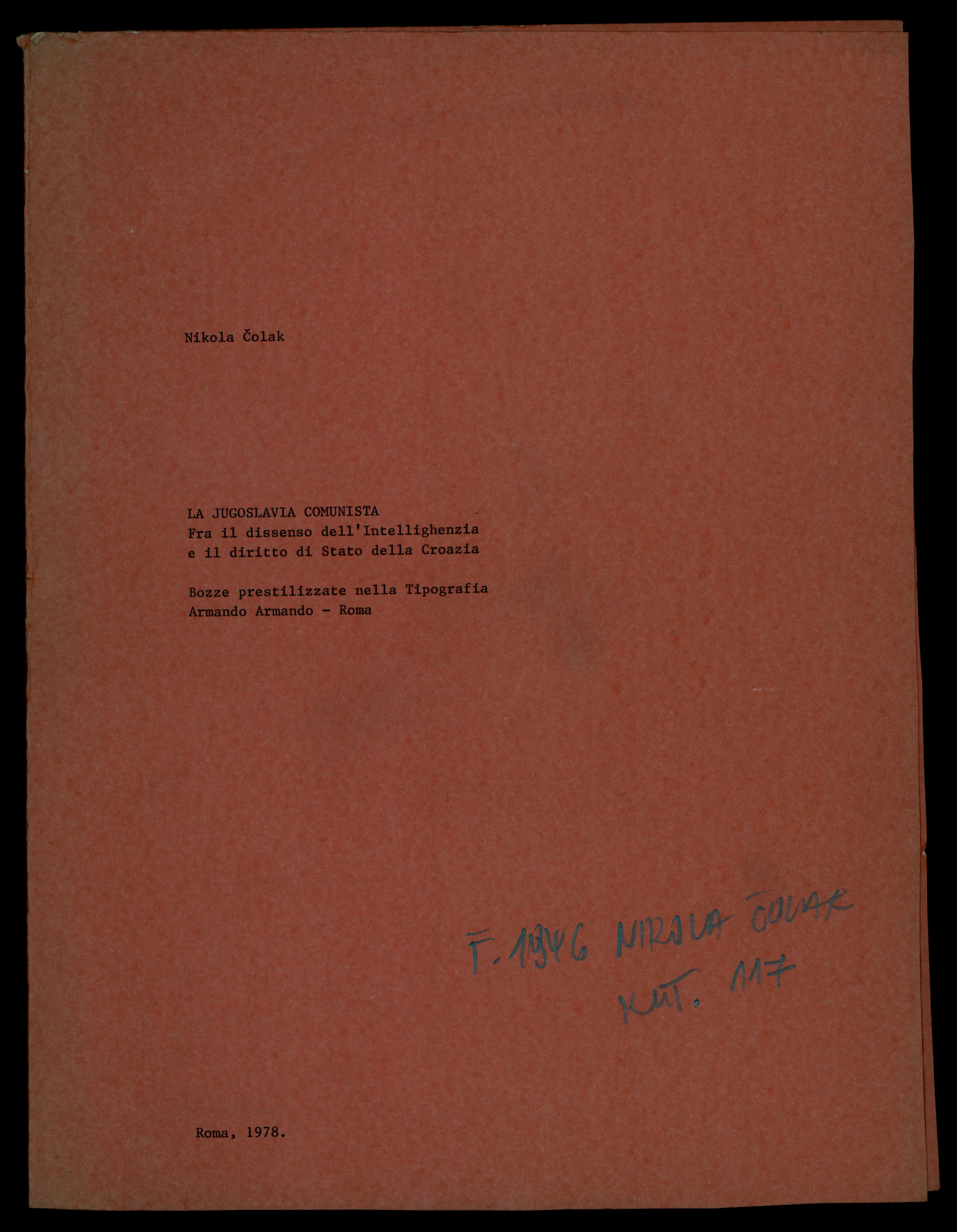

 Čolak, Nikola. Communist Yugoslavia: between the dissent of intellectuals and the state-right of Croatia, in Italian, 1978. Manuscript
Čolak, Nikola. Communist Yugoslavia: between the dissent of intellectuals and the state-right of Croatia, in Italian, 1978. Manuscript
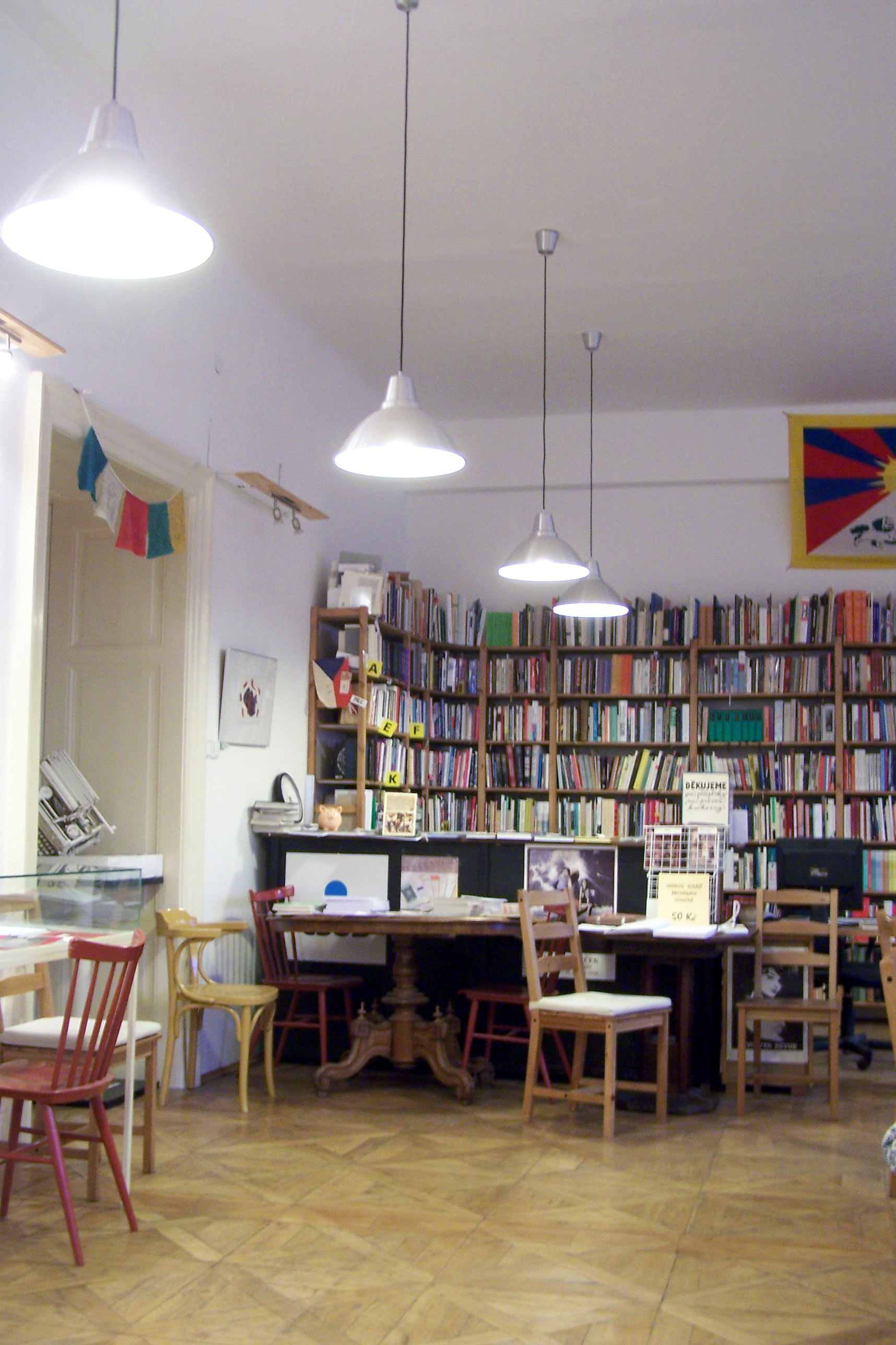
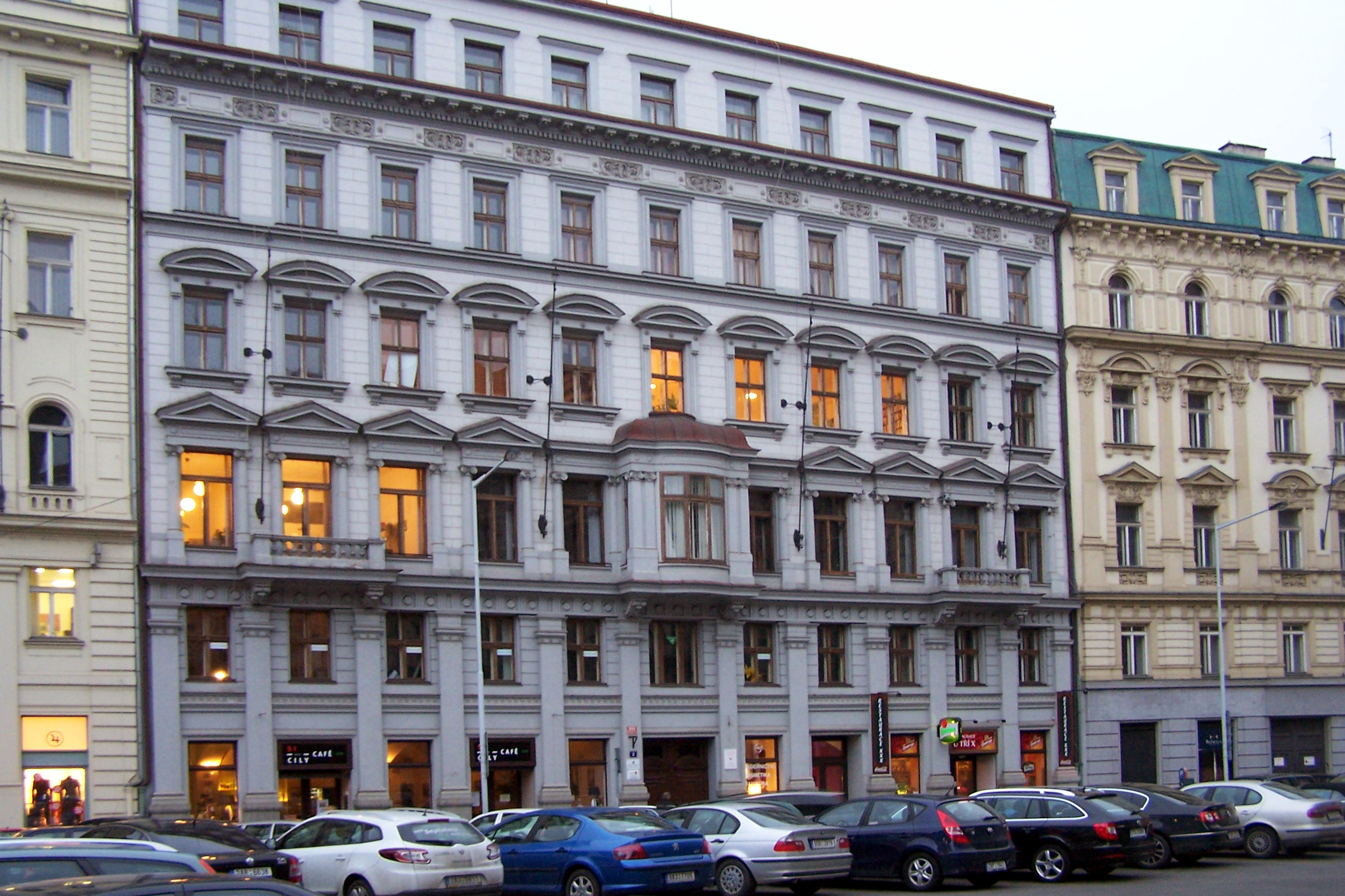


The Casual Passer-By Collection by the Bosnian-Herzegovinian conceptual artist Braco Dimitrijević consists of eight photographs and two posters (portraits) created in Zagreb and Belgrade in 1971. The photographs and posters (portraits) were the foundation of his three performances from the "Casual Passer-by" series staged in Yugoslavia. They were subversive performances in which the author hung portraits of chance passers-by in public spaces, otherwise intended for executives, in this way questioning established forms of communication in the public space of a socialist state.
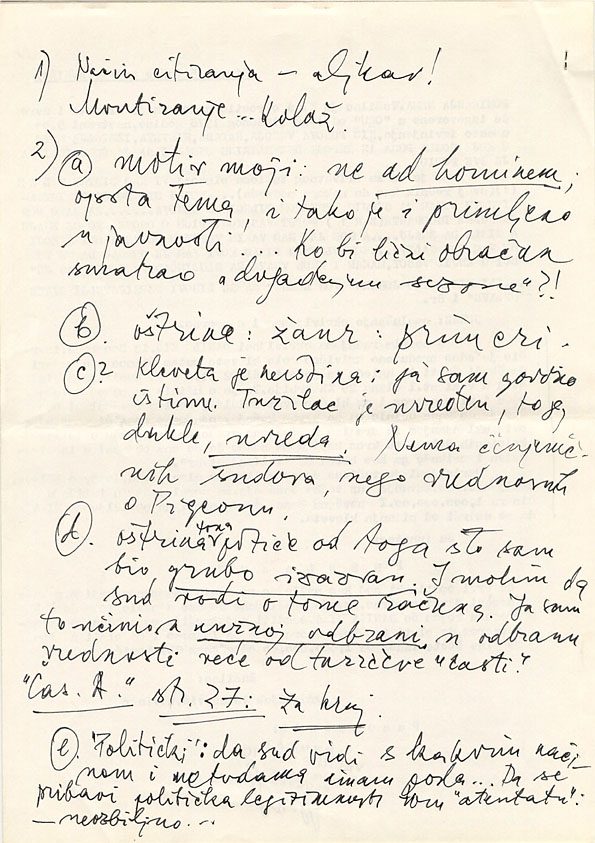

The court documentation in the collection shows that Kiš defended himself by explaining that his book was created as a gesture of a "legitimate and necessary defense, as a value greater than the prosecutor's honor: [a gesture] of my literary existence and my literary approach, as well as generally, as a fundamental defense against fatal and destructive judgements of a layman". In court, Kiš took the view that he was a writer and had the right to defend himself, using literature, against unfounded attacks on his work.
In a written statement delivered to the court, Kiš wrote: "The particular polemic sharpness of my book was, in addition, dictated not only by rough challenge and polemic fervour, but also by the literary genre itself: traditionally, polemic uses irony, sarcasm, ridicule, because it is a form of literary struggle." Kiš claimed further that polemics is a category of literature which an author can legitimately use and cannot be subject to claims of defamation. He listed a series of polemic writers and literature to try to defend his right to artistic expression. He also advocated for the view that literary controversy is actually a kind of public debate and is subject only to public judgment and literary history, not to be interfered with by the court.
In the end, the court accepted Kiš’s view, and acquitted him of the three counts of defamation. The court ruled that Kiš's response to Golubović in The Anatomy Lesson represents a "personal and subjective view to the prosecutor's conduct, and that this does not amount to facts serving to prove the truth, and thus it cannot be accepted as a charge for defamation.” The court also called for observing the broader context in which the book was created, which was in Kiš’s favour. However in 1979, after the lawsuit, Kiš left Yugoslavia embarrassed and disappointed.
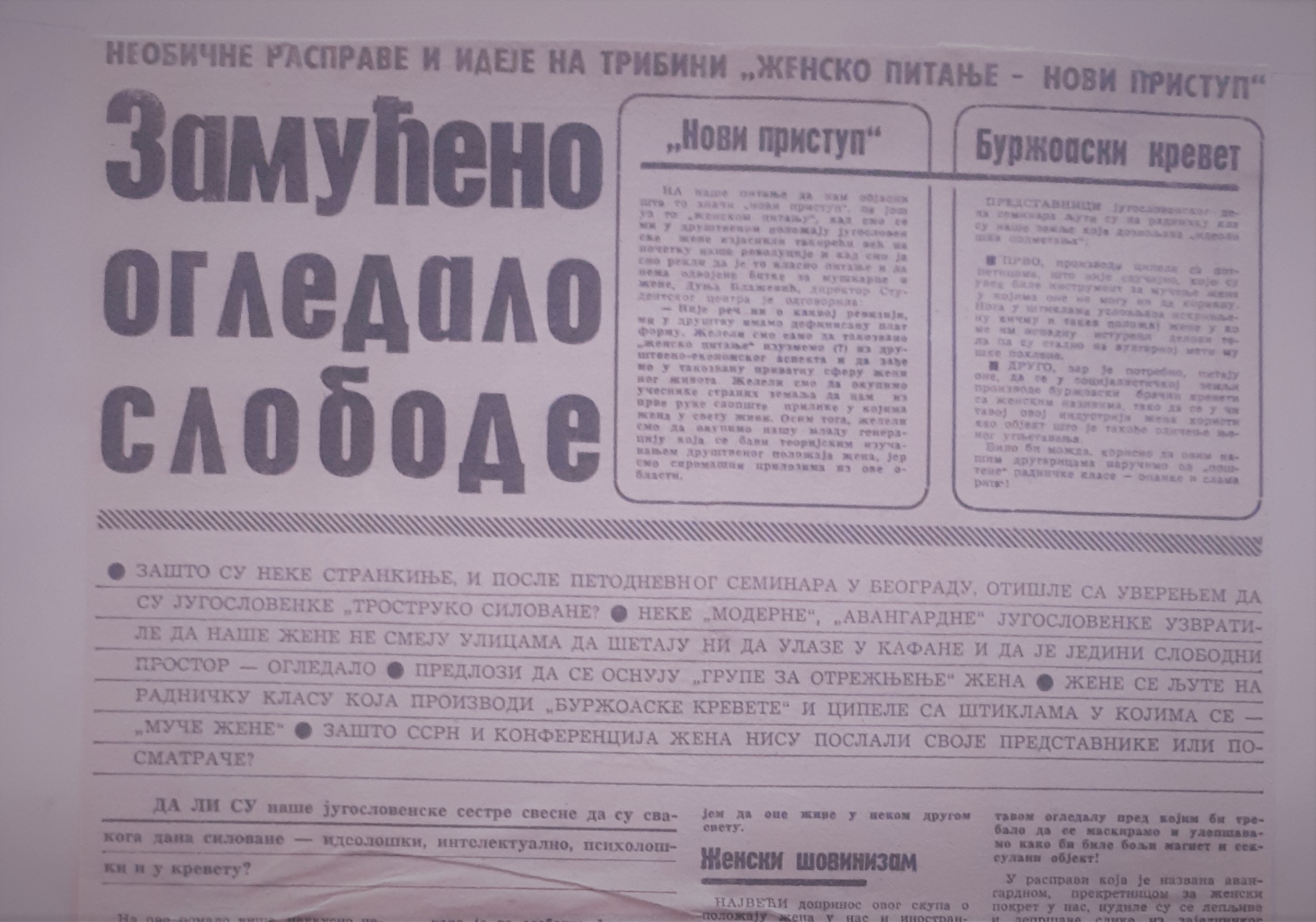

As an important part of the collection, we note the files on the first feminist conference 'Comrade Women', which was interpreted as an attack on socialist values and which caused great media controversy and led to verbal attacks on its participants.
The conference 'Comrade Women' was the first feminist conference in Eastern Europe and took place at SKC from October 27 to November 1 in 1978. It was in fact an international symposium on which theoreticians from different countries participated. The material from this symposium is kept in the archive called “Women's Question - A New Approach”, forming a 200-page publication. In addition, it is possible to follow the reactions of the Yugoslav print media in the press clipping collection, in which the views expressed at this conference were subject to criticism from different viewpoints. Their initiative was characterized as subversive or with the lowest terms "as a leftover childhood disease" http://www.republika.co.rs/550-551/17.html
The main scandal aroused in an article of “Evening News” [Večernje novosti] (6 November 1978) under the title "Blurred mirror of freedom" in which a critical review of this gathering was presented. The authors of the text referred to a provocative question from one of the participants at the very beginning: "Are our Yugoslav sisters aware that they are raped every day - ideologically, intellectually, psychologically and in bed?" No less controversial questions were: Is it possible in Yugoslavia to establish groups for self-awareness of women in factories, universities, to form women's courses and departments? Is it possible to establish feminist papers that will not oppress women's rights, instructing them on how to become and remain a beautiful and good wife? Is it possible to prevent the exploitation of sex with which Yugoslavs are flooded on TV and print? All of this was too much for contemporary society, and it was interpreted as an attack on the Yugoslav social system and the freedoms it gave to women.
In "Večernje novosti”, the journalists insisted that the participants did not respond to the fact how “the free Yugoslav Woman in the constitution and laws, and in life, was enslaved.” The statements of Yugoslav participants, as well as attitudes towards Yugoslav society and the position of women in it were criticized. Particularly problematic was the statement of Rada Ivekovic, who said that "in Yugoslavia, women cannot move freely, without being exposed to maltreatment of men who throw themselves on them! Women could not enter the tavern alone without being targeted by male voracity! We're locked in the walls of our homes. The only place in this society reserved for us is in a shining mirror, in front of which we should mask and beautify ourselves to make us a better magnet as a sexual object!"
The way "Večernje novosti” interpreted this was paradigmatic. The journalists of this newspaper wrote that statements like this were the result of "unfulfilled self-management at home of some of our comrades". Had it not had an international character, the whole conference would be characterized as "casual chatting over coffee" and "idle lamenting". Problematically assessed was also the statement of the chairperson Žarana Papić, who said that the Yugoslav feminists will not work together with the [party-driven] Conference on Social Activity of Women. "They could actually do something, not just keep preaching" were the words of Papić, for which she was resented.
"Večernje novosti" continued with attacks in their following issues. The text "Equality depends on woman" was asking whether "our society needed groups for sobering women in factories and universities" and “what kind of suggestions were made at this gathering? […] they are unable to accept the constitutions and laws that offered freedom to them. Why are women angry at the working class that produces ‘bourgeois beds’ and shoes with tights in which ‘women are being tortured”. The reactions of the readers who defended Yugoslav society were published too, like for instance: "I’ve had much in life, as much as I’ve managed to get through. I appreciate the free choice and all the opportunities that have been provided for me in this society." (Večernje novosti, November 12 1978). One female reader wondered why at that gathering "there were no workers, housewives, clerks, or were they all bigoted to understand some absurd feminist calls and recipes for a happy life?" The actress Vera Čukić praised Yugoslav society and development with the words "we have built large and modern cities all these years, but we should not forget what is very important, that we built even more modern constructions - in people."
In the issue dated 13 November 1978, the text of Dunja Blažević, the director of the SKC, was published, which strongly criticized the text "Blurred mirror of freedom", denying the allegations and explaining that the goal of the gathering was to promote the idea of a "new approach" to the female issue. That meant that it should be excluded from its socio-economic context. Regarding the complaint that the ‘Conference on Social Activity of Women’ and the SSRNJ (Socijalistički savez radnog naroda Jugoslavije - Socialist Alliance of Working People of Yugoslavia) did not participate, Blažević wrote that she believes that it would be "inappropriate for common sense and socialist self-justification that socio-political organizations are behind the initiatives and actions of cultural institutions."
However, already in the next sentence she notes that the nature of the gathering did not prevent the participants from "affirming the attitudes of our socio-political organizations." She particularly disapproved the criticism towards domestic participants who were considered to be incompetent.
The attacks continued - in one of the following issues, one of the articles was titled "New Approach – To What?" [Novi pristup – čemu?]. This article specifically rebuffed that the feminists were "inadequately clearly demarcating the essential differences between women in capitalist countries and the socio-economic position of a Yugoslav woman who had, long ago, on the normative level, achieved what most of these movements are still struggling for (equal pay for equal work, the decisive word in family planning, etc.).”Under the title „písačky“ (scribbles) Slovak writer Dominik Tatarka generally described his texts from the so-called Normalization period. Milan Šimečka commented that the word “písačky” contained “deep sorrow of a writer who had been writing in solitude and isolation, without the hope that his manuscripts would be ever a published book, printed, bound and read.” More specifically, “písačky” refers to texts collected in his later book “Písačky pre milovanú Lutéciu” that were created between 1976 and 1978 and were designed as love letters of an older writer to his young lover to Paris. Under the title “Písačky” some texts were published in 1979 already in the samizdat Petlice Edition by Ludvík Vaculík. Miroslav Kusý published about 50 copies of “Písačky” by samizdat in Bratislava but Slovak readers were said to show little interest because they perceived these texts as pornographic. Part of this samizdat edition by Kusý was confiscated by the State Security during one of house searches. In 1984, “Písačky” were published in exile by historian Ján Mlynárik in the Index Publishing House in Cologne. On 23 September 1986, Dominik Tatarka was awarded the Jaroslav Seifert Prize for “Písačky” by the Charter 77 Foundation in Stockholm. The Jaroslav Seifert Prize Committee consisting of Jiří Gruša, Milan Kundera, Antonín J. Liehm, Sylvie Richterová, Josef Škvorecký, Jan Vladislav, František Janouch and “in pectore” Ludvík Vaculík and Václav Havel, appreciated on these works by Tatarka that they “newly developed a genre of human monologue” and also “a bold testimony about a time and so far not reached depths of human mind”. Tatarka learned that he was awarded the prize from the Voice of America broadcasting on the very day. “Písačky” were officially published after 1989 in an edition by Ján Mlynárik (1998, together with “Letters to Eternity” and “Alone against the Night”) and by Oleg Tatarka as “Písačky pre milovanú Lutéciu” (1999, 2003, 2013).


Punk in Polish People's Republic began in 1978 and it quickly gained popularity in Warsaw, as well as in other cities. In its initial phase, the movement maintained close ties with student clubs and galleries, where performance art, mail art, and concrete poetry flourished at the time. The collection of a punk photographer Anna Dąbrowska-Lyons includes zines, photographs, and newspaper clippings from the years 1978 to ca. 1982. The most interesting of these materials were featured in the album titled Polski punk (Polish Punk) published in 1999. The album documents the first wave of punk in Warsaw, while also presenting original, artistic photographs, collages, and graphics which blend the Western influence of punk and the new wave with the poetry of futurism, Dada, and conceptual theories of the 1970s.
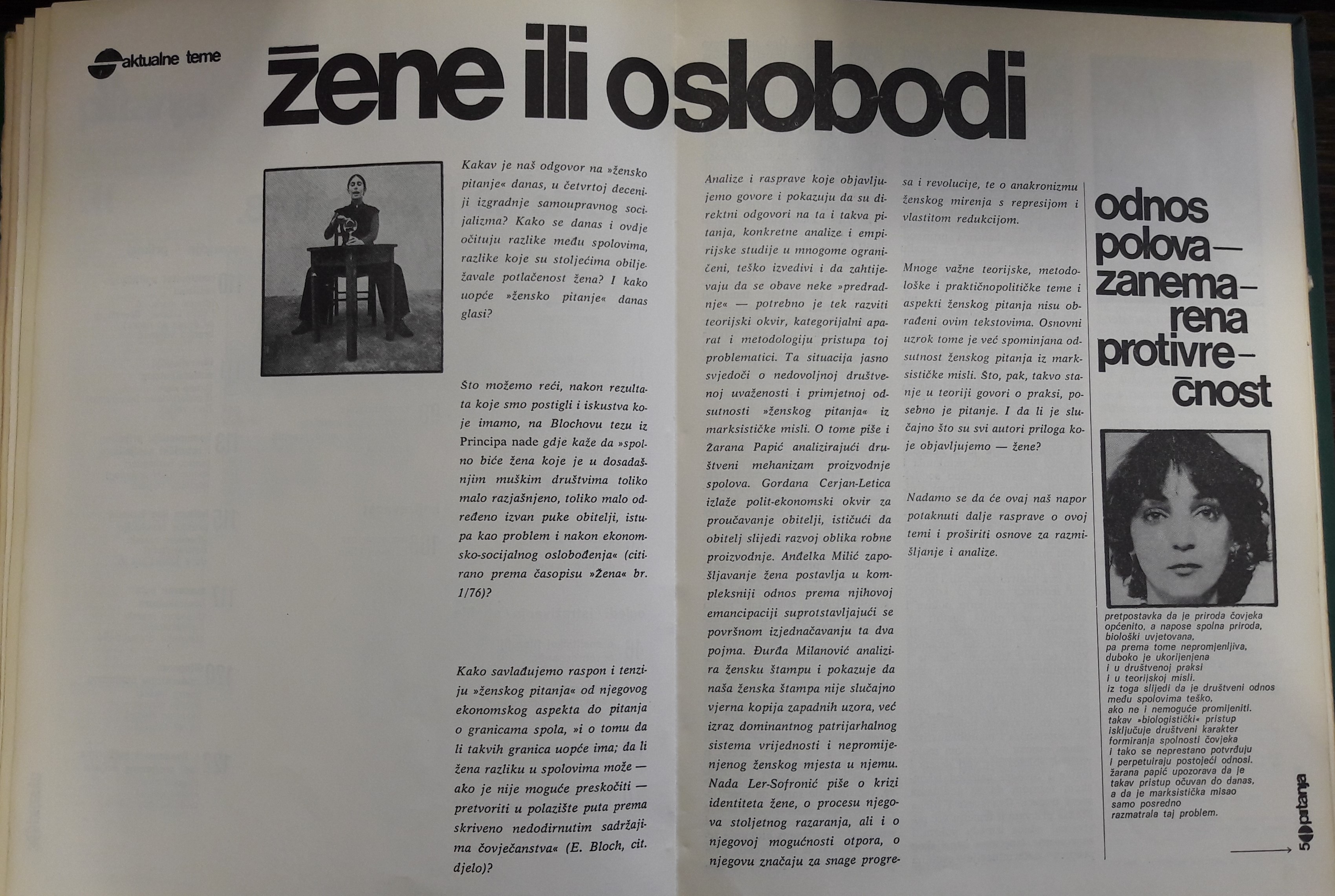

In 1978, Lydia Sklevicky edited the "Current Topic" section in the journal Pitanja (year 10 (1978), no. 7/8) and entitled it "Women, or about Freedom." Sklevicky wrote an introduction to the issue's topic in which one of the questions the articles should answer was: What is our response to the "women’s question" today, in the fourth decade of self-management socialism? Later in the text, she gave a partial answer to this question, and also a critique of Yugoslav socialism, claiming that there is no developed theoretical framework in Yugoslavia, nor a categorical apparatus and methodology for approach that would allow researchers to deal with this question, and she concluded that: "This situation clearly demonstrates inadequate social respect and the noticeable absence of the "women’s question" in Marxist thought (Sklevicky 1978, 4).
Besides Sklevicky, who edited the issues topic and wrote an introduction to it, articles were published by Žarana Papić ("Gender Relations - Neglected Discrepancy"), Nada Ler-Sofronić ("The Odyssey of Women's Human Identity"), Gordana Cerjan-Letica (“Indications of the Socialist Mercantile Production of the Family“), Anđelka Milić ("Employment of Women and Their Emancipation") and Đurđa Milanović ("Women's Press – the Industry of Happiness").
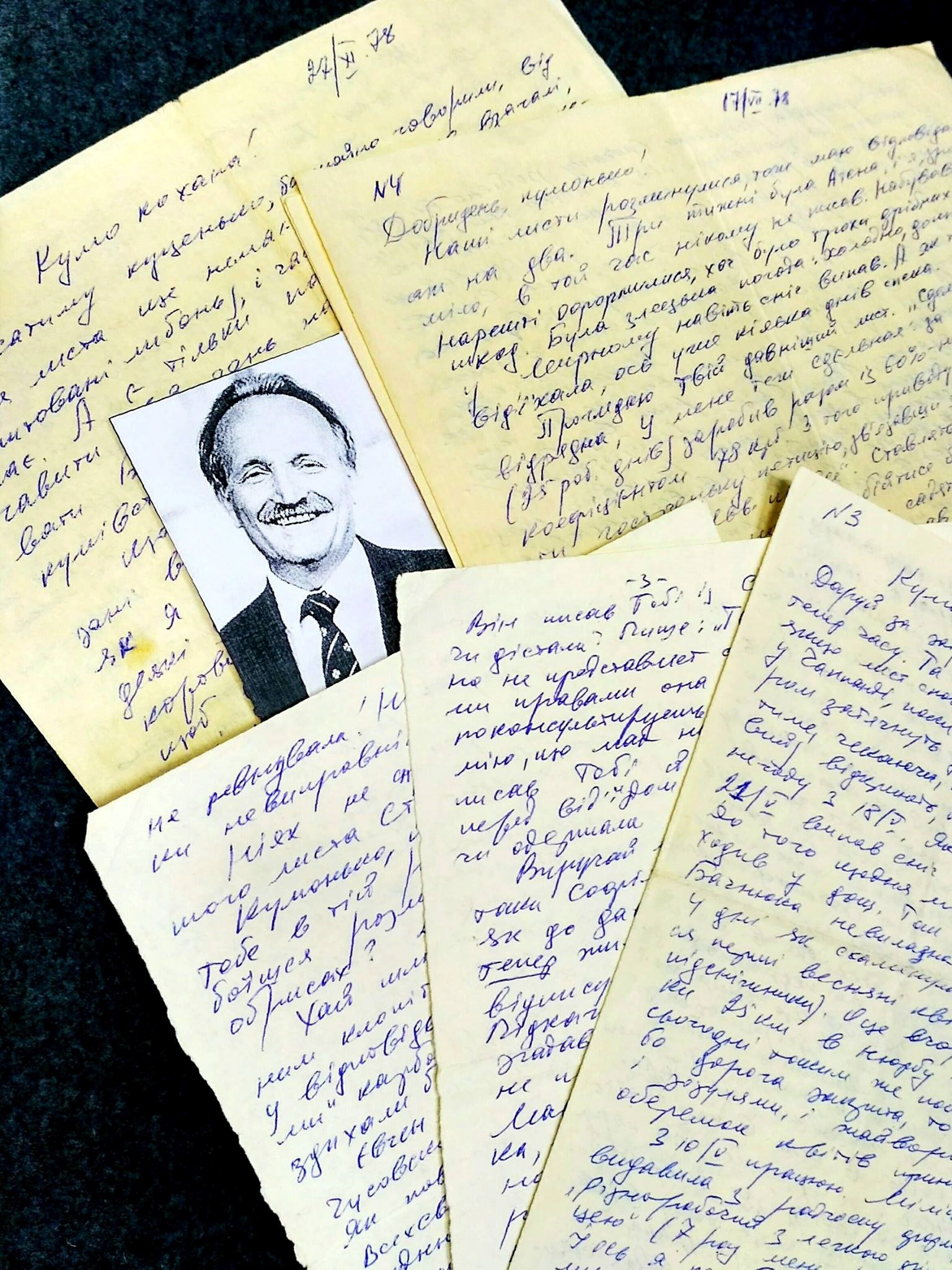

Viacheslav Chornovil’s three letters sent to Iryna Stasiv-Kalynets in 1978 were donated to the museum-memorial along with much of her correspondence from her time in exile in the Chytynsk region of Siberia, in a village not far from the Chinese border. These letters penned by her close friend, fellow dissident and journalist Chornovil, while he served out his own lengthy sentence in Yakutia, are particularly illuminating about the conditions in which they lived. Curators of the collection note that this is a unique item, as its vibrant and accessible language brings to life Chornovil’s experiences in the camps, and later in exile, the changing circumstances of his day-to-day life, and ongoing discussions over the legality of the work regimen with correspondents. He and Stasiv-Kalynets also discussed Chornovil’s concerns over the agendas of likely well meaning, but unknown parties from the Ukrainian diaspora in North America. This was most probably tied to the fact that one such person, Yaroslav Dobosh, a member of a nationalist youth organization, came to Ukraine from Belgium to meet with dissidents, triggering one of the gravest campaigns of surveillance and arrests against Ukrainian dissidents—called Operation Bloc. These three letters chart a year in the life of political prisoners in internal exile in the Soviet Union and once translated and published are expected to provide a unique and illuminating window into this world for researchers, students and the general public.
This badge was used by the Northern Region of the Estonian Student Building Brigade (ESBB) in 1978. The rather modest badge has a star in the middle, which is remarkably similar to the Nato symbol. Although it is not known whether this was a conscious choice or not, it is unlikely that the designers of the badge did not know what the Nato symbol looked like. Unfortunately, the collection does not contain the emblem of the Euromais group from 1982, which was deliberately based on the Nato symbol. Both badges passed the censors without any problem. These cases show how members of the ESBB balanced on the borders, and did so most of the time successfully.


The Charter 77 Foundation was founded in Stockholm in 1978 to support persecuted and imprisoned chartists and dissidents in Czechoslovakia, as well as to support opposition activities in the fight for human rights and civil liberties. The Charter 77 Foundation was led and organised by Frantisek Janouch.
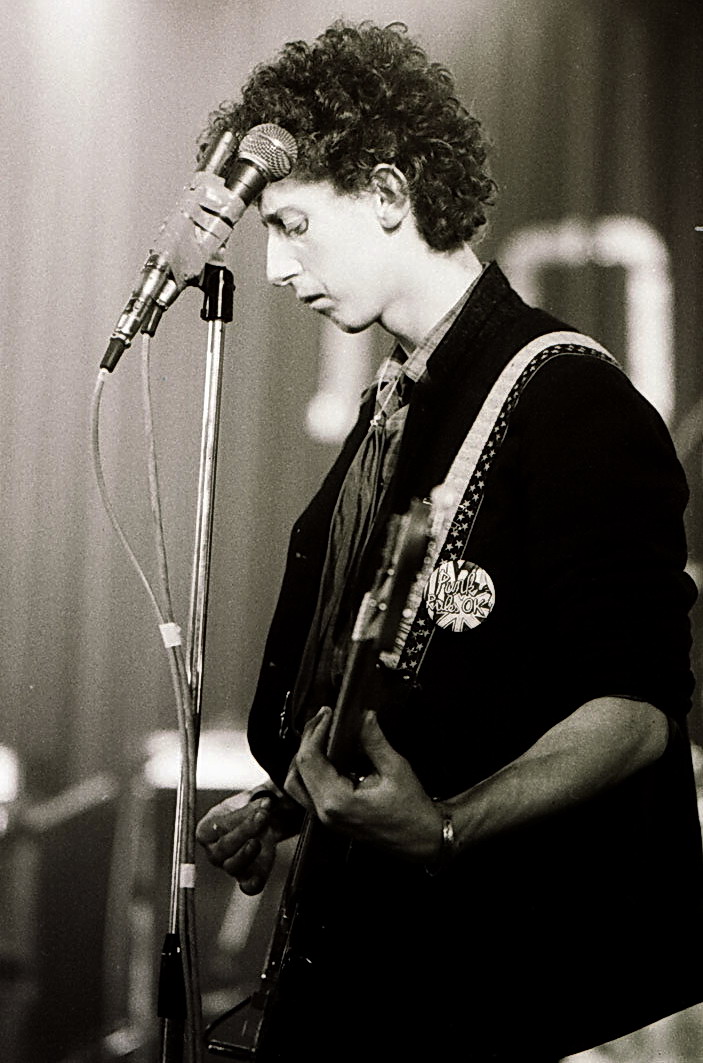

The BOOM festival in Novi Sad was held in November 1978. Performances were held by the new wave bands Paraf, Prljavo kazalište, Pekinška patka, Zvuk ulice (the forerunner of Idoli) and Aerodrom. Prljavo kazalište was then considered to be the group that had the greatest potential to break to the top of the music scene, which was confirmed by the release of their first album in 1979, Prljavo kazalište. It was this album that marked the beginning of the new wave. Their first studio album, due to its punk style and heavily social themes, led to a boycott by state media in the socialist society of the time.
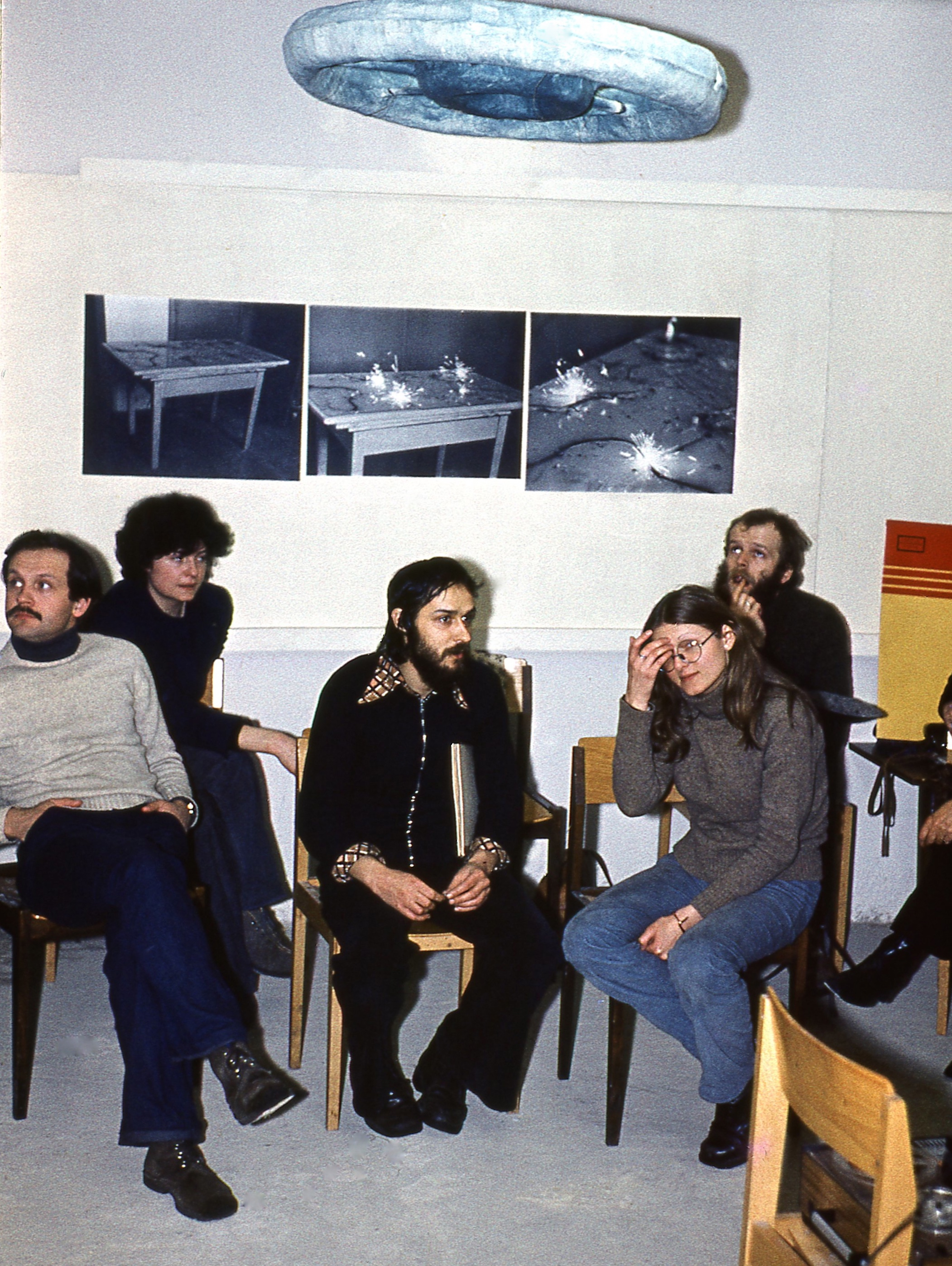

The photography took by Tomasz Sikorski presented the space of the exhibition Forma i dźwięk (Form and Sound). The exhibition was displayed at the Mospan Gallery from March 20 to 25, 1978. On the photo, one could see, among others, Dorota Mroczko and Paweł Kwiek. The exposition gathered works made by the students from the sculpture workshop carried on by the professor Jerzy Jarnuszkiewicz at the Fine Arts Academy in Warsaw. The pieces presented at the exhibition were made by Krzysztof Bednarski, Hanna Roszkiewicz, Marek Sarełło, Tomasz Sikorski, Roman Woźniak and Jacek Malicki, musician, writer, philosopher who actually was not Jarnuszkiewicz’s student. The question of relations between spatial form and sound may sound strange in the context of the sculpture workshop. That was the avant-garde musician and composer Andrzej Bieżan who induced students to take up such a topic. The effects of the cooperation between Bieżan and students of sculpture were showed at the Mospan Gallery.
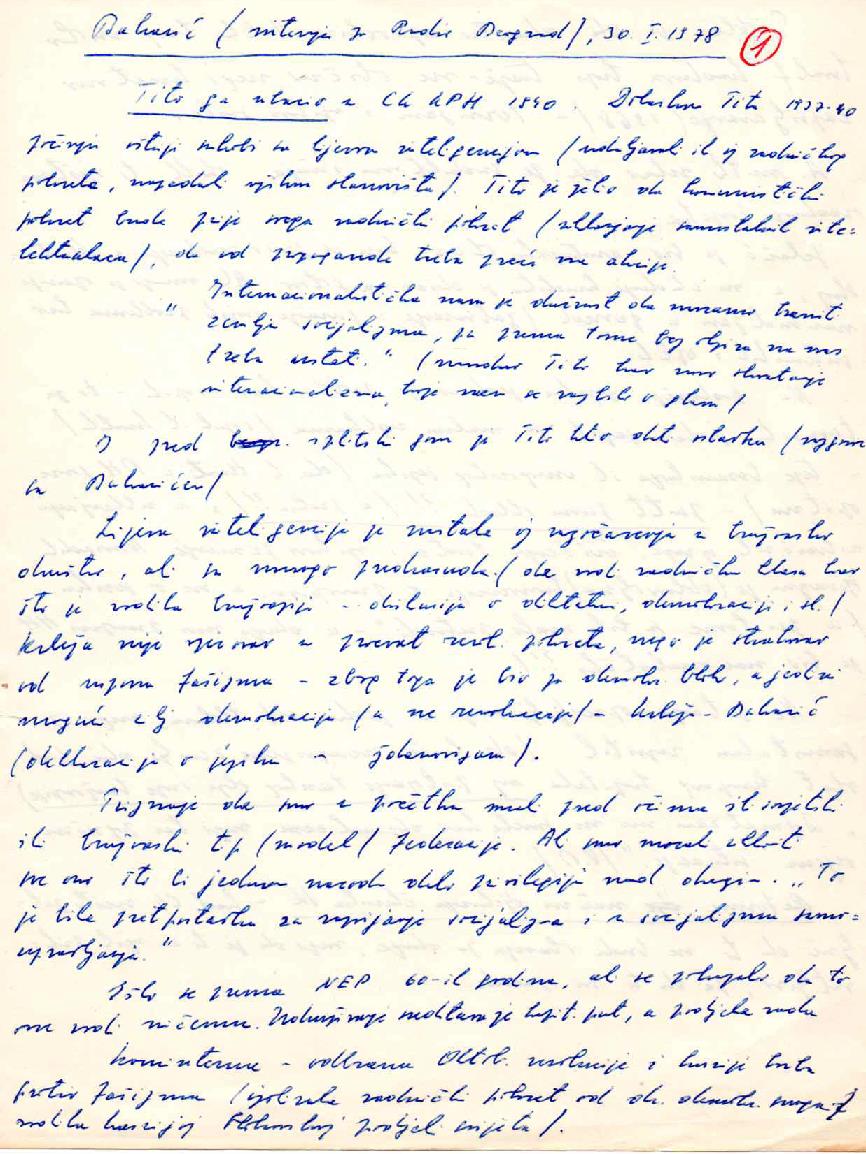
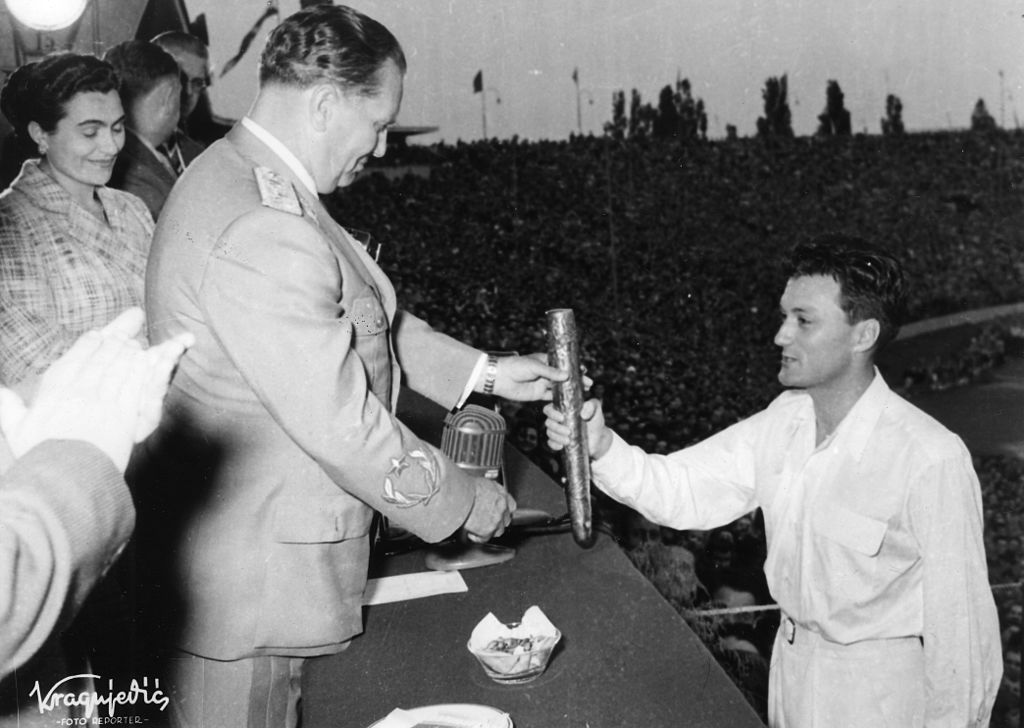


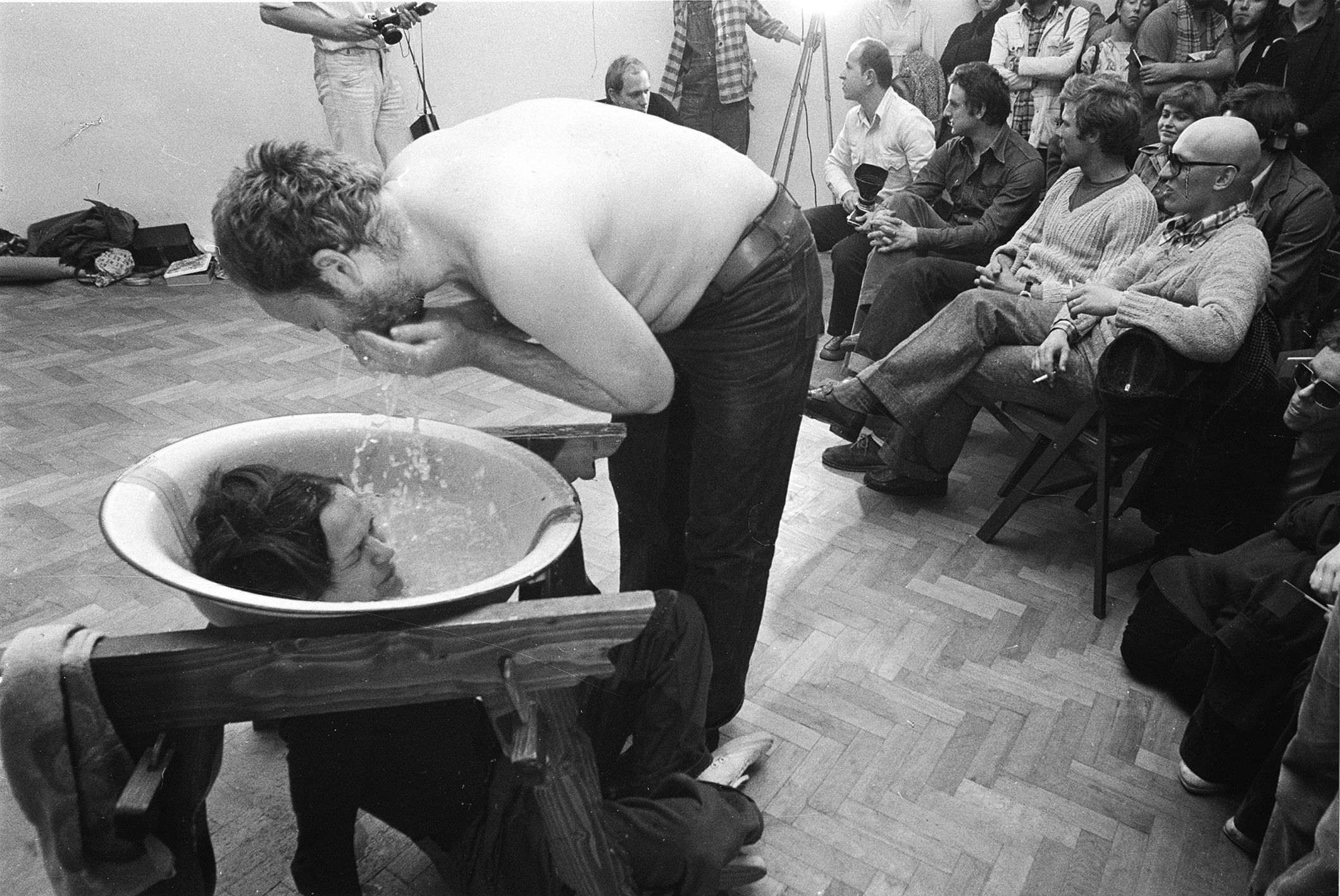

“In the first part, before entering the hall, the audience was asked to stick small red pennants behind their ears. [...] As they were entering, they saw Kwiek and Kulik with their heads stuck in the seats of two chairs. In the second part, Kulik sat on the floor with her head sticking out of the bottom of a bowl. After pouring water into the bowl, Kwiek washed his face, took off his shirt, washed his armpits, and finally took off his shoes and socks, and washed his feet. After that, Kwiek poured more water, so that it covered Kulik’s mouth but not her nose, so she could breathe but could not speak. He then put a sharp tip of a knife against the back of her head and started to shout: “Say something, you whore, come on... you can’t, can you?!” In the third part the audience saw Kwiek and Kulik sitting on the chairs with bins on their heads (there were openings for their heads in the bottoms of the bins). As it was previously arranged, two artists (Janusz Bałdyga na Łukasz Szajna) proceeded to circle around the artists, tossing rubbish into the bins, which they had earlier taken out of a container in the corridor of the gallery.”The title of this performance was used as the title of a collective exhibition at the Museum of Modern Art in 2015, which present new phenomena in Polish art. The title was used as a general metaphor of “«procedures» for the viewer's head, but also works that use the mind as a tool to «calibrate» what is both visible and invisible around us.”The still frame with Kwiek washing his face above the bowl with the head of Kulik was also used for the cover of the monograph summarising the activities of the duo.
Źródła: KwieKulik. Zofia Kulik & Przemysław Kwiek, eds. Łukasz Ronduda, Georg Schöllhammer, Warsaw/Wrocław/Vienna 2012.
